Every year dozens of millions of people travel to the Italian city of Venice eager to see for themselves its world-famous beauty.
And while millions fall in love with the unique location, history, and architecture of Venice, many are also left a bit disappointed for they spend their time in the city on water battering the tourist crowds, sweltering under the blinding sun, and paying exorbitant prices.
Then, once they tick the main sights off their lists, they leave Venice behind not quite sure what to make of their experience. ‘It was beautiful but it was crowded,’ they think. ‘And everything was so expensive!’
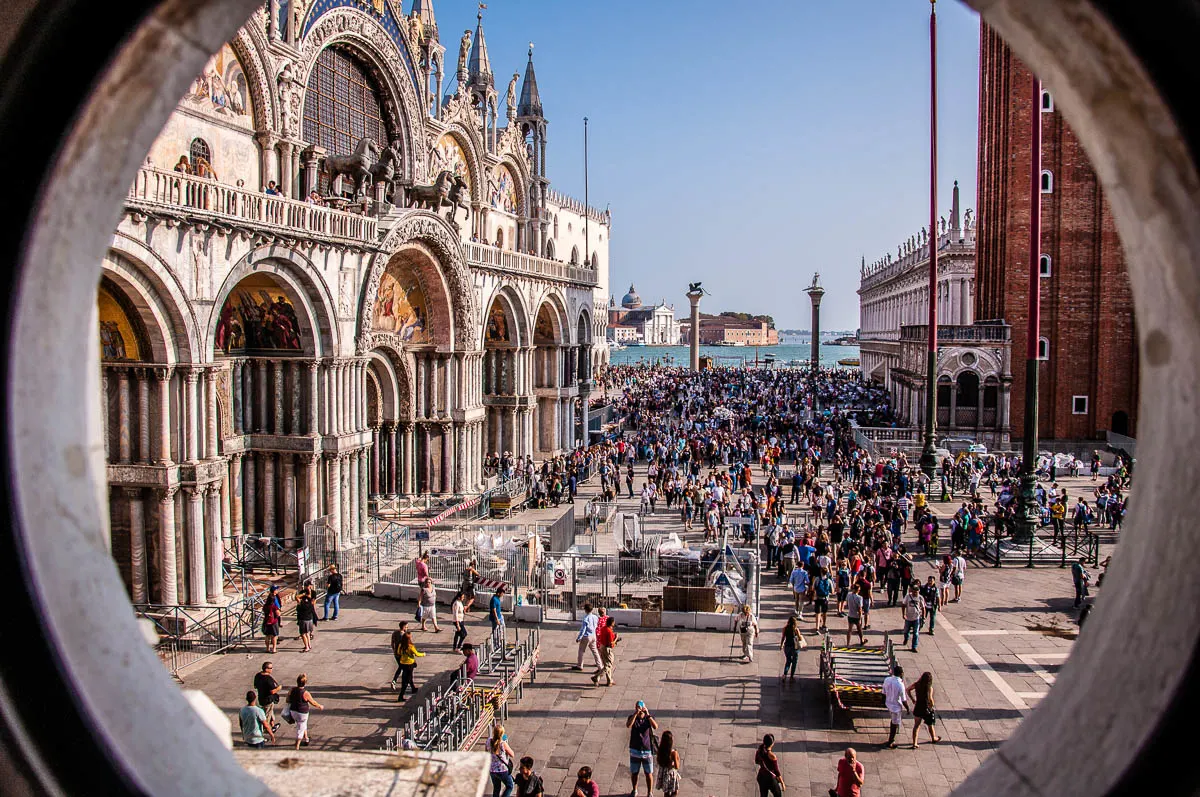
It needn’t be like this though. After all, Venice is a very special place to visit and explore. Every hour, every minute spent there is an opportunity for a new discovery. Every turn can take you to a place with a history that spans hundreds of years and every step opens views of singular beauty.
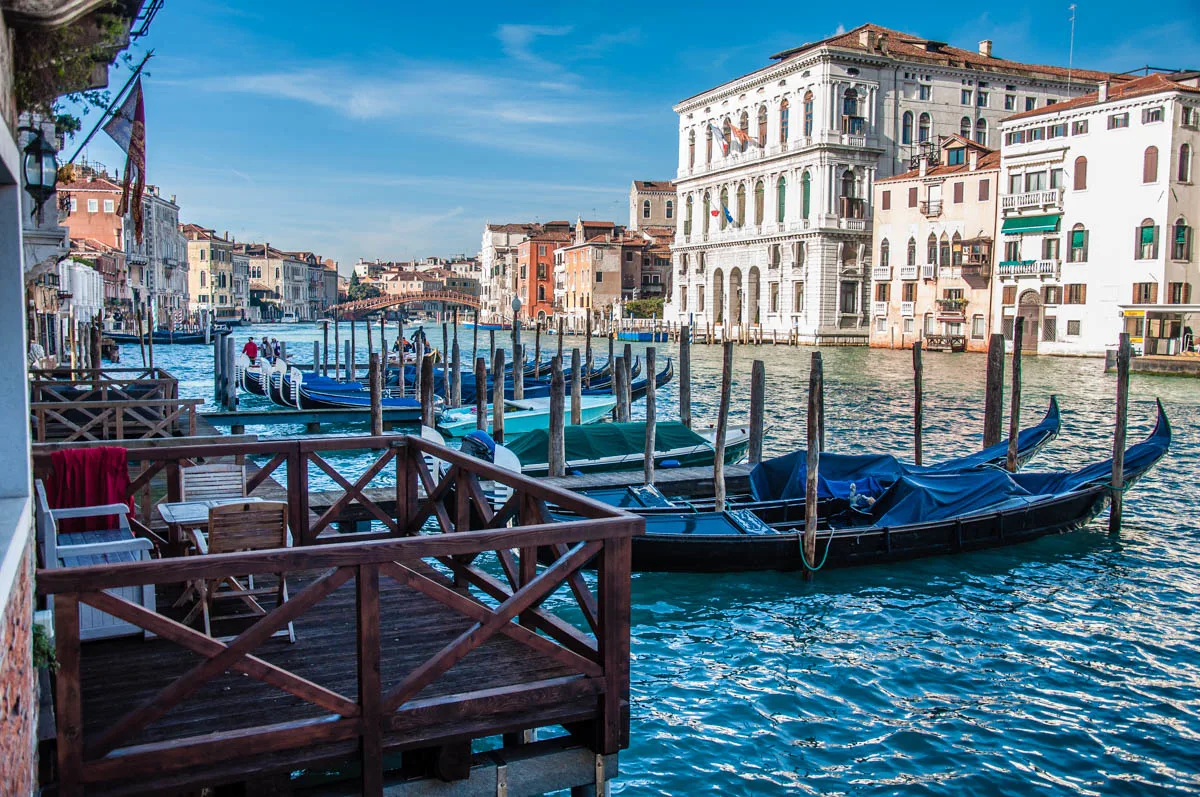
Through the centuries, Venice rose from barren marshlands to become a political, naval, and commercial powerhouse that controlled the Mediterranean trade routes and large swathes of land in what nowadays we define as northern Italy, Greece, and Cyprus. It supplied Europe with rare and expensive products like silk, sugar, and coffee.
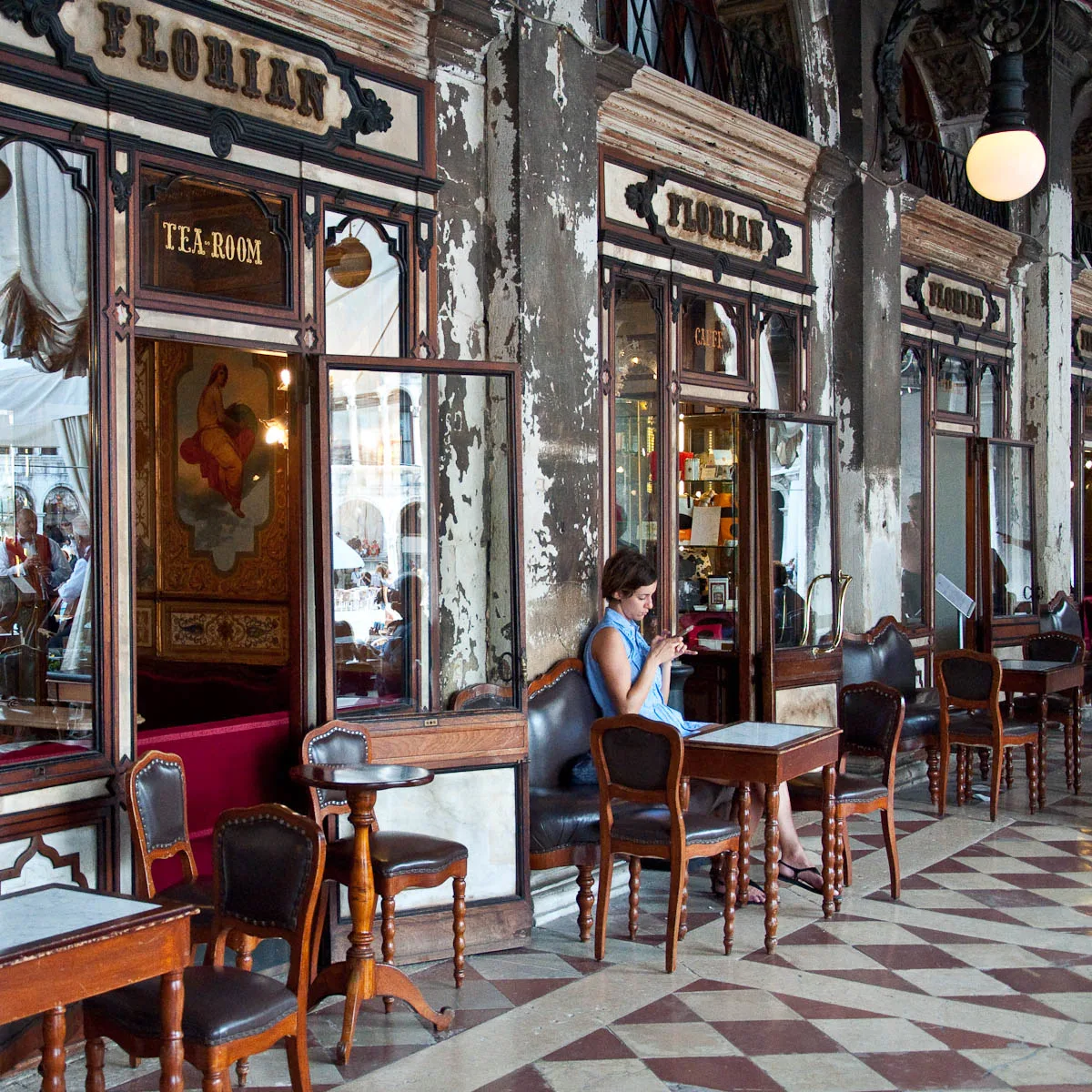
With the money that poured in and with its political and social acumen, Venice stimulated the developments of the arts, architecture, and engineering at unprecedented levels.
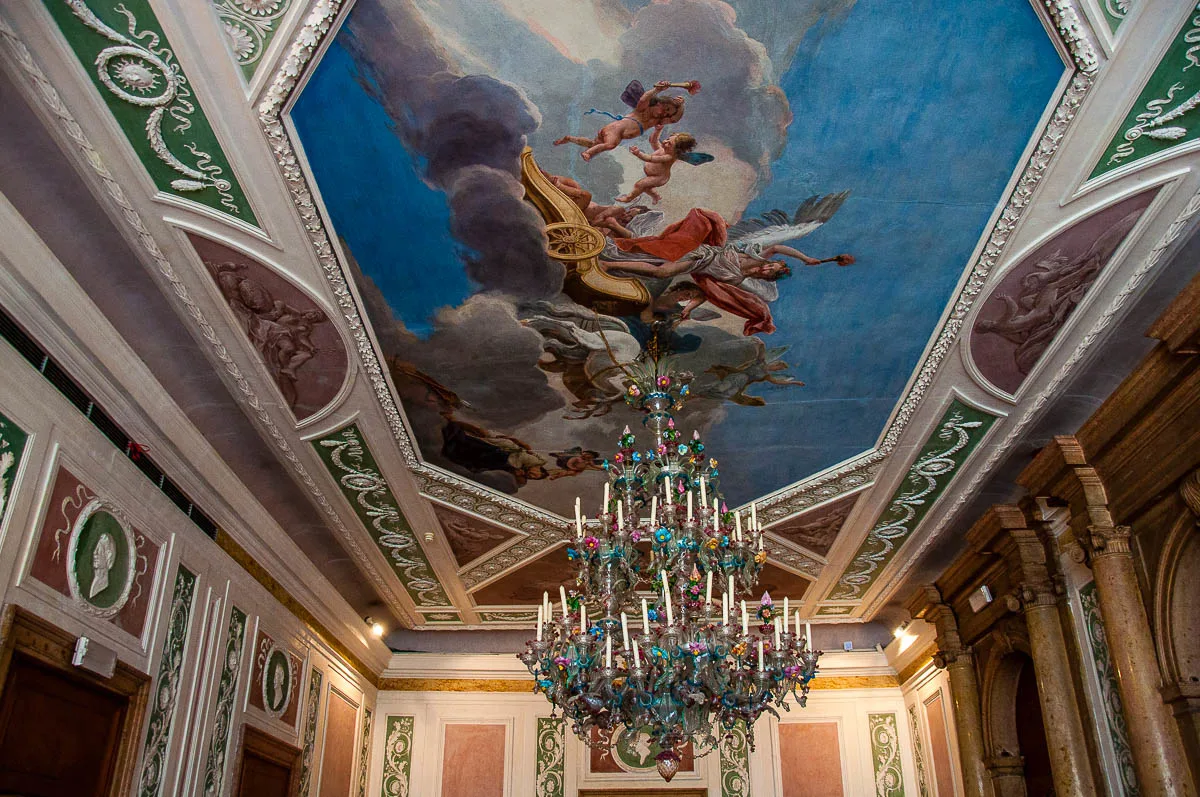
Today, the millions that flock to Venice each year are eager to see the fruits of Venice’s glorious past.
Built on islands and preserving beautiful buildings that seem to rise from the water, Venice is like a dream where each corner leads you down a new path of discovery and wonder.
At the same time, it’s so easy to fall into a rut when in Venice, to skim through a handful of famous buildings, and then to leave with hundreds of selfies of canals and bridges without having even scratched the surface of what Venice stands for.
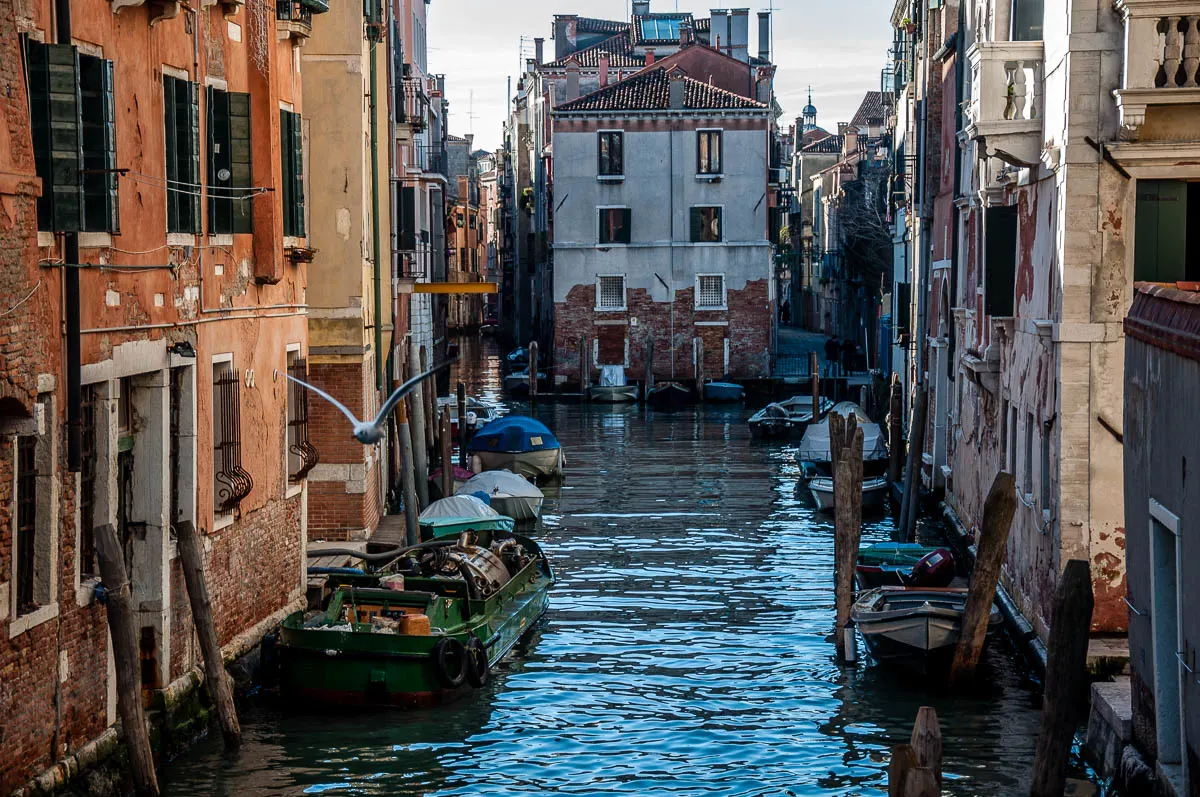
Venice seldom reveals her secrets easily. The city easily overwhelms you with its tourist crowds, souvenir shops, and a maze of narrow alleys. It’s then so easy to pass by dozens of hidden gems not even understanding how much you are missing.
Yet, if you are willing to spend just a little bit of time learning about Venice and its history, the city on water will throw its doors open to you. You will find an indescribable delight in unveiling little-known faces of the city with curious details and long-held secrets.

The aim of this blog post is just that. To give you a clear and exciting guide to 101 lesser-known and under the radar things to do and see in Venice, Italy. Some of them are hidden in plain sight and others are secret corners that you need to discover by walking away from the world-famous sights of the city on water.
Each of these 101 things opens your senses to a new, authentic experience able to make you appreciate Venice and what it stands for on a deeper level.
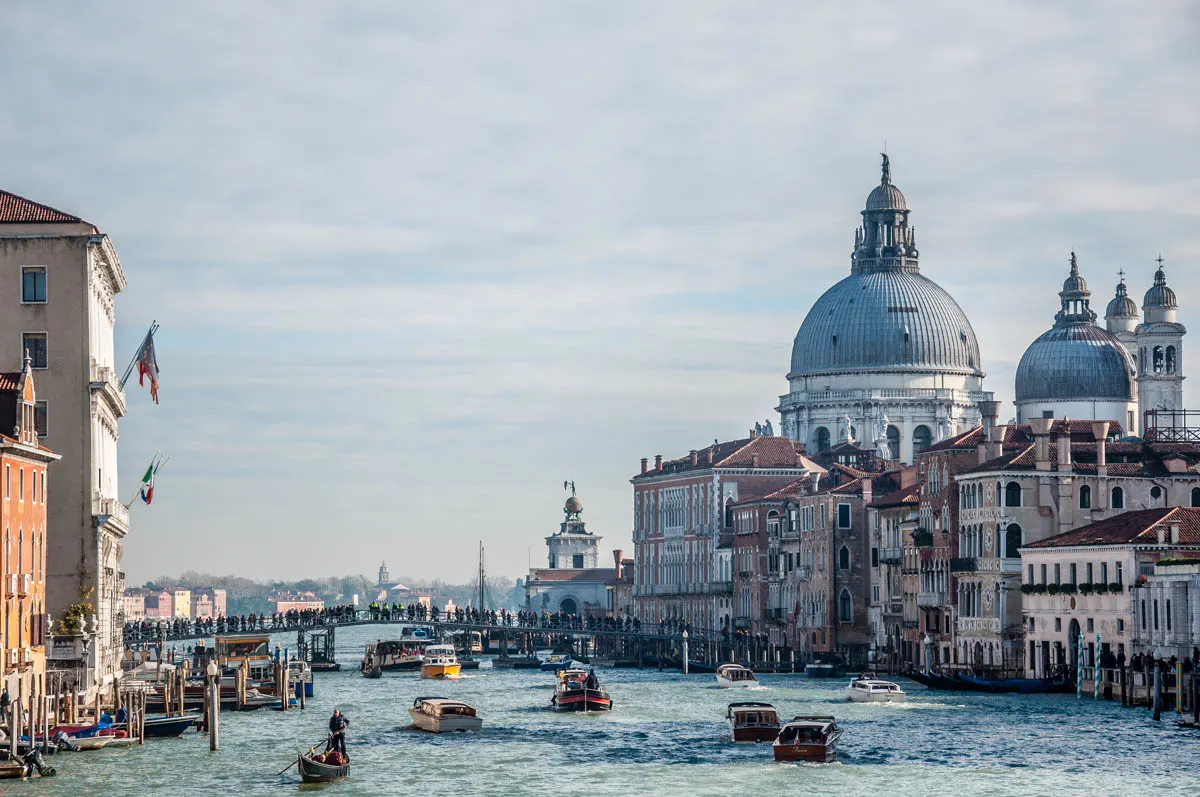
I have spent many happy hours walking around Venice and discovering for myself the beauty of this most unique city. Every hidden gem below has been a wonderful discovery for me, a place where I have spent enriching moments.
I hope that you will enjoy seeing these hidden gems, too. And I wish that the suggestions below will give you an intimate view of one of the most beautiful and intriguing cities in the world so that you can feel like a true Venice insider yourself.
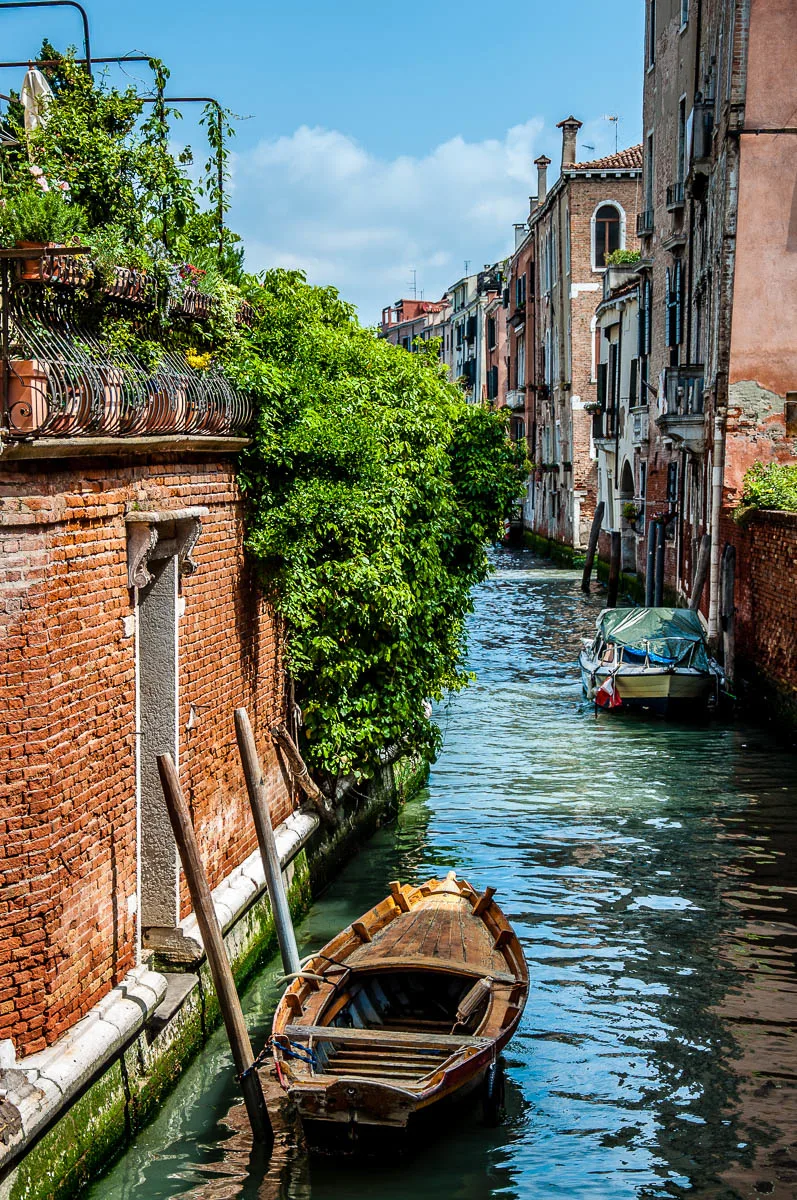
I have organised these 101 things to do in Venice off the beaten track in logical groups under the following headings: architecture; art & sculpture; bridges; churches, temples & religion; crafts & shopping; famous people; food & drinks; heritage & curiosities; museums & sights; music; spooky corners; water & watercraft; and finally, views. It’s all in alphabetical order to make it visually easy to follow.
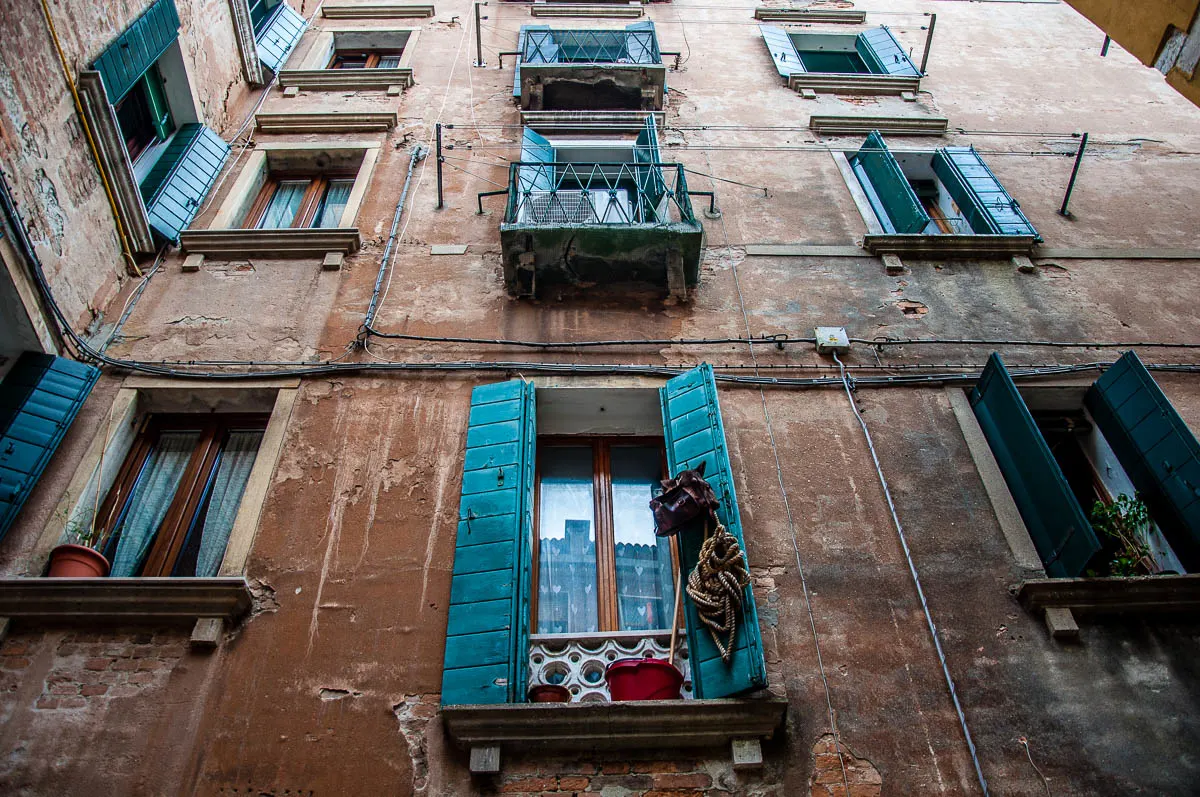
Just one final note before we start in earnest: I encourage you to discover your own hidden gems in Venice. To immerse yourself in the history and life of the city on water and see it with charmed eyes and delighted heart so that the cherished memories you take away stay with you for a very long time.
Now, let’s start! No-where else in the world pays more to get off the beaten track than in Venice.
Hidden Gems in Venice – 101 Things to Do in Venice, Italy Off The Beaten Track
ARCHITECTURE
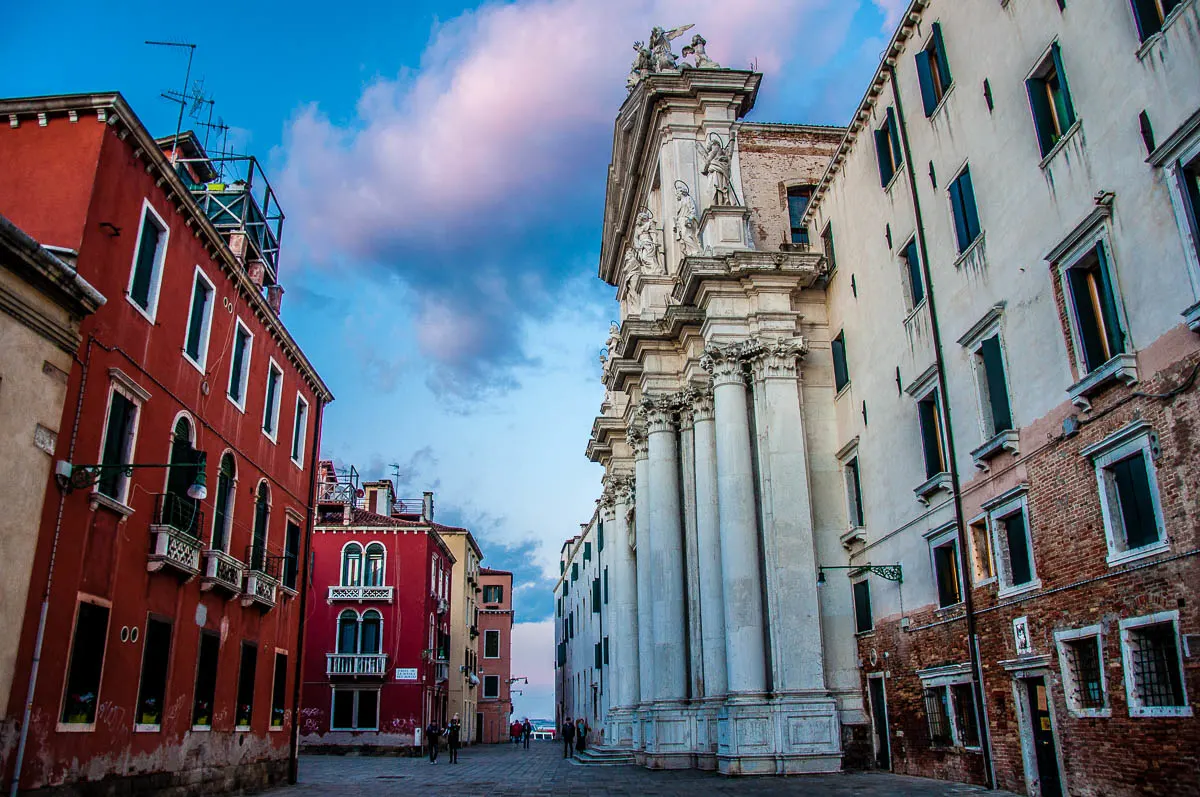
It’s Venice’s curious and beautiful architecture that attracts millions of people each year to the city on water. Rising from the Venetian Lagoon, there are lavish Gothic palaces, splendid churches with marble facades, and a truly iconic urban plan that has been inspiring writers, travellers, and film-makers for centuries.
Tiny curving streets, rooftop terraces, stone decorations, brick walls, crenellations, and quatrefoil openings. The architecture of Venice offers a unique mix of different historical periods and cultures.
Here is a shortlist of some unique and curious architectural details to feast your eyes on when in Venice:
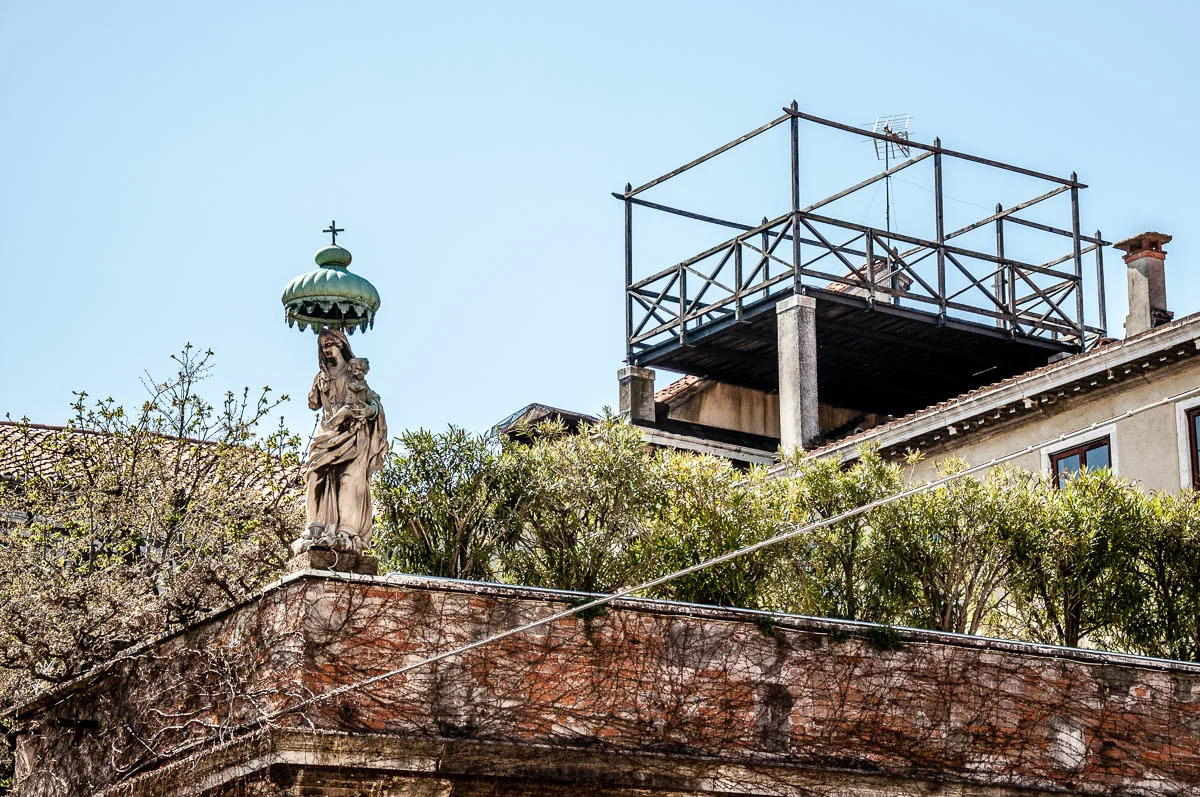
Altana – a traditional for Venice rooftop terrace. Built of wood, it offers an open-air space to put the clothes to dry in the sun, to spend precious hours of relaxation, and to simply admire the splendid views of Venice from above. In a densely built city like Venice, an altana is a valuable private place that many Venetians adorn with potted plants.
Centuries ago, the ladies of Venice would sit on their altane to lighten their hair in the sun. Apparently, in the homemade hair-bleaching mixture horse urine was an important ingredient.
As you walk around Venice, look up and you will see dozens of altane protruding from the rooftops. You may be lucky and your accommodation may have its own Venetian rooftop terrace. Take full advantage of it!
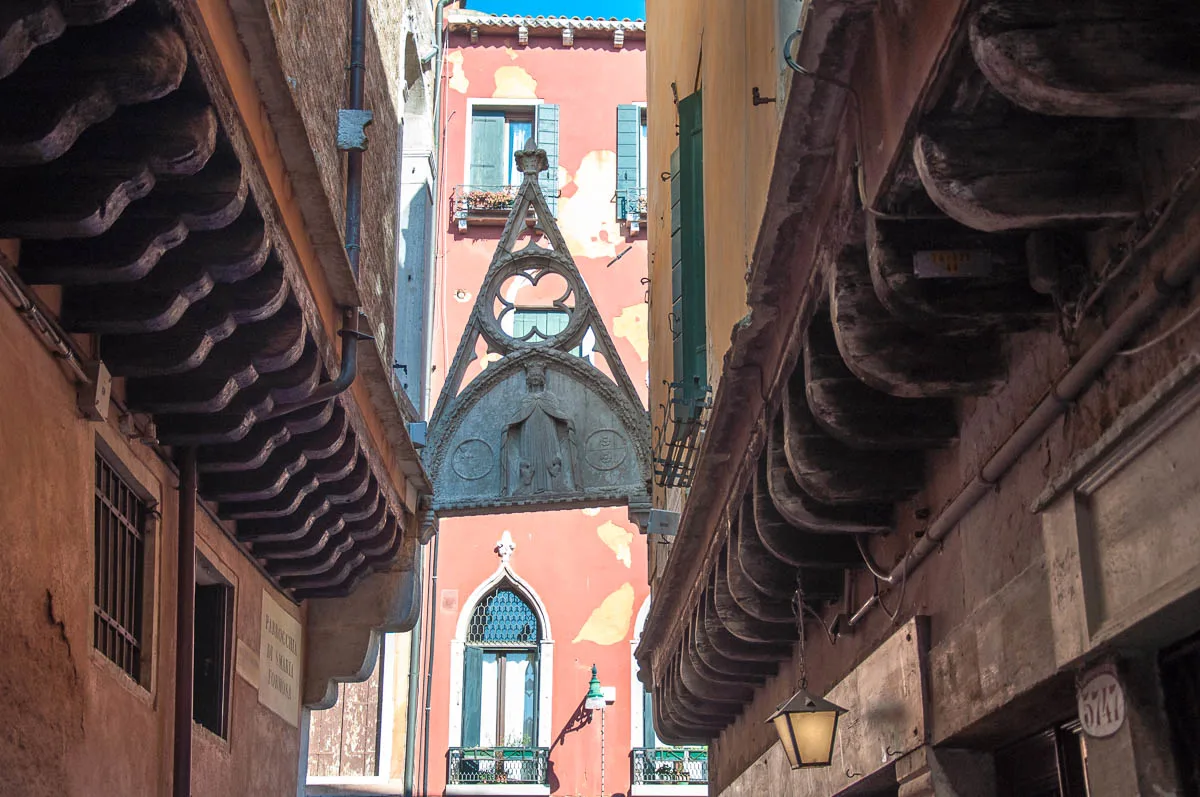
Barbacani – wooden beams used to expand the living area of the top floors of medieval and early Renaissance Venetian buildings. In a city where space has been traditionally tight, the barbacani helped you gain precious square metres.
You can see some of the best-preserved barbacani in Venice on the medieval Calle del Paradiso in the sestiere of Castello.
The term barbacani in Venice is also used to describe the beautifully carved and decorated wooden supports which lie on top of the pillars running along the open side of a portico.
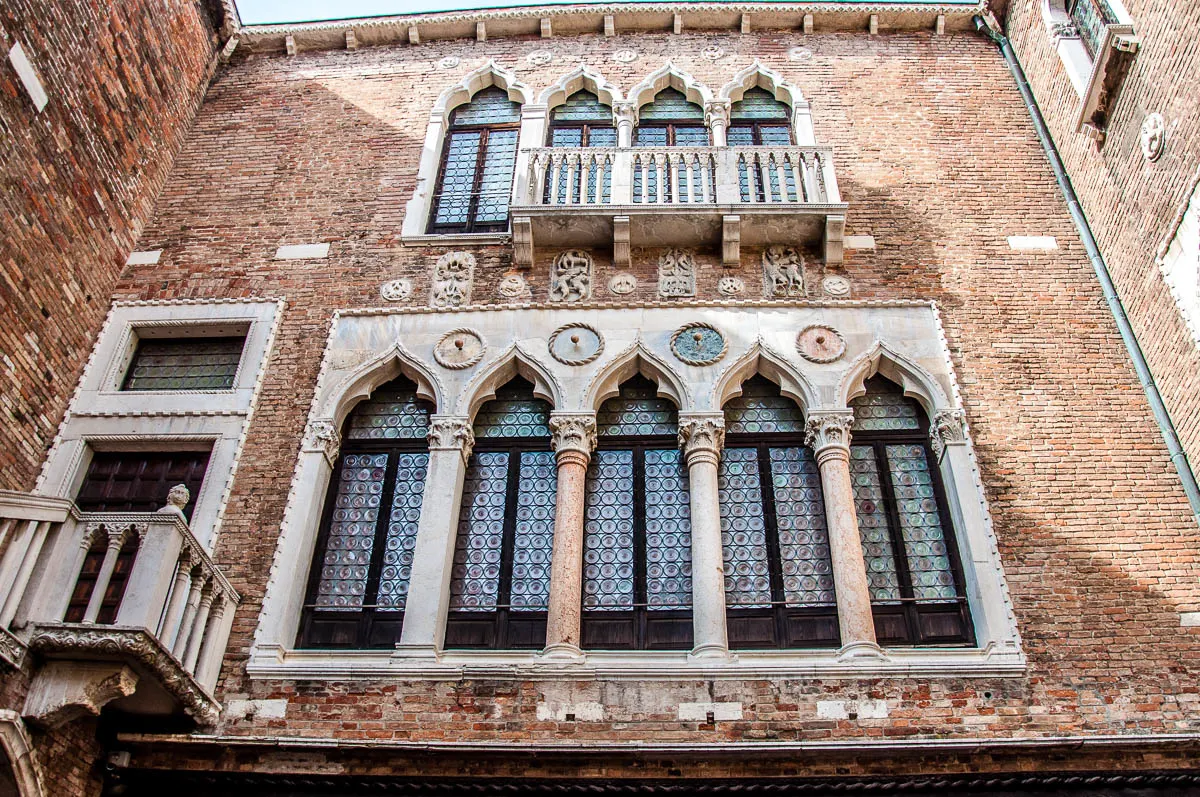
Finestrato – a group of windows crowned with arches and decorated with stone ornaments. A finestrato is the most striking element of a proper Venetian facade.
For a chance to admire one up close and personal, join the guided tour of Ca’ Foscari, the historic seat of the University of Venice. In its Aula Mario Barrato you can see the Grand Canal through a splendid finestrato which opens beautiful views towards the Rialto Bridge on one hand and the Accademia Bridge on the other.
The double finestrato pictured above is in the small inner courtyard of Ca’ d’Oro – the most breathtaking Gothic palace in Venice.
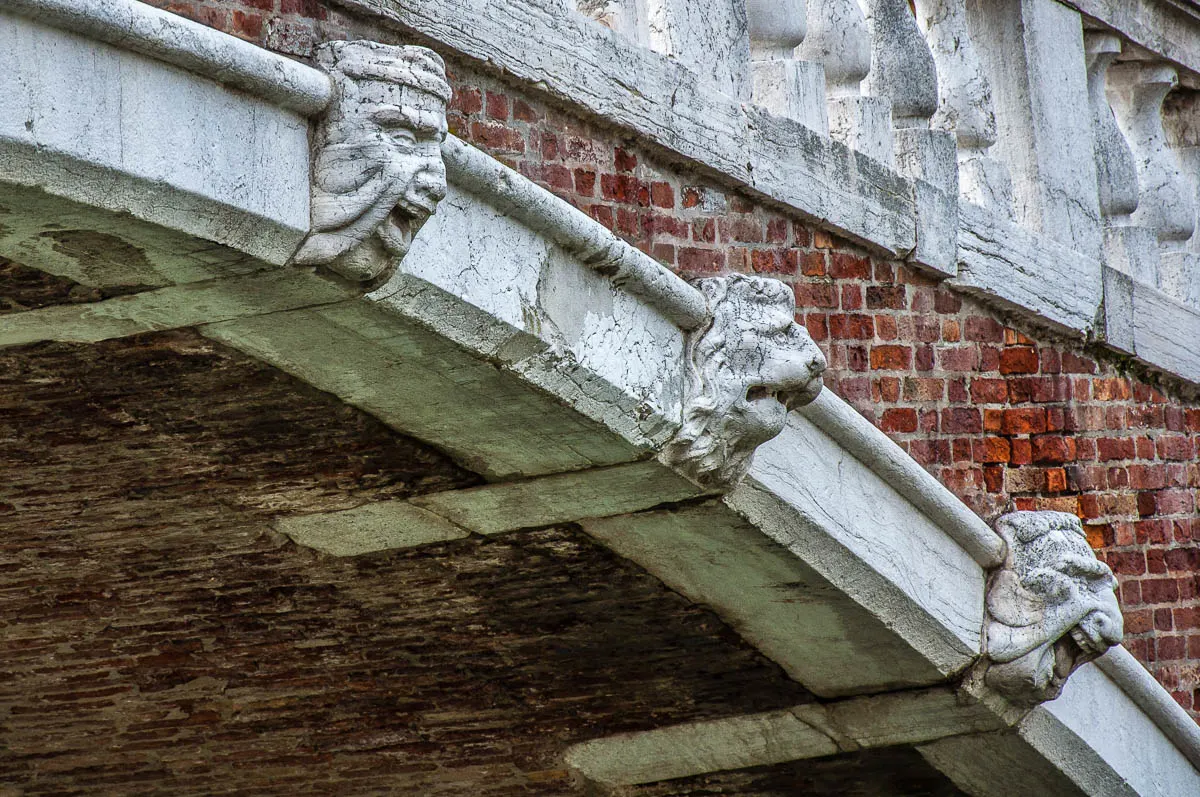
Mascaroni – stone faces that you will see adorning the keystones of arches, bridges, and water wells in Venice. They often have deformed features and may look a bit scary. The use of such faces is very ancient (it was common in many Roman cities, for example) and their original purpose was to scare off demons or malignant entities that may want to enter the house.
Keep an eye out when you walk around Venice and soon you will notice how many and varied the mascaroni are there. The most famous one is the grotesquely disfigured face above the door of the bell tower in the Campo of Santa Maria Formosa.
My favourite set of mascaroni in Venice is pictured above. These whimsical faces adorn the Ponte delle Guglie – a bridge that spans the Cannaregio Canal.
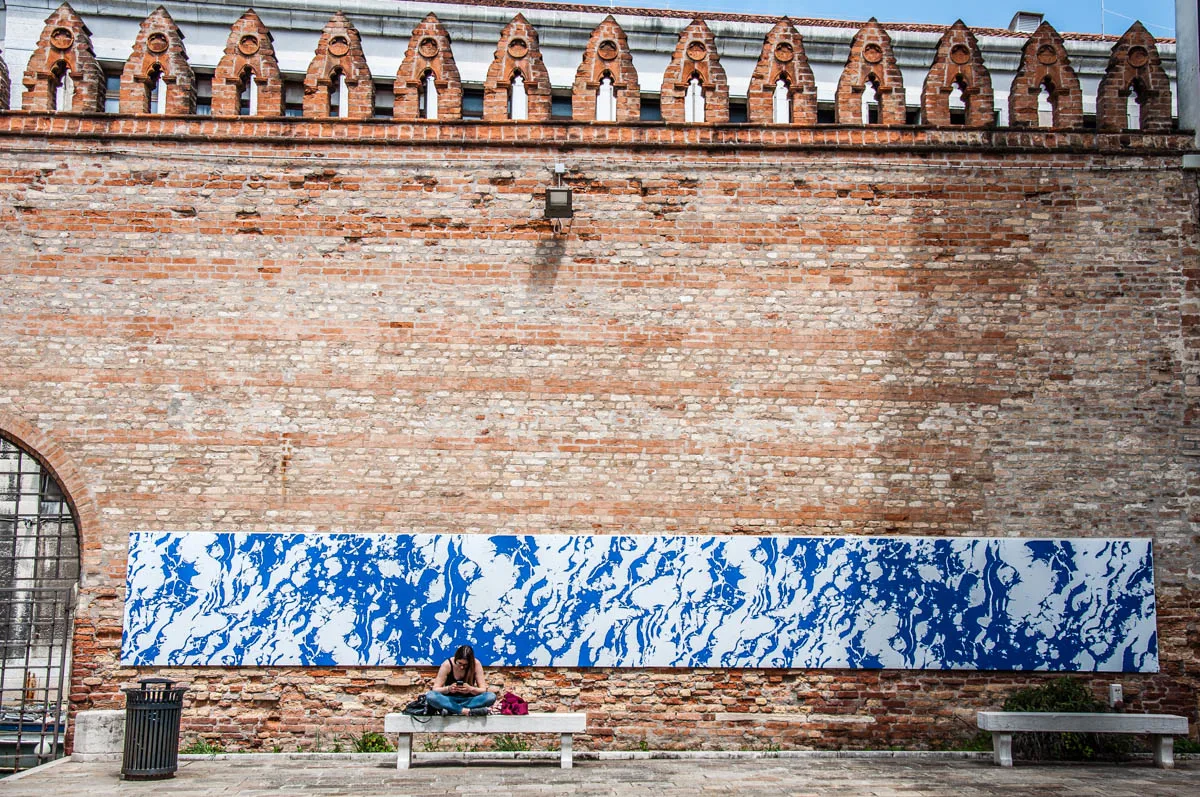
Merlatura – literally, a battlement in English. When in Venice, you will soon notice that many buildings (most notably, the Doge’s Palace) are crowned with beautifully ornamented battlements.
You will spot merlature in different shapes. Some look like proper lace that’s been chiseled out of stone. They make the buildings of Venice look very airy and elegant and naturally draw the eye up when you walk through the narrow alleys and alongside the glistening canals.
You can see the merlatura pictured above in the courtyard of Ca’ Foscari – the University of Venice.

Outside staircases – while they were built to provide easy access from the ground to the top floors of a building, Venice’s outside staircases nowadays make the city look even more romantic.
The most famous example is the outside staircase of Palazzo Contarini del Bovolo in the sestiere of San Marco. Bovolo means snail and this Late Gothic outside staircase is spiral-shaped and richly decorated.
In many courtyards around Venice, you will find many outside staircases. Try glimpsing the ones in Ca’ d’Oro, Ca’ Foscari, and Casa Goldoni.
The outside staircase pictured above is part of the Pescheria – the neo-Gothic building of Rialto Fish Market.
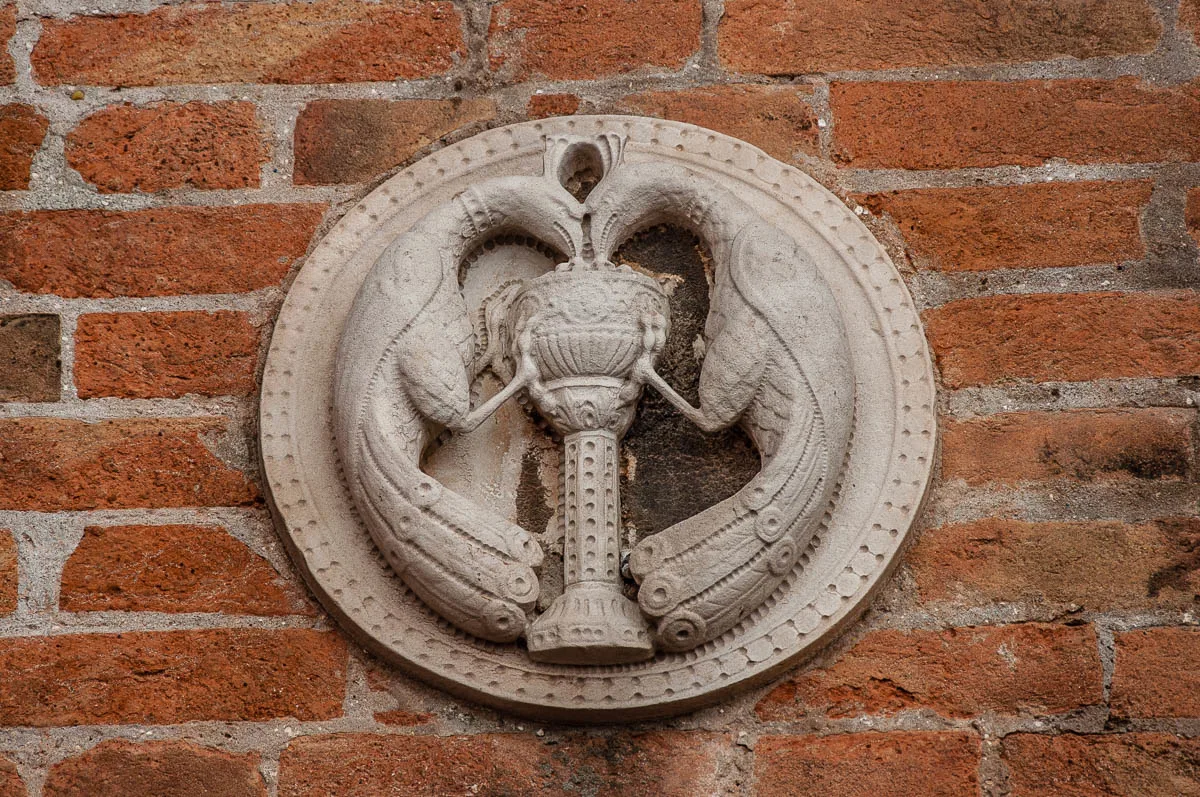
Patera – small circular bas-reliefs that adorn the facades of Venice and feature heavily in the decoration of the finestrati. Made of Istrian stone or Greek marble, they often depict animals and/or plants.
Very popular between the 10th and the 12th centuries, the patere were used all the way until the end of the 15th century. They can be as small as 20 cm or as big as 80 cm in diameter.
The patera pictured above adorns the outside wall of Titian’s house in Venice.
Venetian Chimneys – shaped like upturned bells, the chimneys that adorn the rooftops of the Venetian buildings add another layer of whimsicality and beauty to the city on water. Bellini, Carpaccio, and Canaletto loved to depict Venice’s forest of chimneys in their paintings.
The Venetian chimneys are wider at the top and narrow at the base in order to catch the sparks and not let them fall on the roofs. Originally, Venetian roofs were made of straw and later on from wood and the risk of fire was always omnipresent here.
ART & SCULPTURE

Venice is a treasure trove of art in all its shapes and variations. Cradle of world-wide famous artists, through the centuries the city itself became one immeasurably vast collection of canvasses, mosaics, frescoes, sculptures, statues, and installations.
While most visitors of the city on water head straight to the Doge’s Palace, Gallerie dell’Accademia, and St. Mark’s Basilica, here is a shortlist of some under the radar art destinations. They will help you build an even better understanding of the unique artistic character of Venice.
In addition, I have also included the names of four important Venetian artists who often get sidelined in the hunt for Titians and Tintorettos by visitors of Venice.
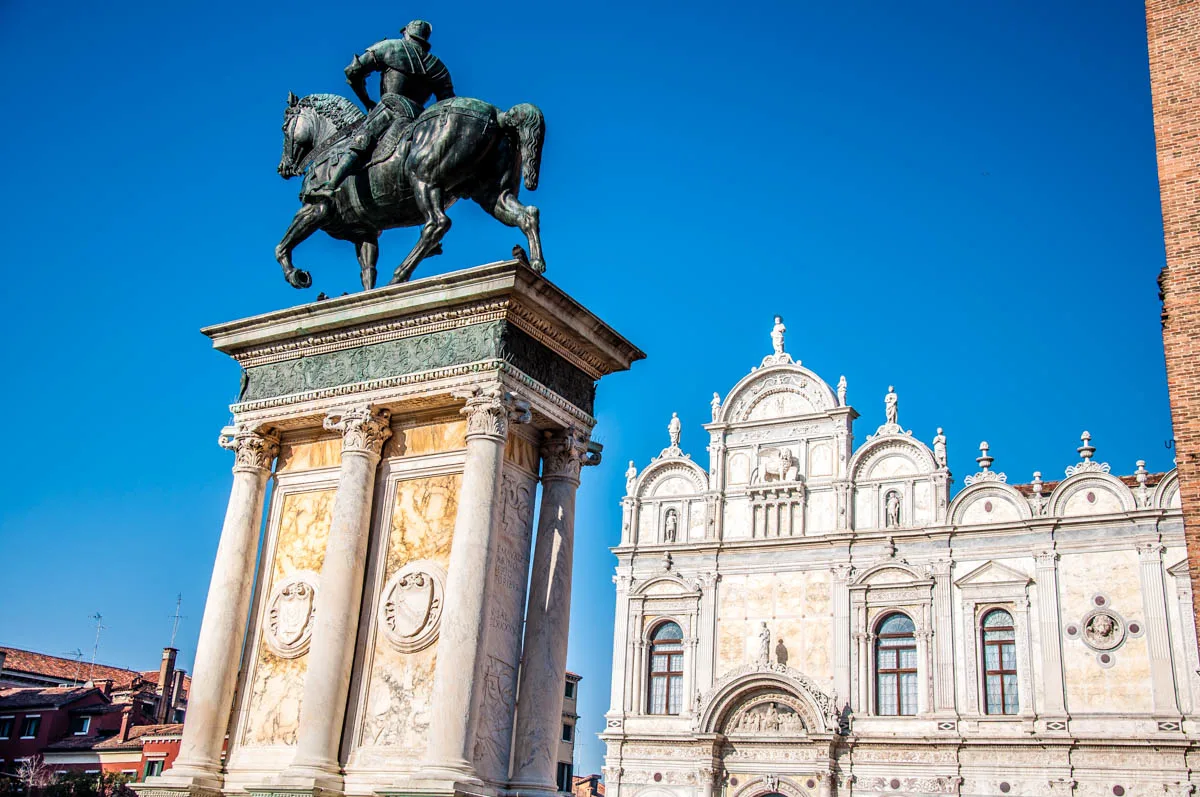
Equestrian monument of Bartolomeo Colleoni – next to the Basilica of Santi Giovanni and Paolo and the Scuola Grande di San Marco in the sestiere of Castello you can see an impressive statue. It was designed by Andrea del Verrocchio – most famous as the teacher of Leonardo da Vinci. After Verrocchio’s death, it was cast by Alessandro Leopardi – a sculptor and architect from Venice.
This is only the second full-size equestrian monument cast since the Antiquity (the first one is by Donatello and is in the nearby city of Padua). It represents the Condottiero Bartolomeo Colleoni – a military captain from Bergamo. He served faithfully the Republic of Venice and bequeathed a large sum to it with the stipulation that a monument should be erected to him at St. Mark’s Square.
Always quick to nip in the bud any potential cult of personality, the Venetian state instead decided to place the statue next to the Scuola Grande di San Marco – a much less prestige location which nevertheless was connected to St. Mark. This way the Republic both fulfilled Colleoni’s stipulation and avoided having a monument glorifying one person in the midst of Venice’s most important square.
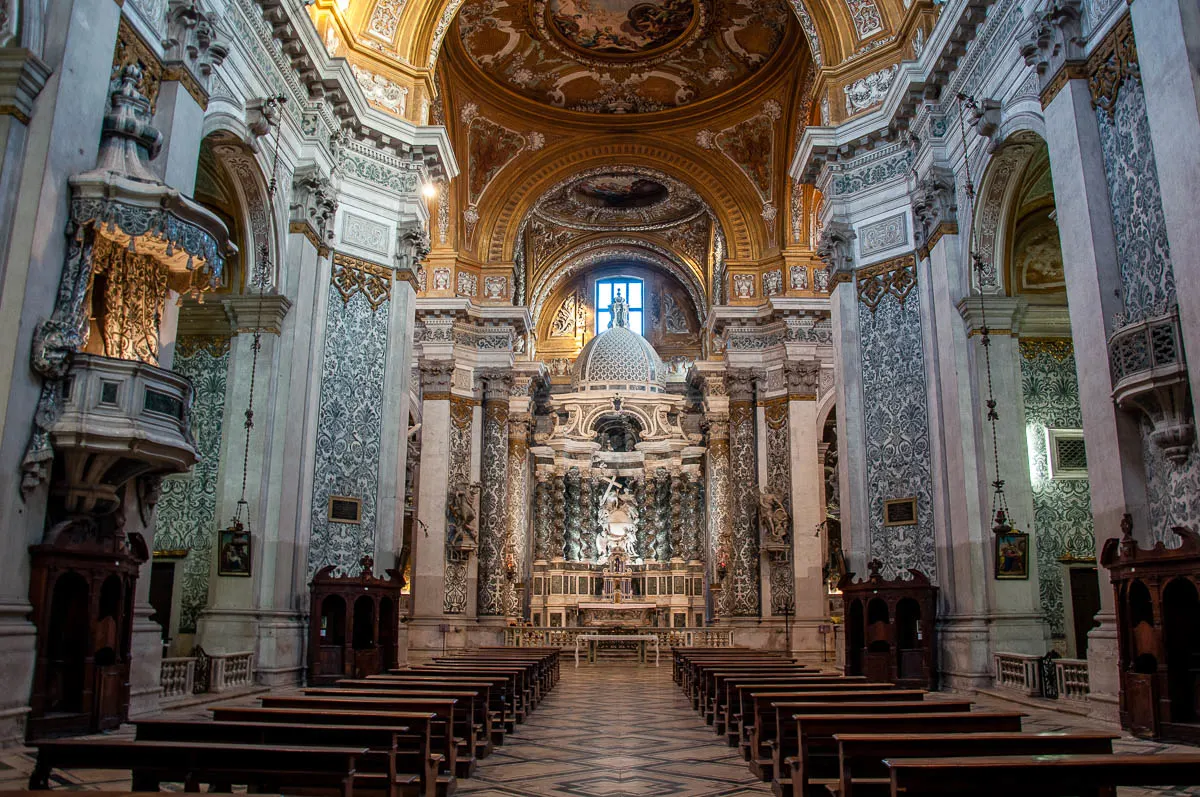
Intarsia – this is the art of creating images using different types of wood or marble and semi-precious stones. Whole scenes are built by inlaying pieces of wood or stones in different colours. The more you look into an intarsia design the more stunning little details you discover. Plus, there is a wonderful 3D effect and an illusion of depth even though traditionally intarsia designs are flat.
Trough the centuries, intarsia has been used to decorate several religious and private spaces in Venice. The choir stalls in the Basilica of Santa Maria Gloriosa dei Frari are decorated with very intricate wooden intarsia. The interior of the Church of Santa Maria Assunta (also known as the Church of I Gesuiti) is a glorious example of marble intarsia.
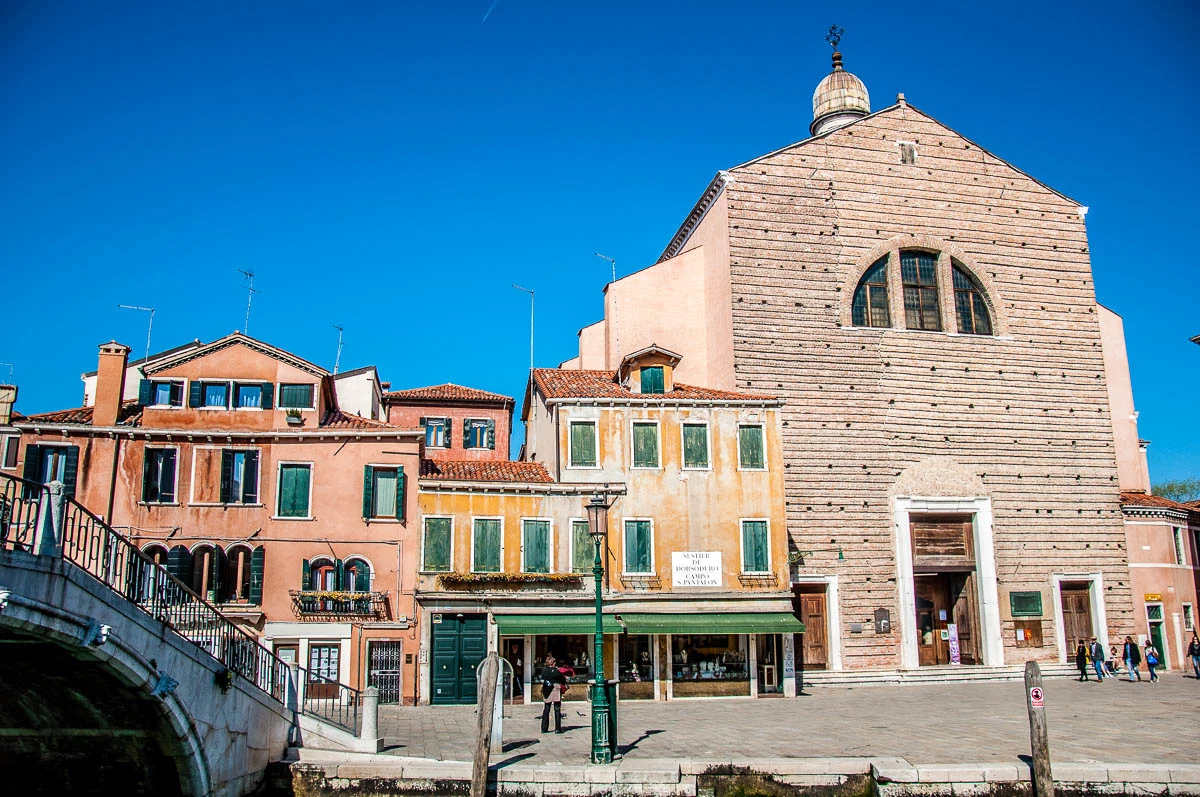
Paolo Veneziano – meet the official painter of the Republic of Venice in the 14th century. Paolo Veneziano’s art bridged the gap between the Byzantine rules of artistic expression and the medieval Gothic canons. He is considered the founder of the Venetian school of painting to which later on the names of Titian, Tintoretto, Giorgione, and the Bellinis would be added.
The city on water preserves several of his paintings. A favourite of mine is the Madonna of the Poppy in the Church of San Pantalon (pictured above) in the sestiere of Dorsoduro.
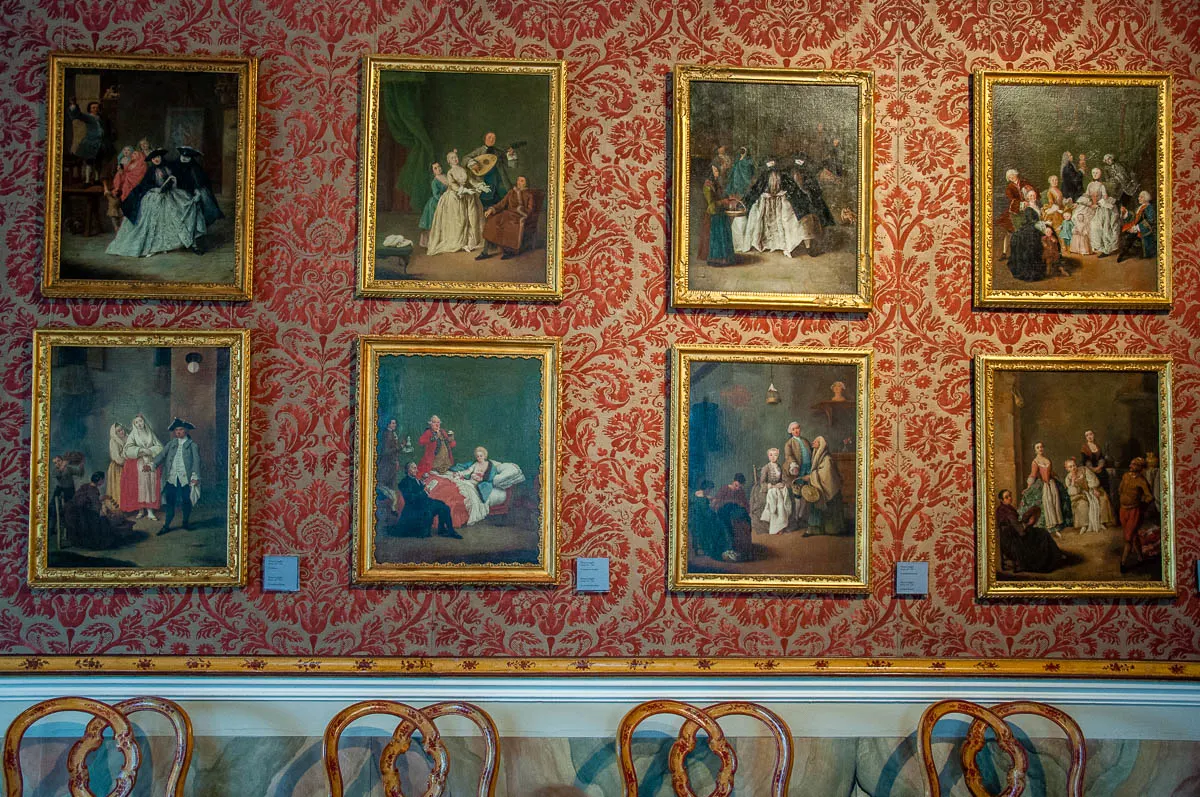
Pietro Longhi – discover the art of the painter who depicted 18th-century Venice with the eye of a modern documentary maker. A large number of Longhi’s paintings are in Ca’ Rezzonico – the Museum of 18th Century Venice. Some of his paintings are also preserved in Gallerie dell’Accademia and Fondazione Querini Stampalia. You can also see some frescoes by Pietro Longhi in the above mentioned Church of San Pantalon.
Pillars of Acre – two beautiful pillars near the southern side of St. Mark’s Basilica. They are intricately decorated with carvings and symbols and were brought to Venice after the sack of Constantinople in 1204.
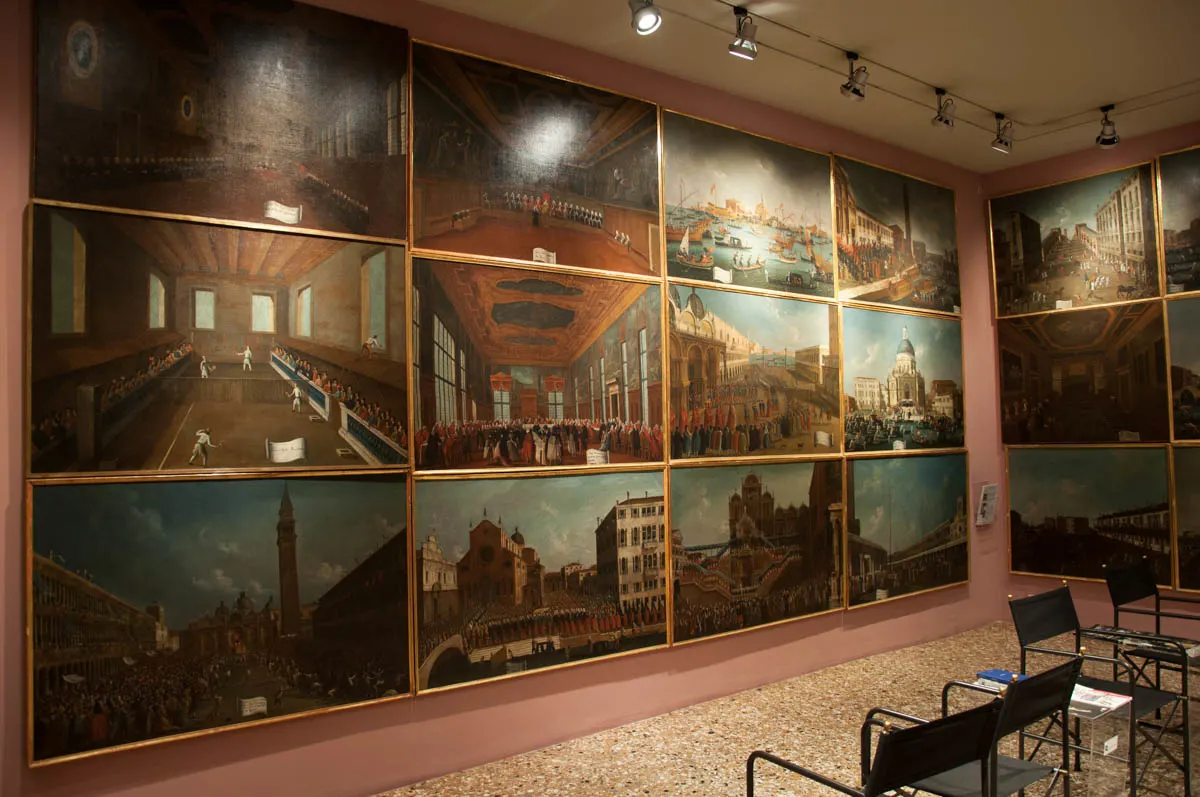
Room with Scenes of Venetian Life in Fondazione Querini-Stampalia – a small room the walls of which are completely covered with paintings taking you back through the centuries to a Venice where tennis was played and large official ceremonies were staged.
This is a very quiet place where you can sit on the chairs in the middle of the room and spend as much time as you want simply taking in the detailed paintings showing you the splendour and the daily life of the Republic of Venice.
The Martyrdom and Apotheosis of St. Pantalon by Gian Antonio Fumiani – allegedly, the world’s largest painting on canvas. It took its creator over 20 years to finish it. You will find it in the Church of San Pantalon in the sestiere of Dorsoduro where the painting covers the church’s whole ceiling. It has a wonderful 3D effect with figures and objects seemingly emerging from the flat canvas.
Try positioning yourself at different spots around the church to focus on different portions of the painting. Your neck may strain a bit but your eyes will find so many details and figures to focus on. To get a proper look at the painting, put a coin in the donation box near the church’s door. This will automatically illuminate the ceiling.
It is believed that the painter Fumiani perished by falling off the scaffolding during the completion of his masterpiece. This is not a proven fact though.
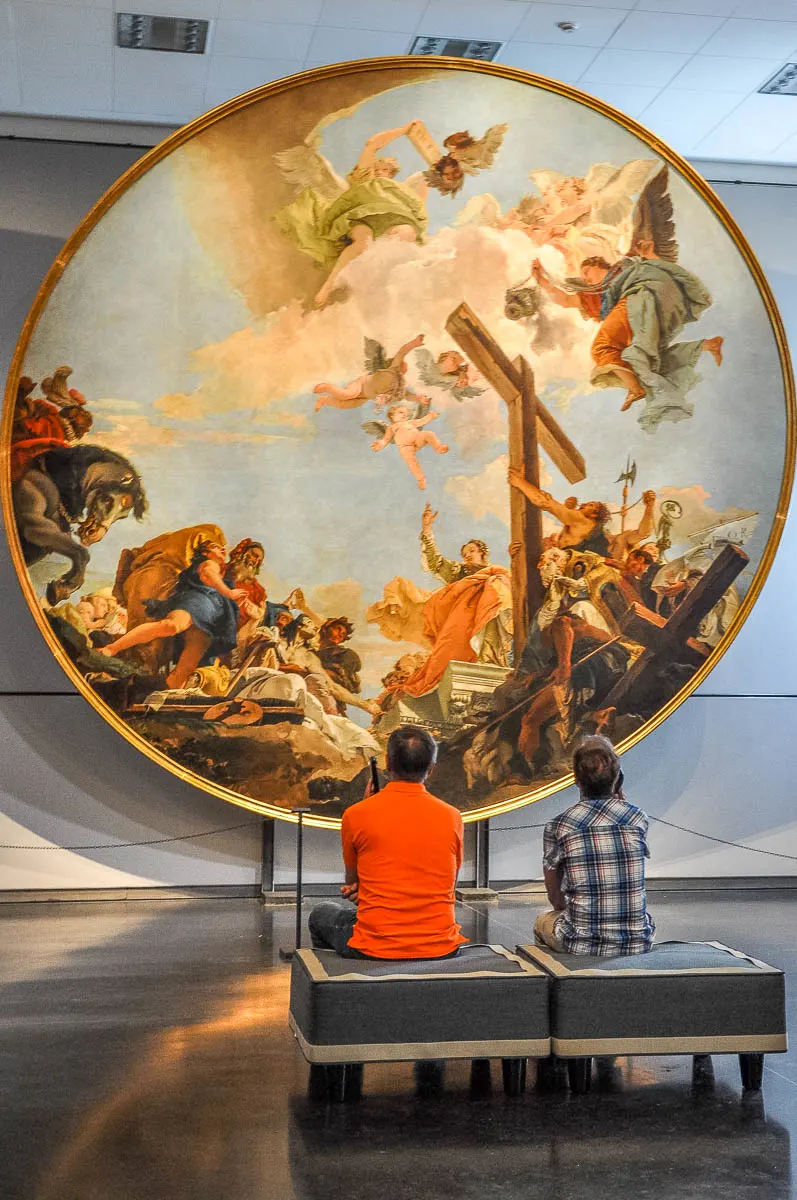
Tiepolo – Giambattista Tiepolo and his son Giandomenico Tiepolo represent the Roccoco and Baroque styles in the Venetian painting. Their art can be admired at several off the beaten track sights around town, for example in the Scuola Grande dei Carmini and the Church of San Lio.
A large ceiling fresco by Giambattista Tiepolo in the Church of Santa Maria di Nazareth (next door to Venice’s Santa Lucia train station) was destroyed during the Austrian bombardments of Venice in 1915. Nowadays, the preserved fragments of the fresco are in the Gallerie dell’Accademia together with other works by Tiepolo. Like ‘The Discovery of the True Cross’ pictured above.
One of the most important creations by Giambattista Tiepolo in Venice are the frescoes covering the ballroom of the Baroque Palazzo Labia in the sestiere of Cannaregio. They represent scenes from the life of Cleopatra. Unfortunately, the palace is closed to the public thus remaining a true hidden gem in the city on water.
Instead, make sure to have a look at the frescoes of Giandomenico Tiepolo in Ca’ Rezzonico – The Museum of 18th-century Venice in the sestiere of Dorsoduro.
BRIDGES
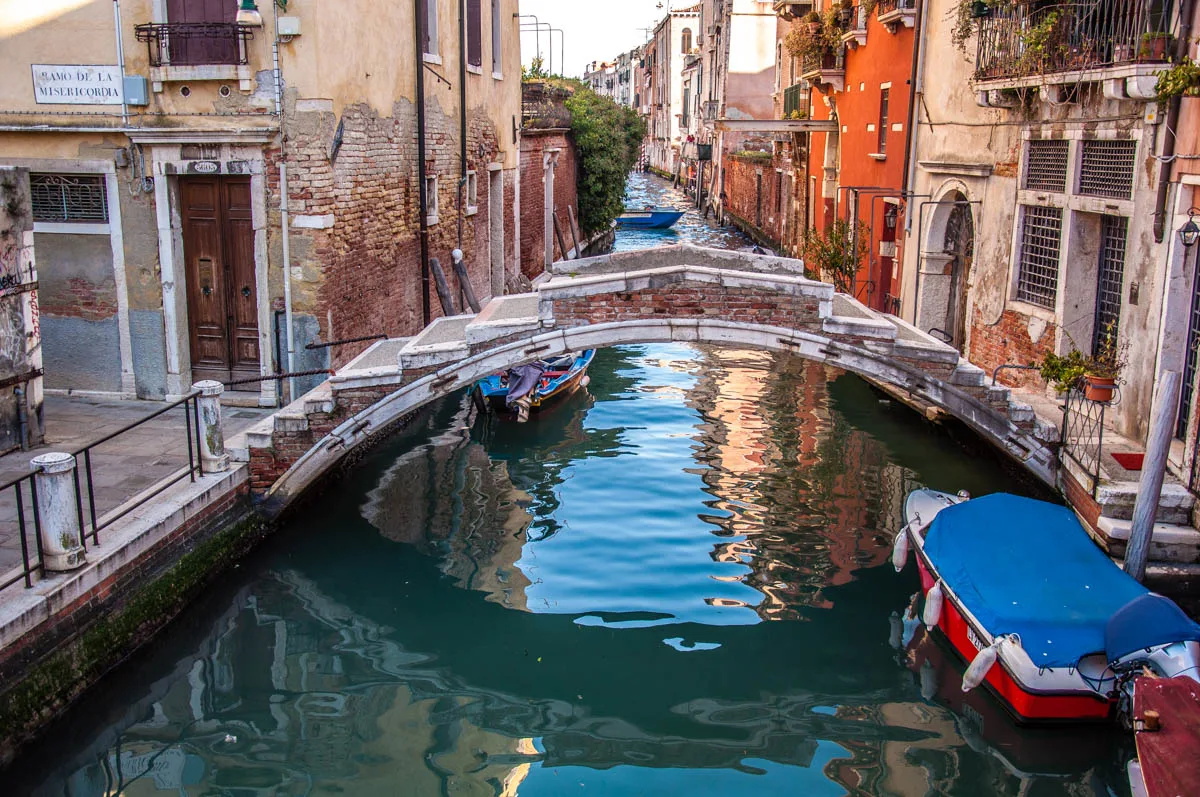
In a city built on 118 islands, bridges are the connection that provides access, guarantees communications, and keeps it all together.
There are 391 bridges in Venice stretching over 150 canals. Most are small, some are private, and a few are famous all over the world. And one of them – the Bridge of Sighs – is often misunderstood. Just opening a bracket here to mention that the Bridge of Sighs, gorgeous as it is, is not a romantic destination. It was simply the bridge that the Republic’s prisoners crossed when led down to the gaols, coincidentally allowing them to have one last glimpse of Venice’s beauty.
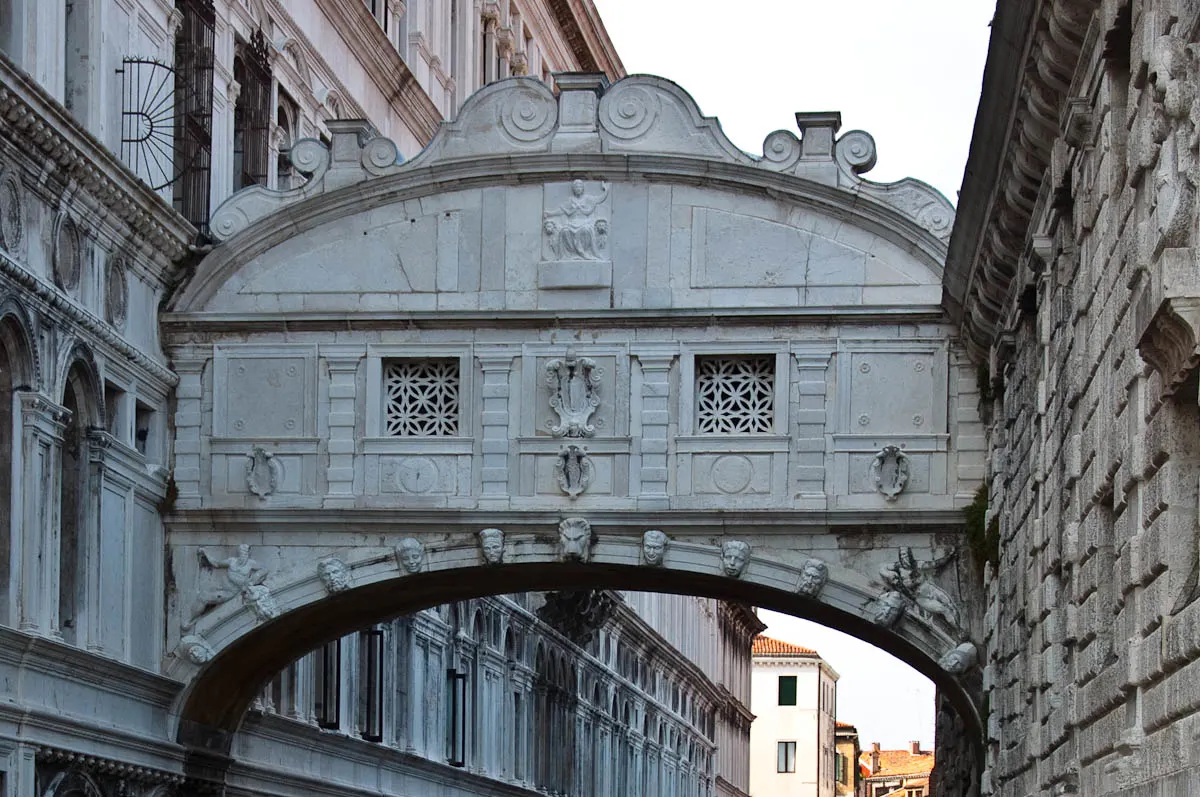
You will cross many bridges during your stay in the city on water. Some you will cross dozens of times on your way to and from your accommodation. Other bridges – like Rialto Bridge and Accademia Bridge – you will specifically seek out in order to admire world-famous views and take a commemorative selfie or two.
Before you know it, you will start thinking in bridges during your exploration of Venice. ‘Three bridges straight ahead and then one bridge to the left and you will be at your destination,’ a local will explain to you when you are terribly lost and asking for directions. And then, it will all click in place and you will embrace the bridges not as a nuisance of constant ups and downs but as beautiful seams that keep the fabric of Venice together.
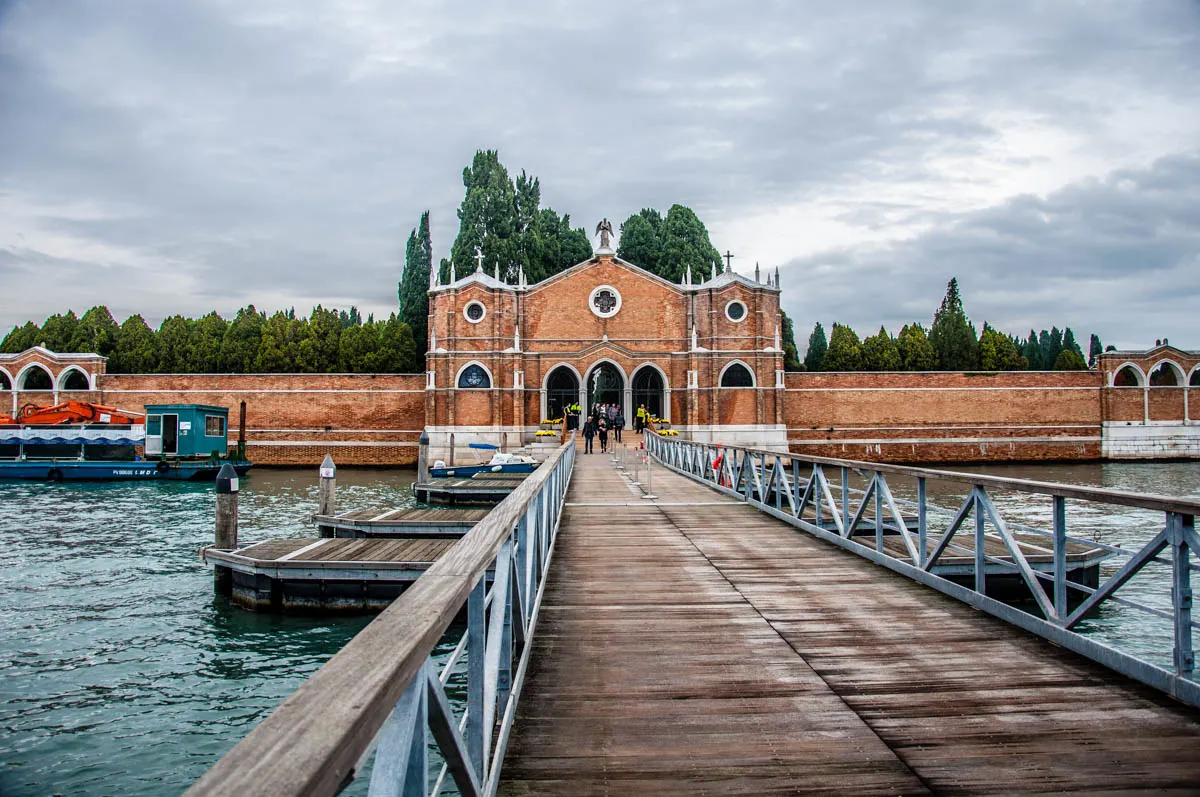
At this point, make sure that you stray off the beaten track and visit some of Venice’s most curious bridges. For their history, architecture, depictions in famous works of art and local traditions attached to them, Venice has dozens of bridges that deserve your attention. Make a plan to see them. Walk from one to the next, admiring the views they afford you and appreciating their role in the context of the city.
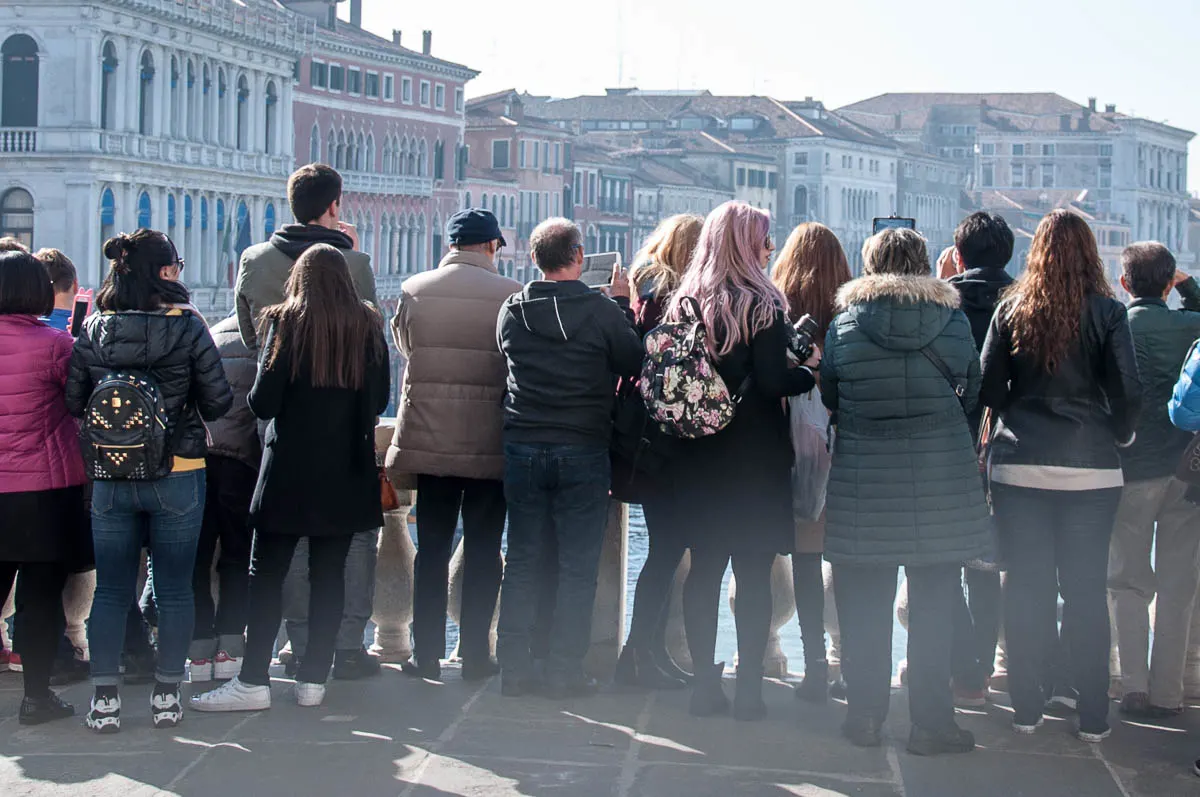
A word of caution though! Make sure that you don’t linger on Venetian bridges. They are crucial to the smooth flow of foot traffic in Venice. It would be like stopping at a roundabout anywhere else in the world to take a photo or pose for a selfie. Bridges in Venice must not be obstructed, so cross them quickly.
Here is a shortlist of some of the most interesting and unusual off the beaten track bridges to see in Venice:
Bridge of Assassini – the Assassins’ Bridge and the adjacent Assassins’ Street (Calle dei Assassini) are in the sestiere of San Marco. This is where many murders and robberies were committed in the past. The street was narrow and dark. Venetian noblemen would often choose to walk through it, eager not to be seen, on their way to the nearby brothels. Caught in that tight spot they were easy prey for robbers and murderers.
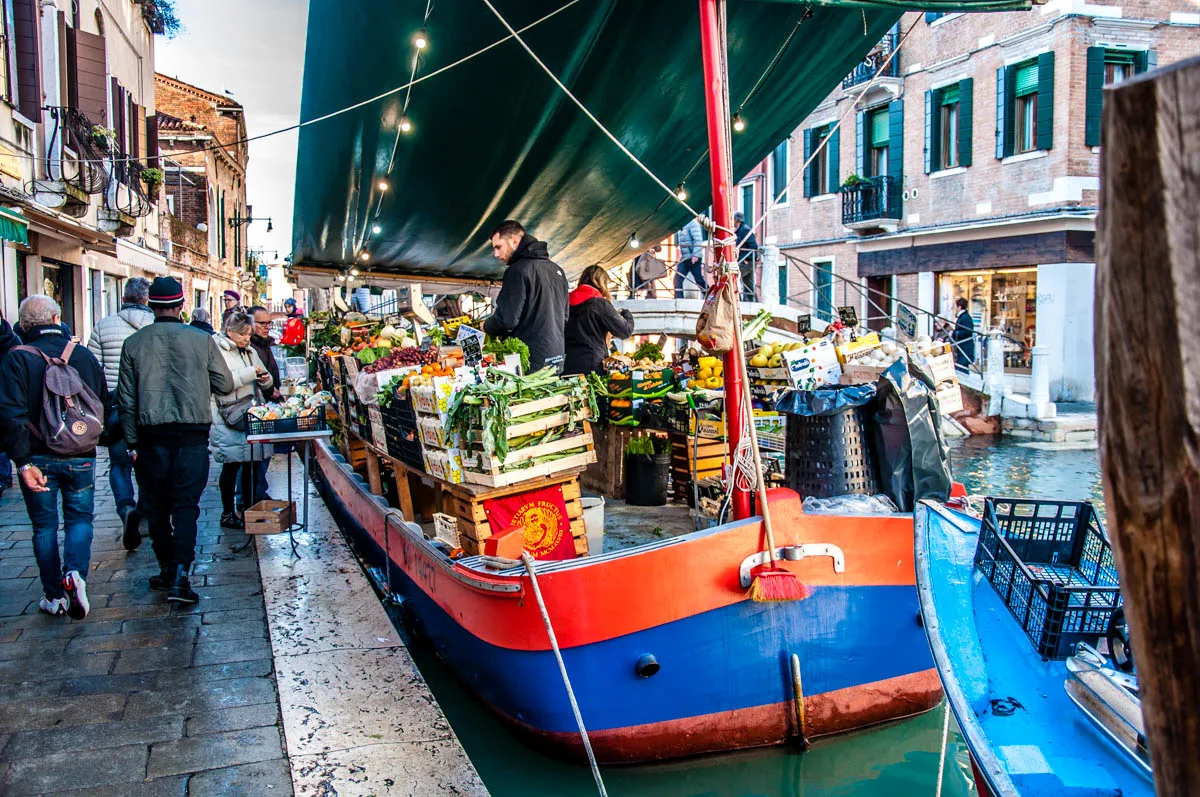
Bridge of Pugni – located near Campo San Bernaba in the sestiere of Dorsoduro, nowadays this bridge is mostly famous as the mooring spot of a floating fruit and veg shop that is set up on the deck of a large barge (pictured above). There is something quite romantic to have your freshly picked fruit and veg arrive each morning by boat!
The barge is a great thing to see in Venice and I highly recommend it. At the same time, when you are there, have a look at the bridge and try to spot the four footprints made of white marble on it. They marked the starting position of fighters from warring Venetian clans who would engage in fistfights on the bridge.
The aim was to use your firsts to disbalance and throw your opponents in the cold water of the Venetian canal below. In fact, the bridge’s name Ponte dei Pugni translates as the Bridge of Fists in English. From the end of the 16th century to the very first years of the 18th century, the fistfights were very popular entertainment in the city. While they were held on several bridges around town, the Bridge of Pugni would attract the biggest crowds.
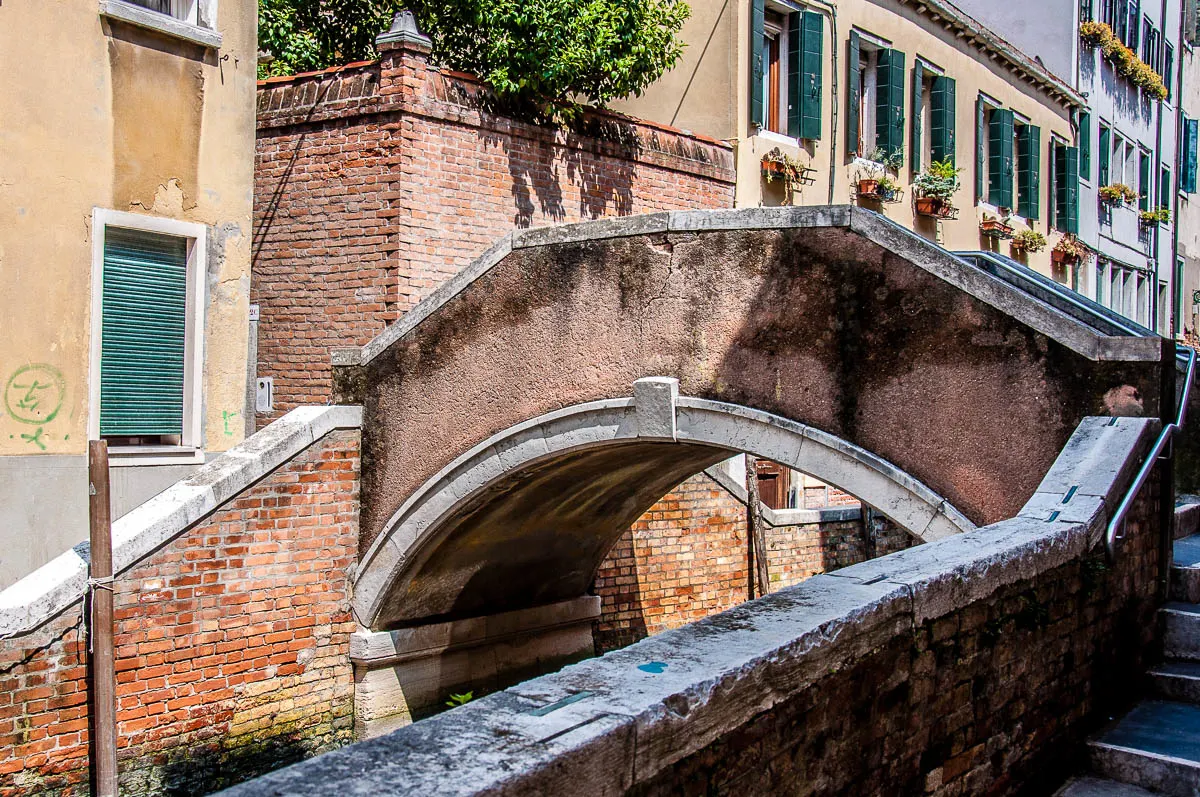
Bridge of Tette – tette in the Venetian language means literally ‘female breasts’. The Bridge of the Tette is tiny and not very pretty but it happens to be in the middle of Carampane’ in the sestiere of San Polo. A few centuries ago Carampane’ was Venice’s red lights district.
The women working there were allowed to show their breasts to prospective clients and it is thought that the bridge was a convenient spot to stop and look up at the windows of the adjacent houses to admire the view of the bare-breasted ladies of the night.
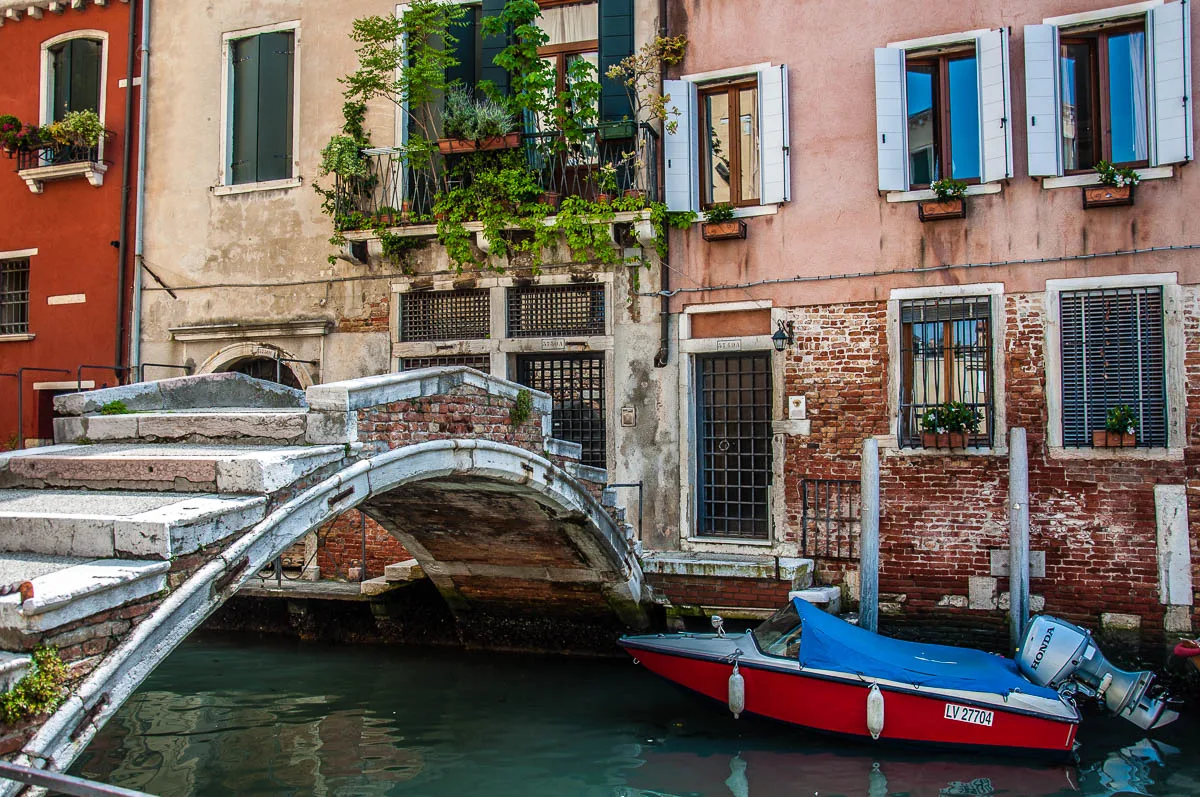
Chiodo Bridge – curiously enough, this is a bridge without railings. It took its name (which means ‘nail’ in English) from the noble Venetian family that owned it. You will find the Chiodo bridge huddling in the Venetian sestiere of Cannaregio. It leads to a nicely appointed B&B.
Originally, bridges in Venice were built without railings. For hundreds of years, they tested the ability of Venetians to keep their balance. It was only in the 19th century that for health and safety reasons, railings were added.
Somehow, Chiodo maintained its original appearance. Perhaps it happened because it is a private bridge although there are in total 72 private bridges in Venice, all 71 of them with railings. Nowadays there is only one other bridge without railings that remains in the Venetian Lagoon – the Devil’s Bridge on the island of Torcello.
Wooden Bridge of Poste Vecie – Housed in a former post office of the Republic of Venice, Poste Vecie is a restaurant that has been at the same spot since the 16th century. To reach its door you need to cross Venice’s oldest bridge that is still standing. Arched and made of wood, this is a small private bridge at the back of Rialto Fish Market.
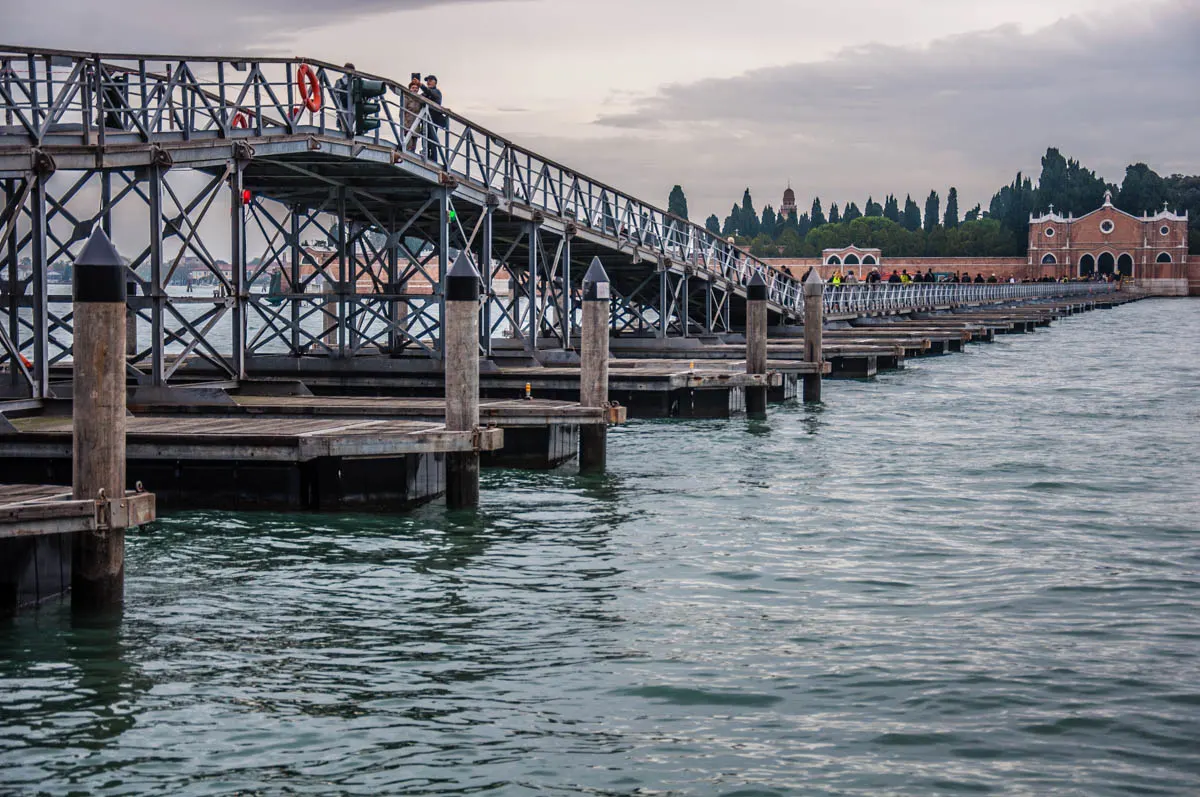
Venice’s Votive Bridges – along its many permanent bridges, three times a year, Venice also erects a temporary bridge resting on barges. Called votive bridges, these temporary structures are intrinsically connected to an important Venetian tradition and/or celebration. As such, votive bridges are erected in Venice for these occasions:
- Third Sunday of July – Feast of the Redeemer – the votive bridge connects both sides of the Giudecca Canal and leads to the Church of Santissimo Redentore on the island of Giudecca;
- 21st November – Feast of the Madonna della Salute – the votive bridge connects both sides of the Grand Canal in the vicinity of the Basilica della Salute;
- Last days of October/First ten days of November – All Souls’ Day – the votive bridge (pictured above) connects Fondamente Nove in Venice with the city’s cemetery on the island of San Michele.
CHURCHES, TEMPLES & RELIGION

There are hundreds of churches in Venice. Many are world-famous for their history and architecture as well as for the rich collections of art they have. Others have been deconsecrated but continue to play an important role in Venetian life. A great example is the former Church of San Maurizio which nowadays houses Venice’s Museum of Music.
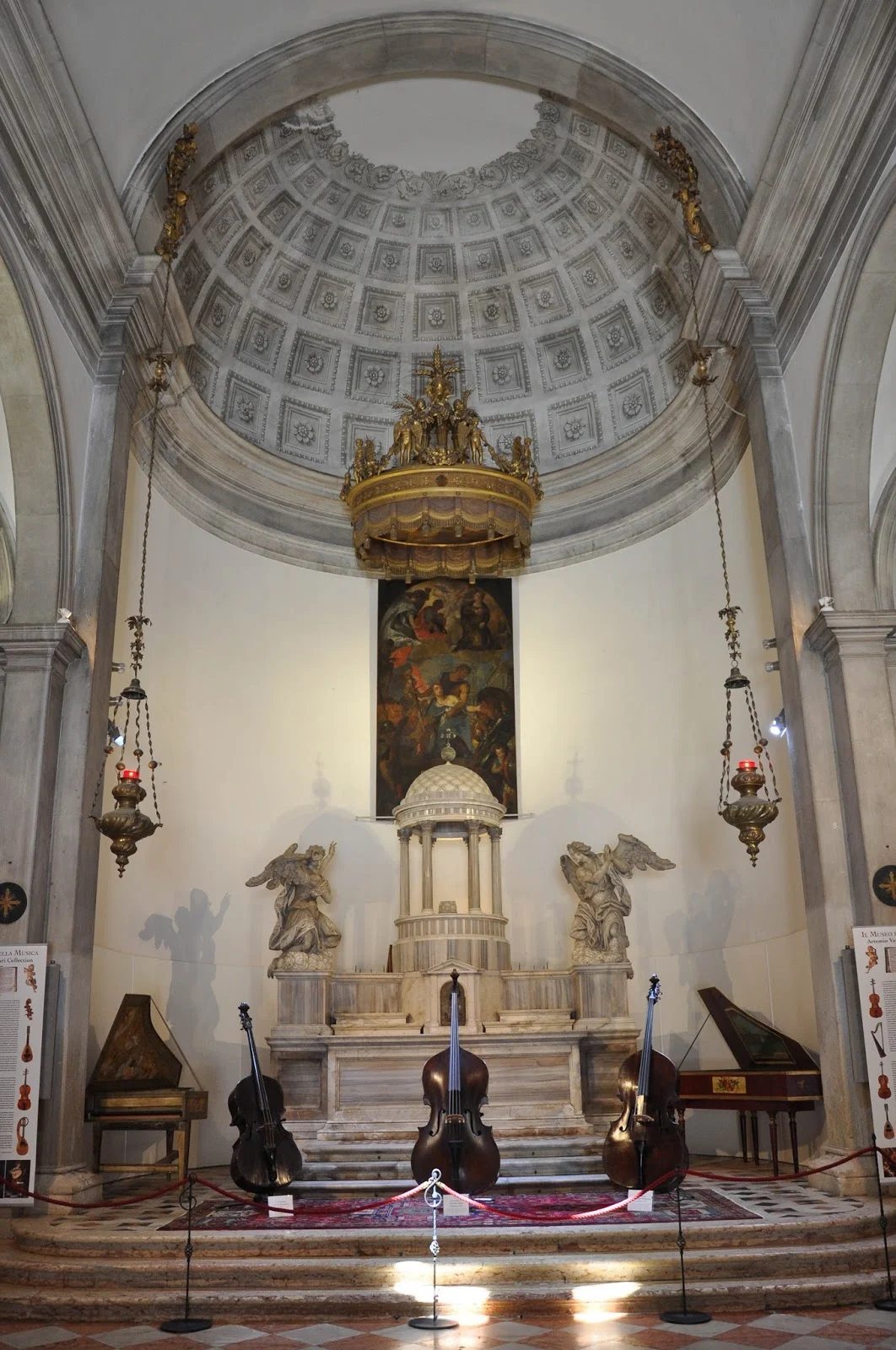
Visiting as many churches in Venice as you can is a great way to get to know the city on water on an intimate artistic, musical, historic, and human level. While entry to some of them costs a few euros, others are completely free to see and explore. Chorus is an association that takes care of several Venetian churches making sure that their heritage is conserved and restored. A Chorus pass gives you access to 16 churches for a reduced price.
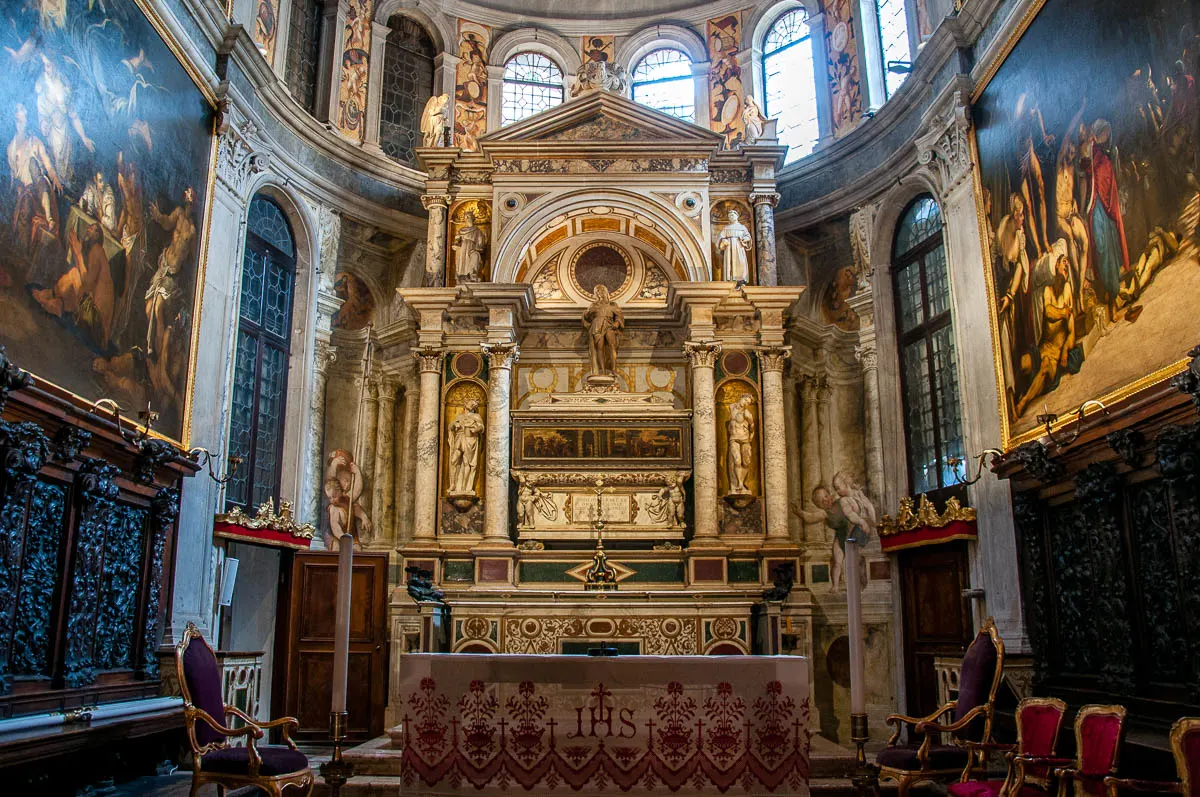
Representing all the different architectural and artistic styles that Venice has evolved through, the churches here are like time capsules opening a window into specific periods of the development of the city on water.
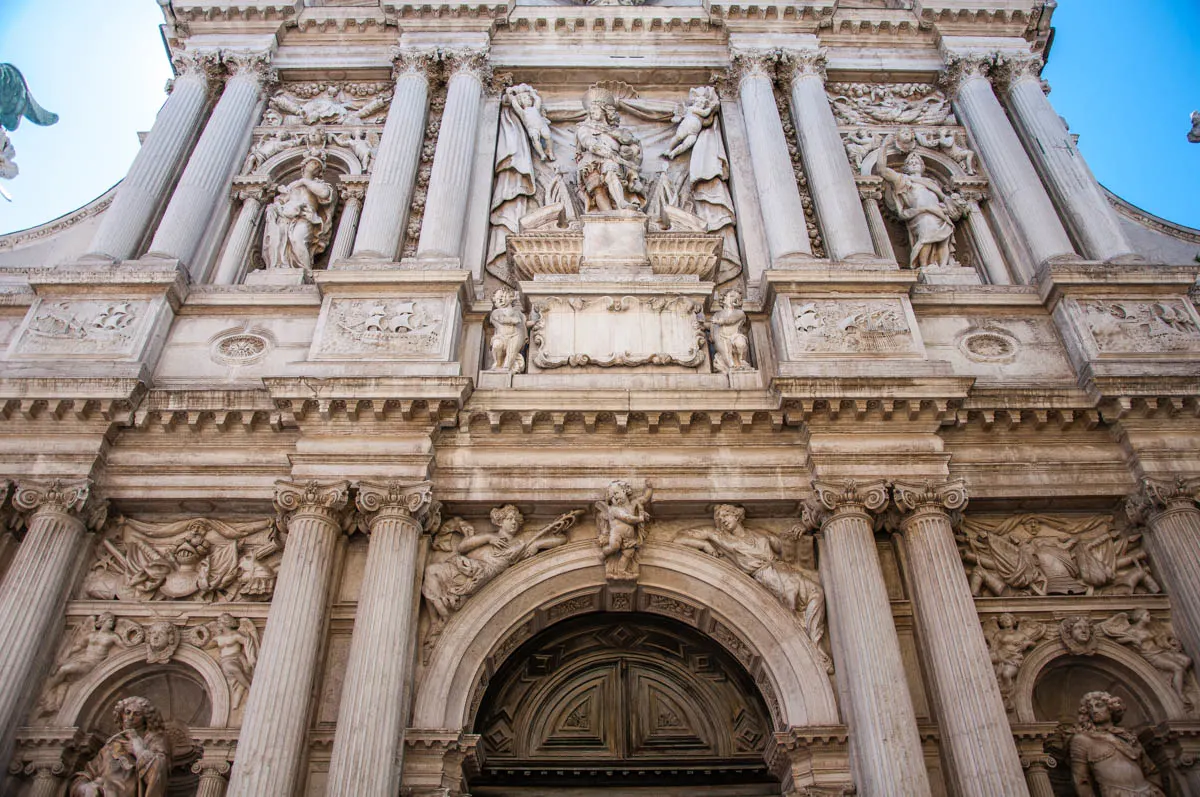
In addition, in Venice, you can visit several synagogues and the world’s first ghetto. The Jewish population of the city on water was restricted to reside in it with a dogal decree on 29th March 1516. This article in The New York Times beautifully recounts the story of the Jewish Ghetto in Venice and reveals interesting details about the life of the Jewish community in the city at present.
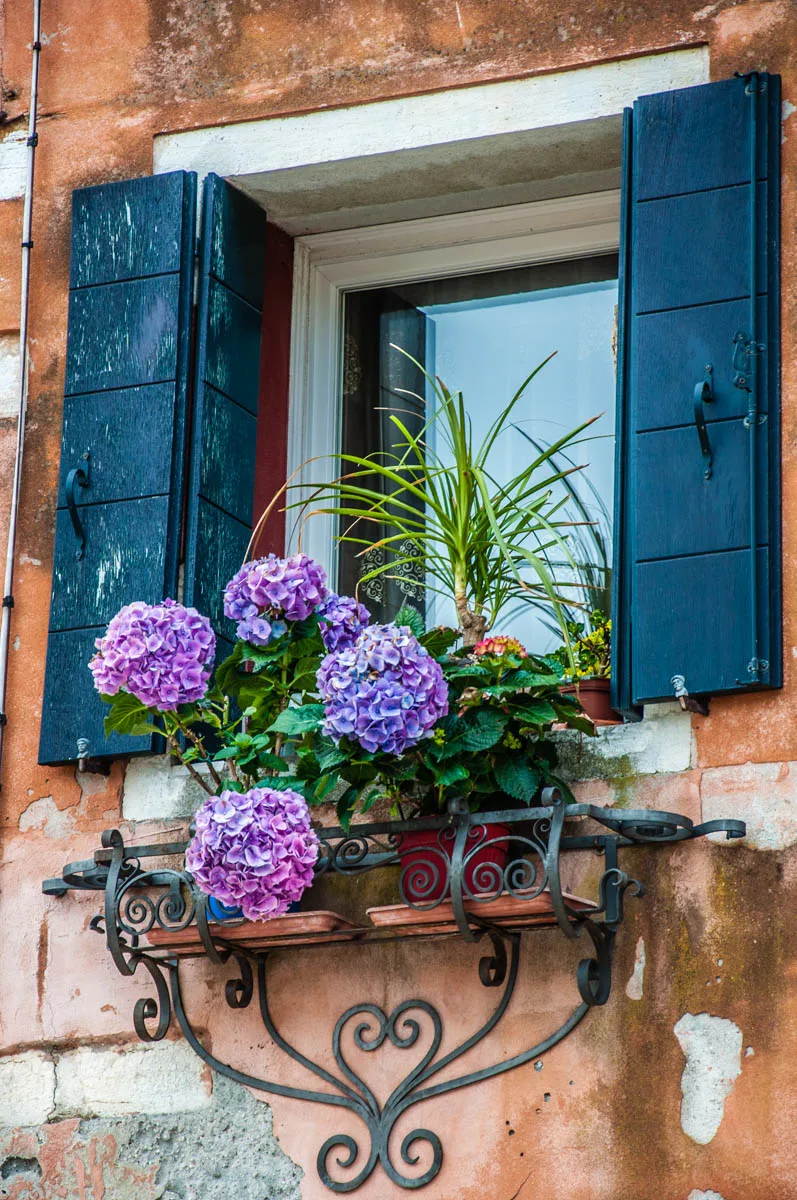
Here is a shortlist of some of the most interesting churches and religious sights in Venice off the beaten track. Be aware that some of them may be only accessible via a guided visit or may have restricted opening times. In addition, suitable clothing covering shoulders and knees is compulsory. Plus, tourist visits are not allowed during mass.
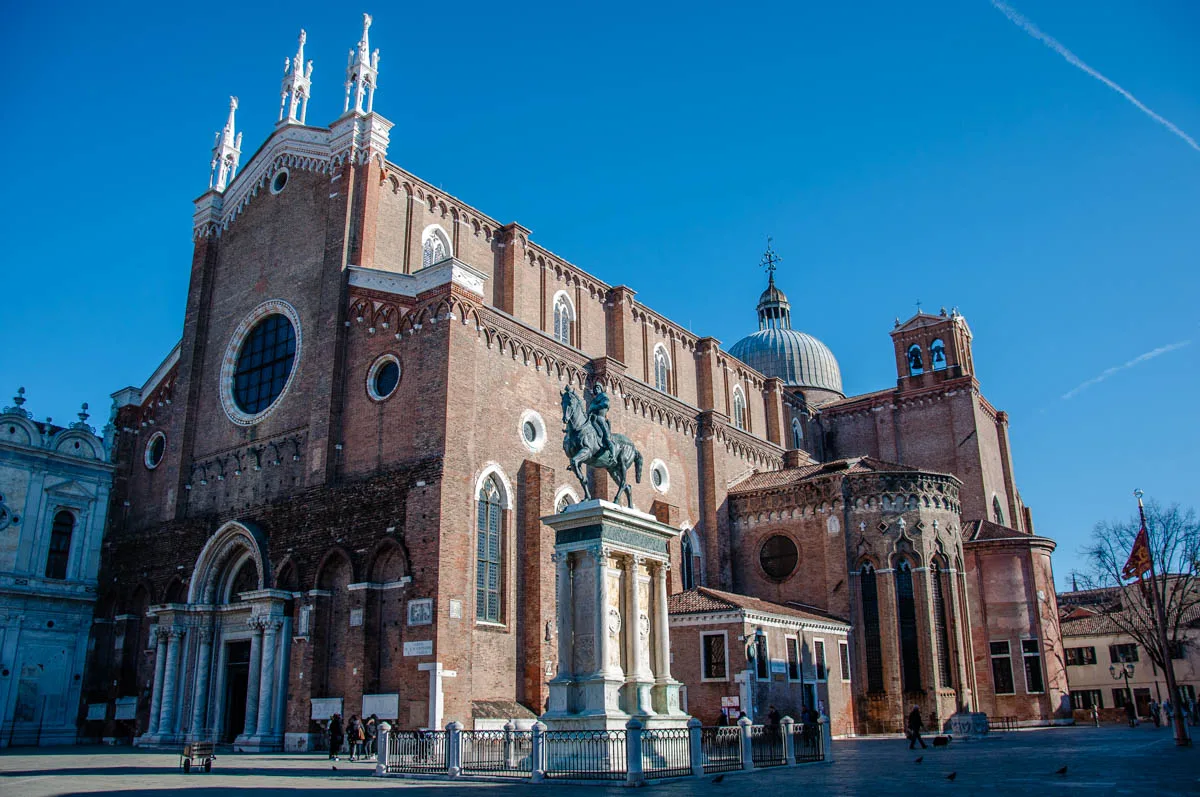
Basilica of Santi Giovanni and Paolo – one of the most important churches in Venice, yet often overlooked, this minor basilica is the final resting place of 27 Venetian doges. Their ornate sarcophagi lie beneath impressive funerary monuments.
One of the basilica’s most precious relics is the foot of St. Catherine of Siena.
The basilica is enormous in size and a very peaceful and full of light place to visit. You will find it in the sestiere of Castello, right next to the Scuola Grande di San Marco and the equestrian monument of Bartolomeo Colleoni.
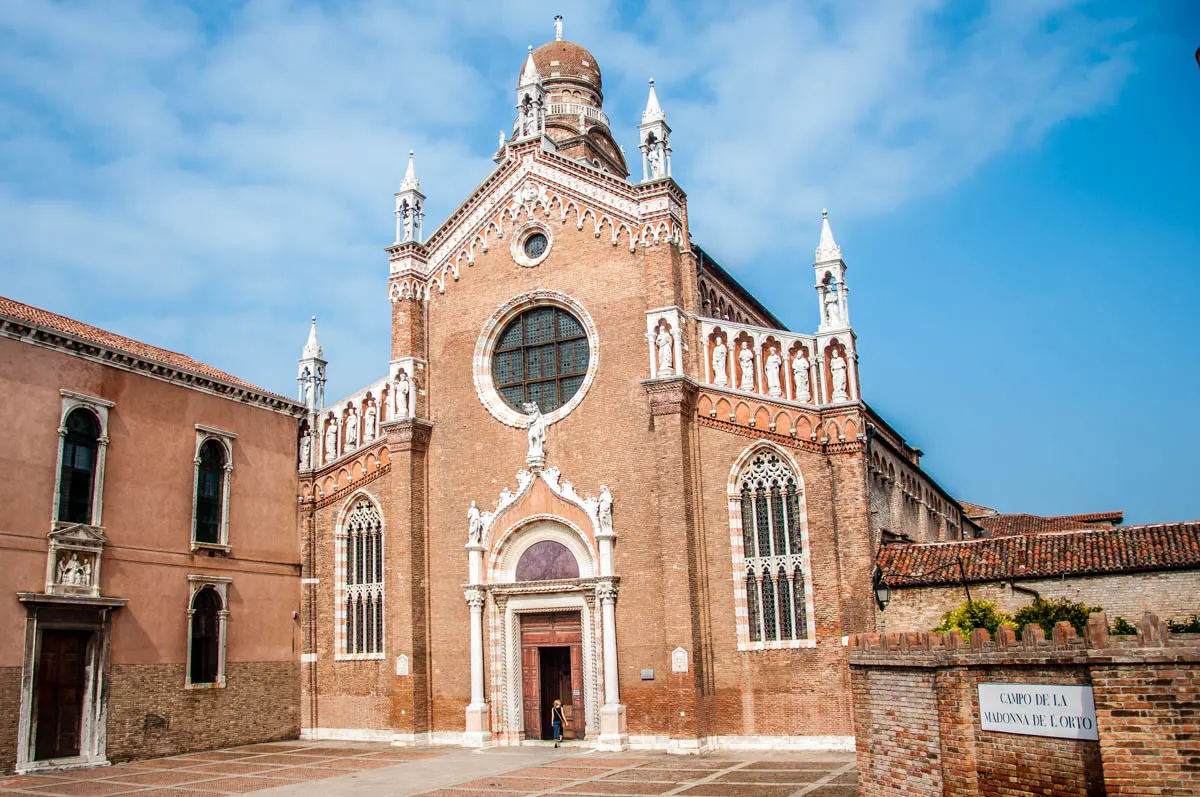
Church of Madonna dell’Orto – with its seemingly plain yet very elegant facade, there are many reasons to visit this church on the side of a quiet canal in the sestiere of Cannaregio.
One is that one of the greatest painters of Venice – Tintoretto – is buried here. You can also admire several of his works during your visit.
The other reason is the miraculous statue of the Madonna dell’Orto. It was made by the local sculptor Giovanni de Santi in the 14th century. He put the statue in his garden (orto in Italian) after it was rejected by the priest of the church which at the time was dedicated to St. Christopher Martyr.
The wife of the sculptor noticed that the statue would glow in the night. Soon people started to arrive in their droves to worship it as they considered it miraculous. The statue was placed inside the church on 18th June 1377 and soon afterward its name was changed to the Church of Madonna dell’Orto (Madonna of the Garden).
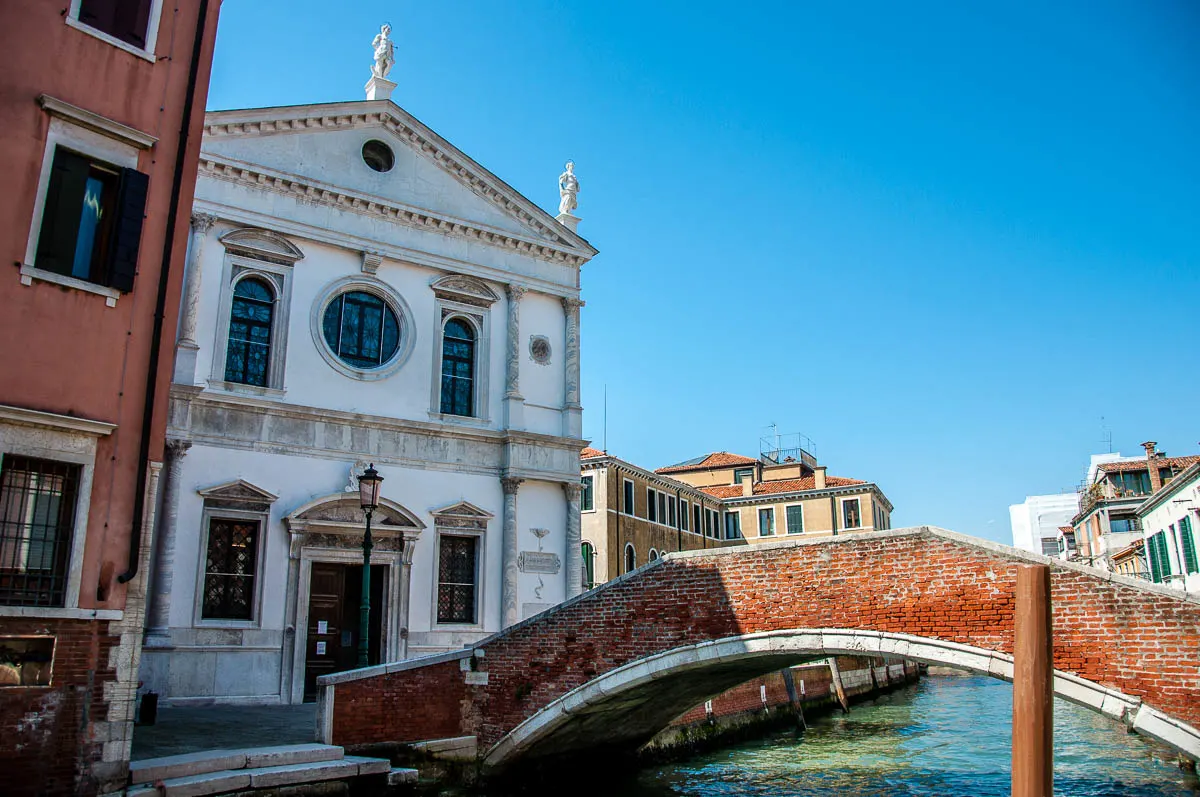
Church of San Sebastian – a must-see for all lovers of Paolo Veronese’s art. This church in the sestiere of Dorsoduro is covered in frescoes authored by Veronese over many years in the 16th century. The great Renaissance painter is buried here, too.
The church itself was initially an oratory and then converted into a church in the 15th century. It is dedicated to St. Sebastian – a protector against the plague – after the local residents survived a devastating bout in 1464.
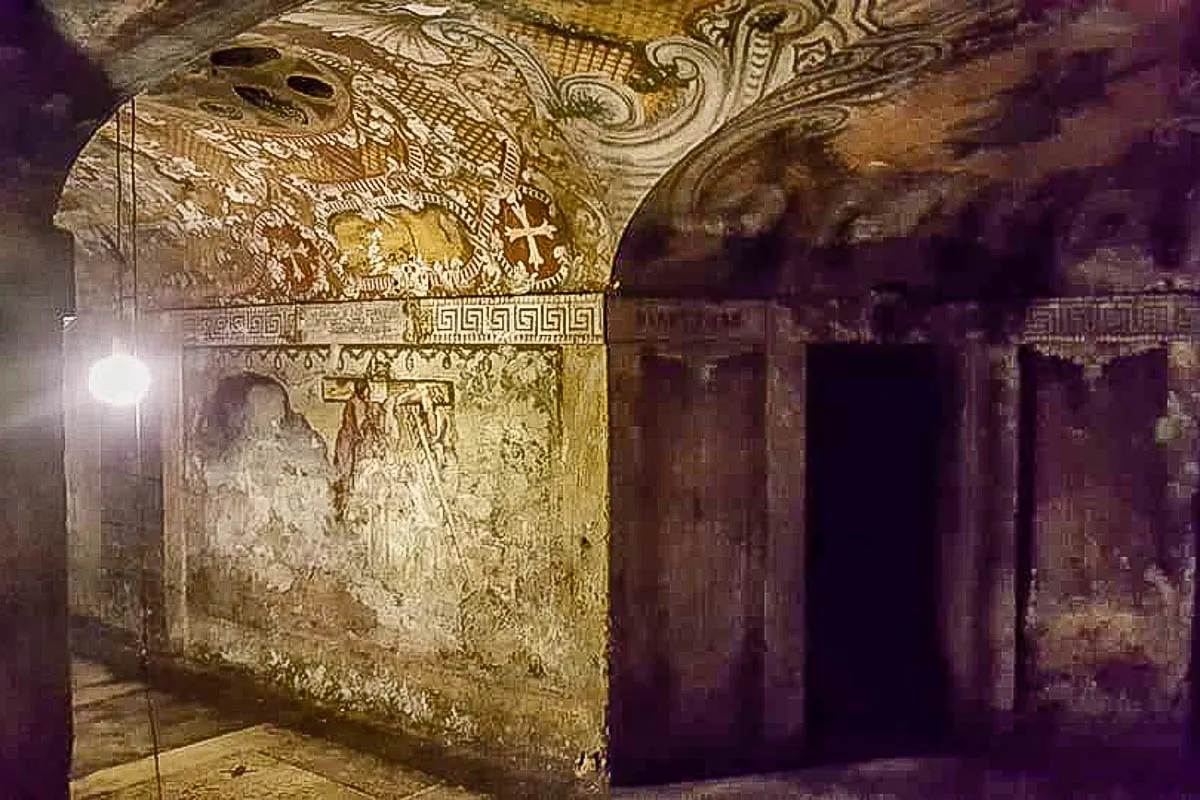
Church of San Simeon Piccolo – this is the first Venetian church you see as you walk out of the city’s Santa Lucia train station. With its impressive dome and on the edge of the Grand Canal, the church is a curious sight. Most visitors to Venice are perfectly content to see it only from the outside. Scroll up and you will see a picture of it right under the heading ‘Churches, Temples & Religion’.
If you go inside though you will soon discover one of Venice’s most intriguing hidden gems – a frescoed crypt that you can explore for a small charge. The custodian will give you a lit candle to hold in hand as the crypt is very dark.
The crypt has 21 chapels covered with frescoes depicting scenes from the Last Judgement and the Old Testament. Eight of the chapels are walled up and have not been explored. Inside the other chapels, there are tombs of local parishioners. Click here to see some more photos of this crypt and read my impressions of my very first visit to it.
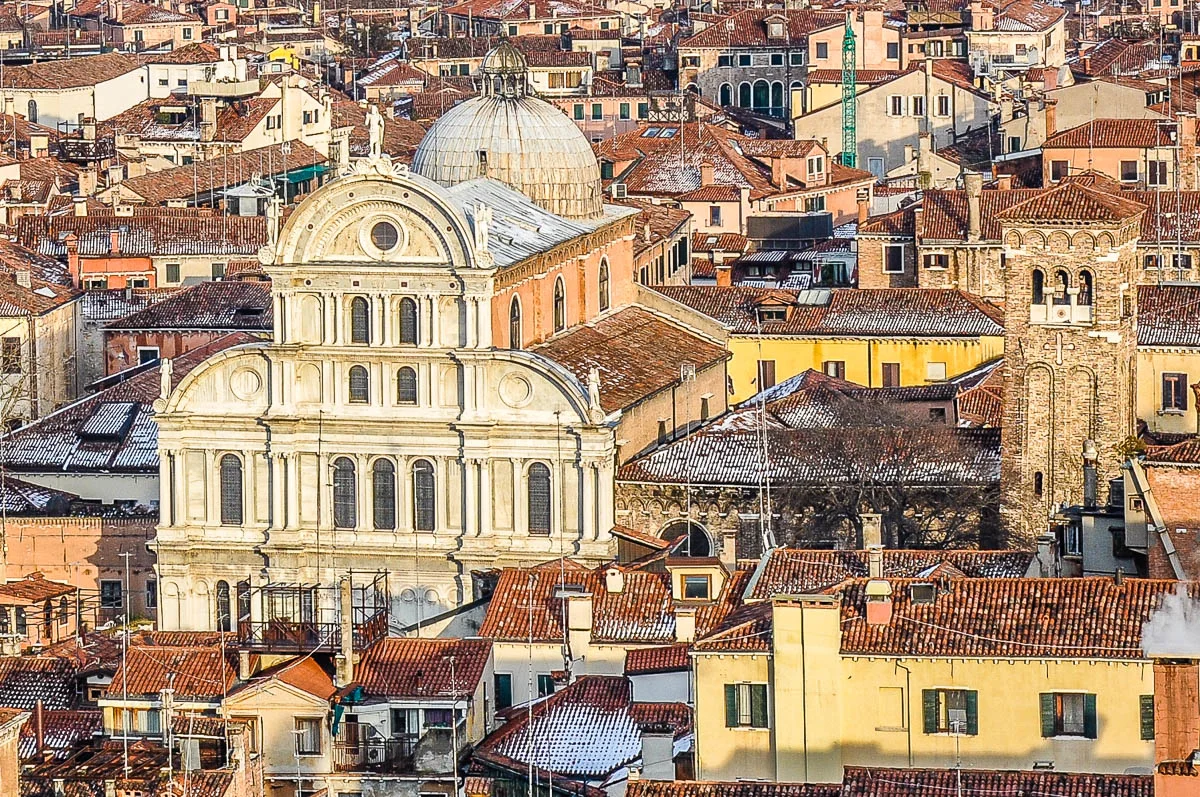
Church of San Zaccaria – the 15th- century Church of San Zaccaria is only a short walk away from St. Mark’s Basilica. It has an incredibly rich collection of art with works by Giovanni Bellini, Tintoretto, Anthony Van Dyck, and Giandomenico Tiepolo.
The church also has a crypt which, nowadays, is permanently flooded. It houses the tombs of eight of the earliest Venetian doges. In 1105 a terrible fire destroyed the original church that stood above the crypt together with the adjacent monastery. It’s said that over 100 nuns perished while sheltering in the crypt.
Church of Sant’Antonin – this church in the sestiere of Castello has a curious story about a runaway elephant seeking shelter in it. Today, the only ‘elephants’ you could see around Venice are the huge cruise ships that keep besieging the city on water. Yet, in the past centuries, real elephants would sometimes come to Venice as part of a circus or a travelling show.
There is a tragic story about an elephant in Venice which in 1817 or 1819 (sources differ) managed to escape its cage on Riva degli Schiavoni and trampled through the streets of Castello. The terrified animal caused much damage along the way like a broken entrance door, destroyed wooden staircase and even a toppled over well.
Terrified Venetians ran to hide and a group of soldiers pursued the elephant with their rifles. Finally, the elephant ran inside the Church of Sant’Antonin where its foot broke through a tombstone thus impeding the animal’s further escape. The elephant was caught and, unbelievably from our modern point of view, it was condemned to death. The animal was executed on St. Mark’s Square with a hand cannon called culverin.
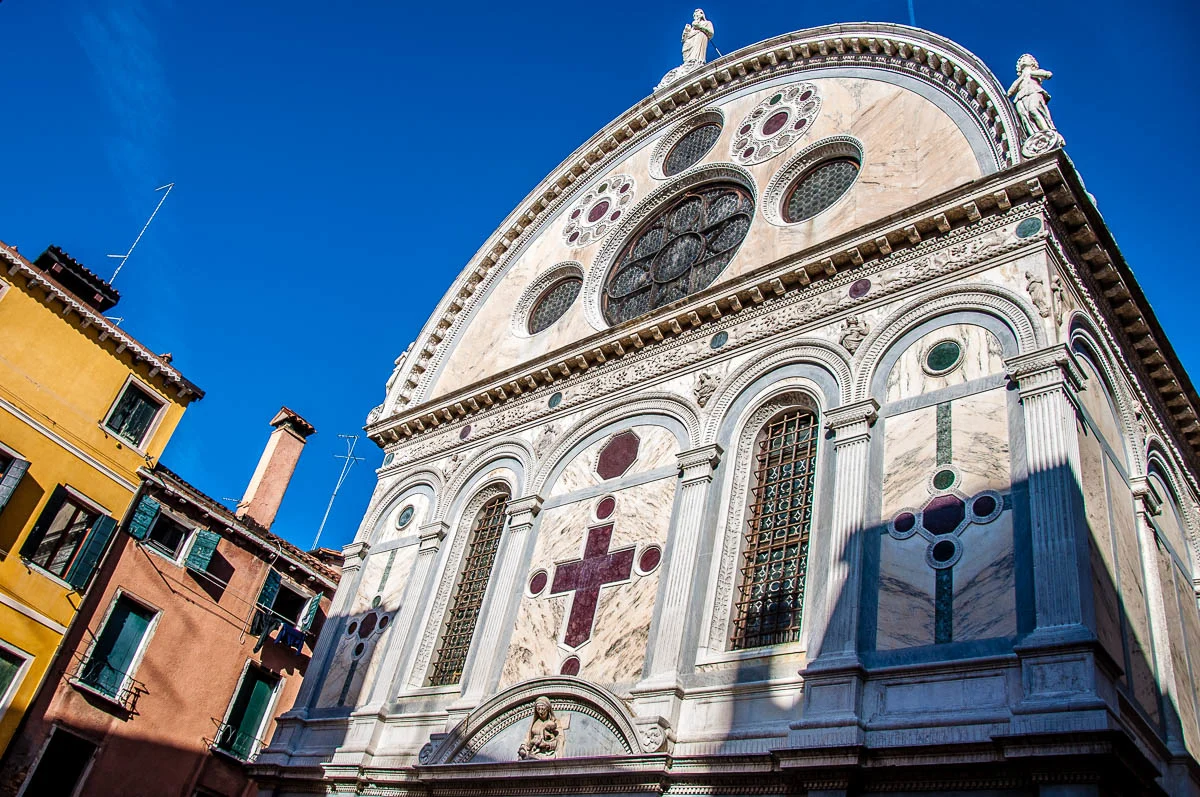
Church of Santa Maria dei Miracoli – a beautiful church that looks akin to a jewellery box. With a richly decorated marble facade, it’s a must-see for anyone interested in the Venetian Renaissance. You will find it in the sestiere of Cannaregio.
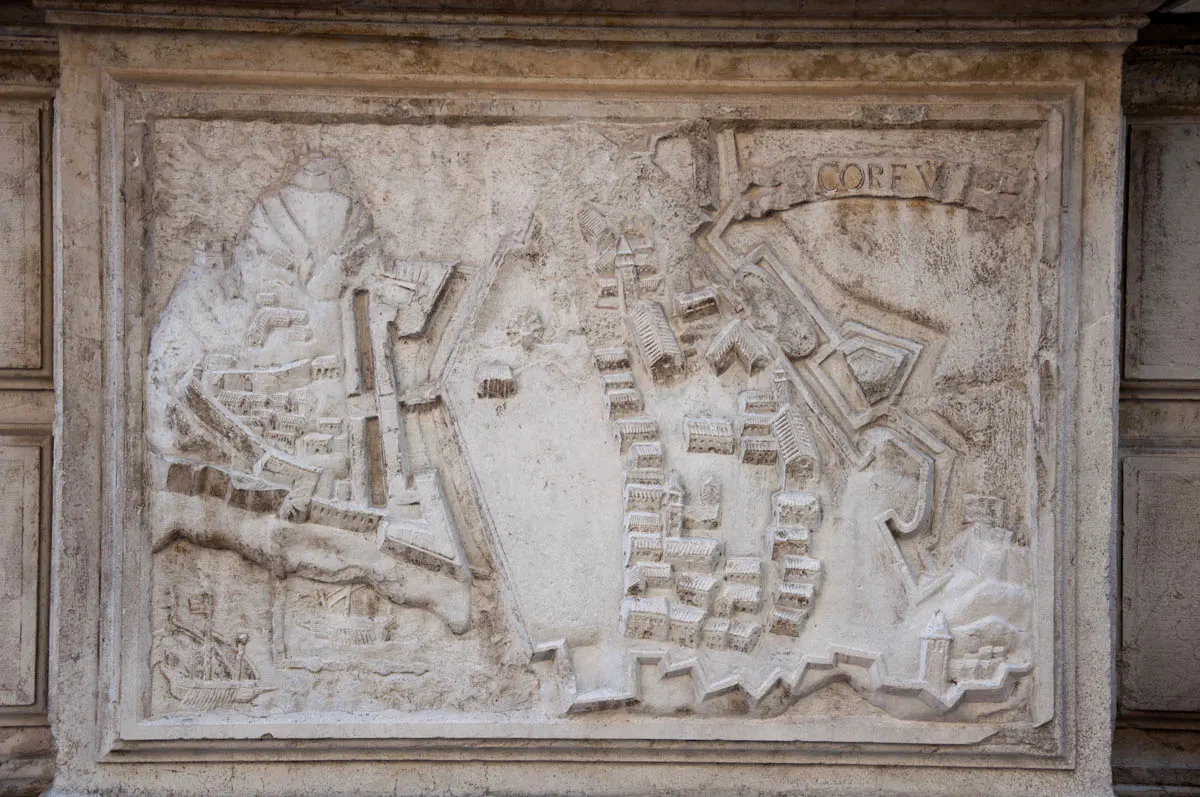
Church of Santa Maria del Giglio – in a city where lavishly decorated churches abound, the heavily embellished marble facade of this particular church in the sestiere of San Marco stands out with a curious detail. If you look closely, you will see that maps of actual cities have been chiseled out in the stone. Padua, Rome, and Corfu are some of them.
The church has ancient origins, having been first erected in the 9th century. It was then rehauled in the 17th century. Its Venetian Baroque facade honours the five Barbaro brothers, a patrician family from Venice, who sponsored the rebuilding of the church and quite scandalously turned its facade into a personal memorial to themselves.
The mapped cities on the facade are the places where one of the brothers. Antonio Barbaro, worked in service of the Republic of Venice.
Oratorio dei Crociferi – a small oratory next to an ancient almshouse and opposite the Church of Santa Maria Assunta (also known as the Church of I Gesuiti) in the sestiere of Cannaregio. Its interior is covered with a beautiful pictorial cycle by the Venetian Renaissance artist Palma the Younger.
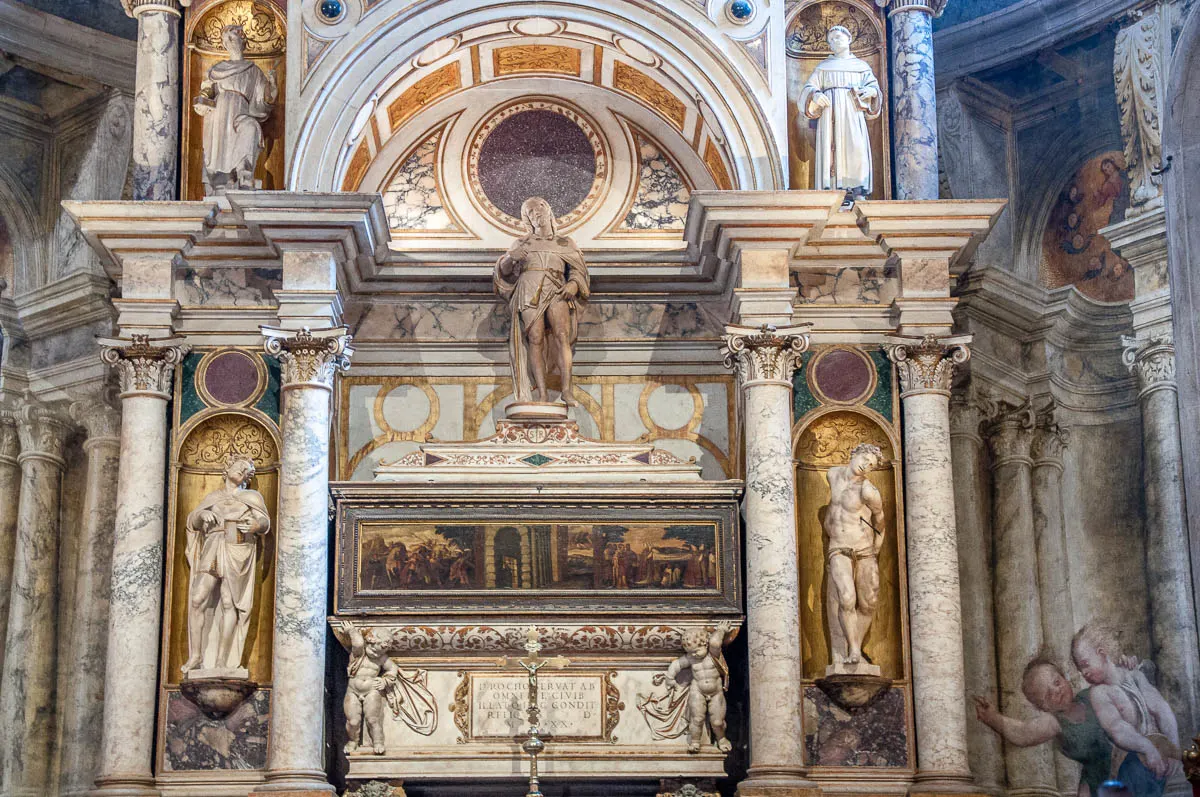
Relics and Reliquaries – there are many Christian relics that are preserved in Venice. Among them are:
- A nail from the True Cross in the Church of San Pantalon in the sestiere of Dorsoduro
- Relics of St. Mark – Patron of Venice. Under point I in this blog post you will find recounted succinctly the story of how the Saint’s relics ended up in Venice.
- St. Catherine of Siena’s foot in the Basilica of Santi Giovanni and Paolo in the sestiere of Castello
- St. Lucy’s body in the Church of San Geremia in the sestiere of Cannaregio
- St. Roch’s body in the Church of San Rocco next door to the Scuola Grande di San Rocco in the sestiere of San Polo
- St. Theodore’s body in the Church of San Salvador in the sestiere of San Marco
- St. Valentine’s hand in the Church of San Samuele in the sestiere of San Marco
- The Treasury of the Scuola Grande di San Rocco is where a monumental Reliquary of St. Andrew’s finger and a Reliquary of St. Roch’s finger are preserved
- The Treasury of the St. Mark’s Basilica holds many important Christian relics. It is said that among them are a piece of the True Cross, Milk of the Virgin Mary, the Blood of Christ, Holy Thorn, Nail of the True Cross, three rocks used to stone St. Stephen, the skull of St. John The Baptist, and an arm of St. George
Sotoportego della Madonna – a hidden corner of Venice with a curious story attached to it. A sotoportego is one of Venice’s most characteristic urban elements. It’s basically a passageway that goes underneath a building. You will find this particular sotoportego between Campo Sant’Aponal and Campiello Meloni in the sestiere of San Polo. It is believed that Pope Alexander III slept there during his first night in Venice after being chased by the spies of the Holy Roman Emperor Frederick Barbarossa.
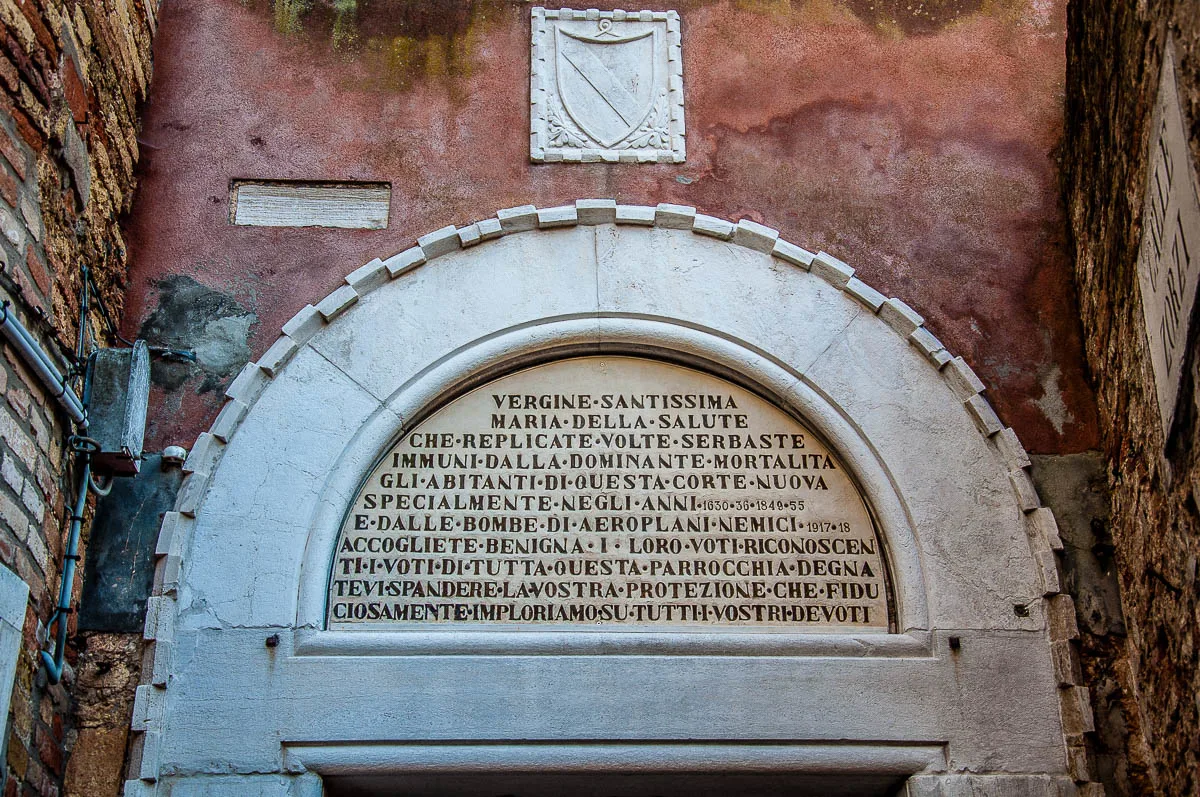
Sotoportego di Corte Nova – a votive shrine on Calle Zorzi in the sestiere of Castello. It is believed that a miraculous image of the Virgin Mary there saved the local residents from several bouts of the plague and World War One bombs.
CRAFTS & SHOPPING
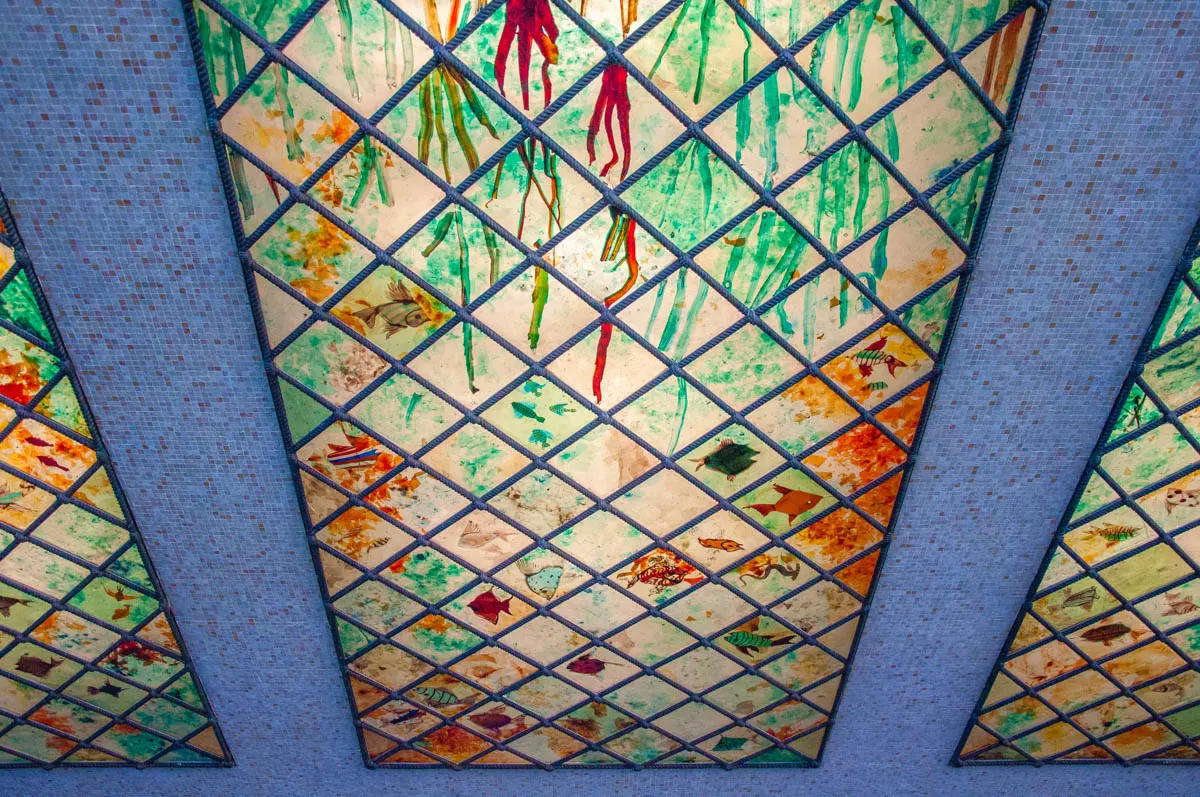
Venice is a paradise for the discerning shopper looking to find unique works of craft and art. Centuries-old workshops handmaking beautiful textiles, masks, perfumes, cosmetics, jewellery, glass objects, puppets, and lace are dotted all over the islands of Venice. Visiting them is like delving into a bygone world of excellent craftsmanship and original creations.
Here are some suggestions for places to visit in Venice in order to learn more about the history of the local crafts as well as some first-hand tried and tested small shops and artisan studios where you will gladly part with your hard-earned cash.
L’Isola di Pinocchio – the workshop of master craftsman Roberto Comin. He is famous for his handmade Venetian marionettes representing the typical characters of Commedia dell’Arte and famous historical figures.
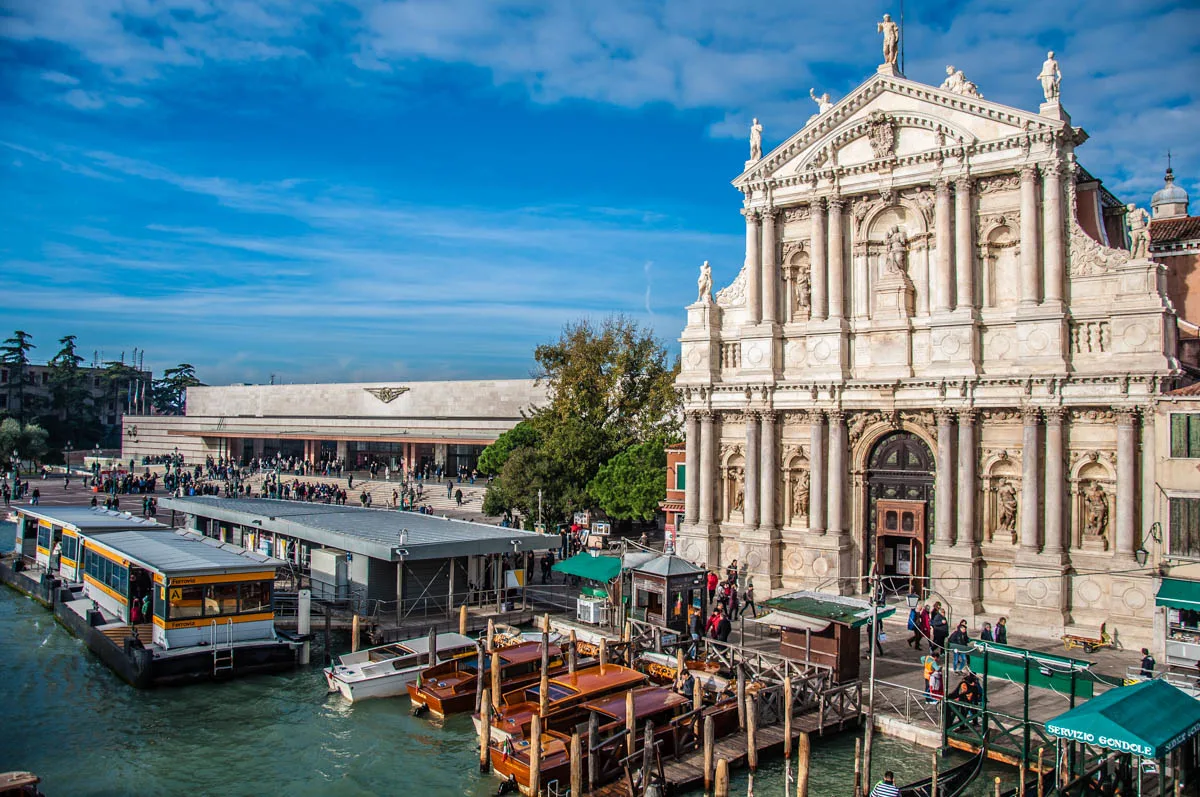
Monastic shop attached to the Church of Santa Maria di Nazareth (also known as Church of the Scalzi) – a wonderful treasure trove of products made in Italy’s monasteries. The Acqua di Melissa (lemon balm water) made by the brothers of the Order of the Discalced Carmelites is particularly famous. It has been produced at that spot in Venice for many centuries. You will find the church and its shop right next door to Venice Santa Lucia train station.
Murano Glass – traditional for Venice and with a rich historical heritage. Please, only purchase Murano glass items that have the trademark Vetro Artistico Murano. It guarantees that the items were made on the island of Murano in compliance with the existing laws. Here is a list of recommended shops.
Orsoni Mosaics – a historical Venetian furnace producing mosaics in more than 3,500 colours. It can be toured as part of a guided visit held a few times a year so advance booking is recommended. Orsoni Mosaics is in the sestiere of Cannaregio.
Plum Plum Creations – the artisan studio and shop of Venetian printmaker Arianna Sautariello. Plum Plum Creations is in the sestiere of Cannaregio.
Paolo Olbi – beautifully handmade items of marbled paper and leather. Right opposite the entrance gate of the University of Ca’ Foscari in the sestiere of Dorsoduro.
Rooms 48/49/50/51 of Museo Correr – four small rooms exploring the history of Venice’s traditional crafts and guilds in one of the most splendid museums in Venice.
San Maurizio Antiques Market – a wonderful antiques market that takes place in the sestiere of San Marco in Venice over a long weekend a few times a year.
Signor Blum – wonderful puzzles, creative objects, and whimsical toys. All made of wood. A very fun and colourful shop in the sestiere of Dorsoduro. Right next door to the Bridge of Pugni and the adjacent fruit and veg barge.
FAMOUS PEOPLE
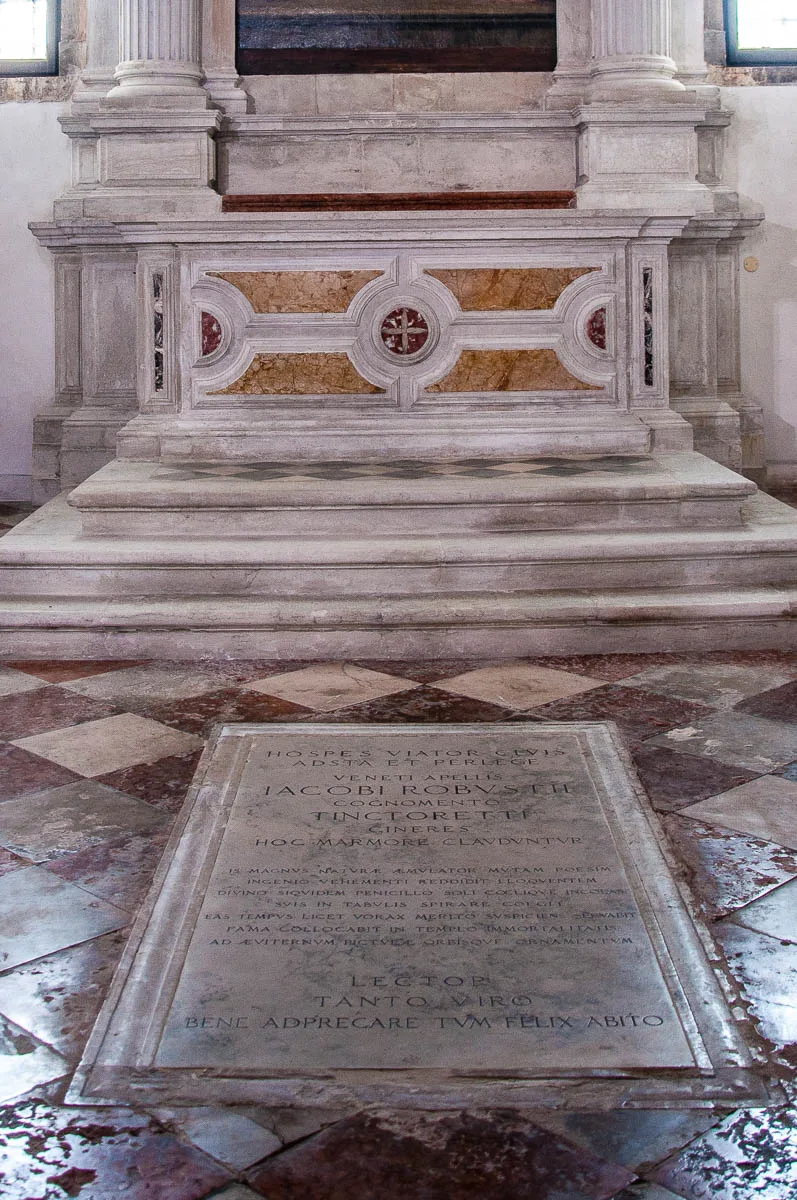
Many world-famous people called Venice their home.
They were either lucky to have been born here and then made it their life’s goal to do Venice justice in terms of their art or any other vocation they had. Under this option we have painters like Tintoretto and Canaletto and the composer Vivaldi.
Or, they for one reason or another reached Venice, fell in love with it and then made it their life’s mission to live and work there for a while or for a lifetime, surrounded by beauty and inspiration day after day. Among them are the painter Titian, the poet Lord Byron, and the patron of the arts Peggy Guggenheim.
So, to get close in spirit to some of the famous people who called Venice home for a little bit or their whole lives, head to these places and sights off the beaten track around the city on water:
Aldus Manutius’ House and Printing Office – Manutius was a humanist scholar and publisher who revolutionised the printing world. Born in 1449 in Bassiano near Rome, he arrived in Venice attracted by the freedom of speech that the Republic promoted and enjoyed. There, Manutius established the Aldine Press – a printing office specialised in the publication of Ancient Greek and Latin texts.
He published 132 books with some of them having a run of 3,000 copies – a significant number for that time. Manutius was also the first to introduce the italics font which owes its name in English on having been invented by an Italian.
Commemorative plaques have been placed on the facades of the houses where he lived and his printing presses operated on Rio Tera’ Secondo and Rio Tera’ San Paternian in Venice.
Canaletto’s Final Resting Place – visit the small Church of San Lio in the sestiere of Castello. Inside it is the tomb of Canaletto – one of the most famous artists who has managed to capture the allure of Venice on canvas. Giovanni Antonio Canal, better known as Canaletto, was born just around the corner of the Church of San Lio and was also baptised in it.
Caterina Cornaro’s Final Resting Place – born in the 15th century in a noble Venetian family Caterina married the King of Cyprus. After her husband’s death, she ruled over Cyprus as Queen of Cyprus, Jerusalem, and Armenia. She was forced to abdicate thus effectively gifting Cyprus to the Republic of Venice.
In appreciation, the Republic gave her the fiefdom of Asolo – a poetically pretty place in the hills of the Veneto. Caterina’s court soon became a magnet for poets, musicians, and artists.
Every September, Venice’s Historical Regatta starts with a splendid parade. It recreates the triumphal reception that the Republic of Venice staged for Caterina upon her return from Cyprus.
Caterina Cornaro’s monumental tomb is in the Church of San Salvador in the sestiere of San Marco.
Elena Cornaro Piscopia’s Birthplace – Born in Venice in 1646 to a peasant mother and a father with a high-ranking post, Elena was the first woman in the world to receive a PhD degree. She was a very interesting person with amazing for her time academic achievements.
Elena spoke seven languages (having learned Latin and Greek by the tender age of seven!). She then went to acquire Hebrew, Spanish, French, and Arabic in addition to her native Italian.
Elena also excelled at mathematics and astronomy and was particularly interested in philosophy and theology. In an age when the place of women was firmly at home, it is incredible how much Elena achieved.
Consider this – when she applied for a Theology Doctorate degree, her application was refused by the Church as in those days it was considered inappropriate for a woman to be a Doctor of Theology. Instead and only after applying for a second time, she was given permission to study for a Doctor of Philosophy.
In Venice you can see Elena’s birthplace – Ca’ Loredan. The building, near Rialto bridge, nowadays houses Venice’s municipal council.
Giovanni and Sebastiano Caboto’s House – a father and son navigators and explorers from Venice. In English, they are known as John and Sebastian Cabot. Giovanni was the first European to officially discover and explore the coast of North America and Canada’s Newfoundland. They are commemorated in Venice with a plaque on their former house on Via Garibaldi, 1642 in the sestiere of Castello.
Tintoretto’s House and Final Resting Place – one of Venice’s most illustrious sons, the artist Tintoretto is buried in the Church of Madonna dell’Orto in the sestiere of Cannaregio. His tomb is pictured above. Tintoretto’s favourite daughter Marietta is also buried here. She was an accomplished painter herself.
Just a couple of minutes away from the church stands the house in which Tintoretto was born and then lived in all his life. You will find it on Fondamenda dei Mori. There is a stone plaque commemorating the artist attached to the facade.
FOOD & DRINK
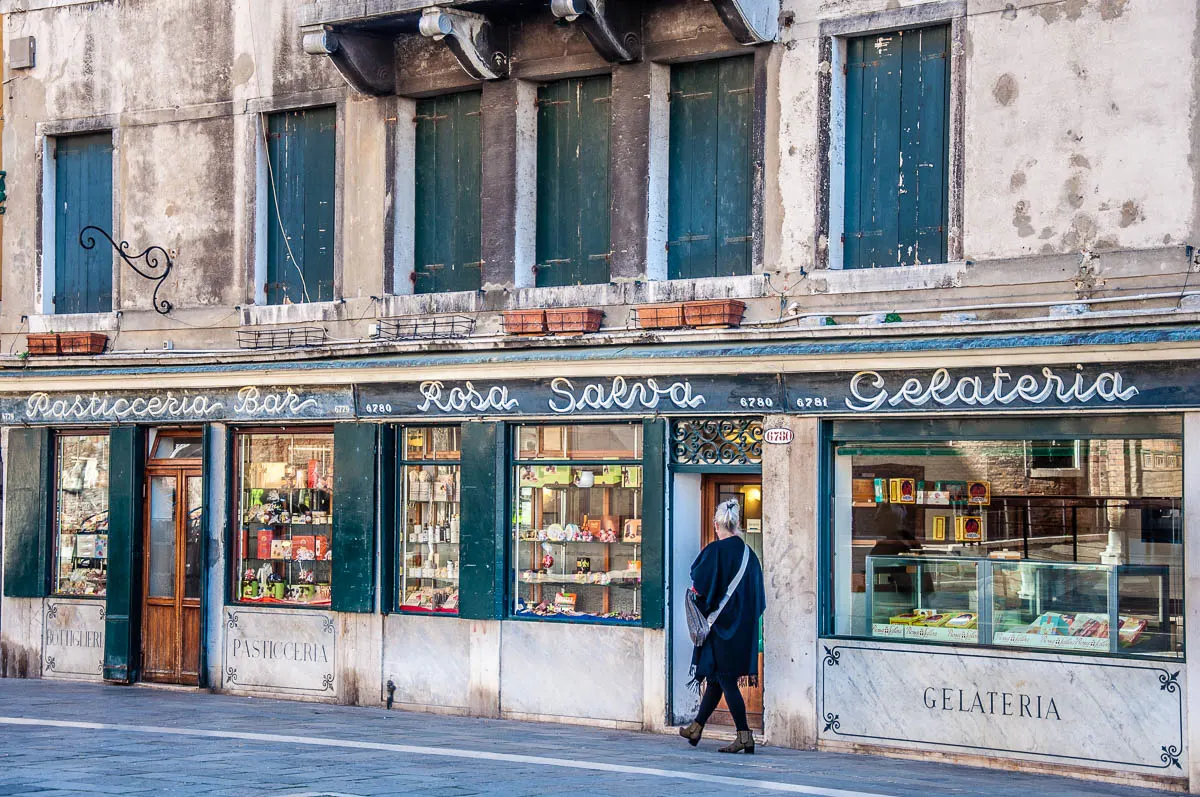
Venice has its own unique cuisine. Its development was stimulated by the bounty of fresh seafood provided by the Venetian Lagoon as well as by the historical trade connections that the Republic of Venice maintained with far-flung places across the West and the East.
So, come to Venice with an open mind and ready to experience dishes that may not quite correspond to what the world perceives to be strictly Italian food.
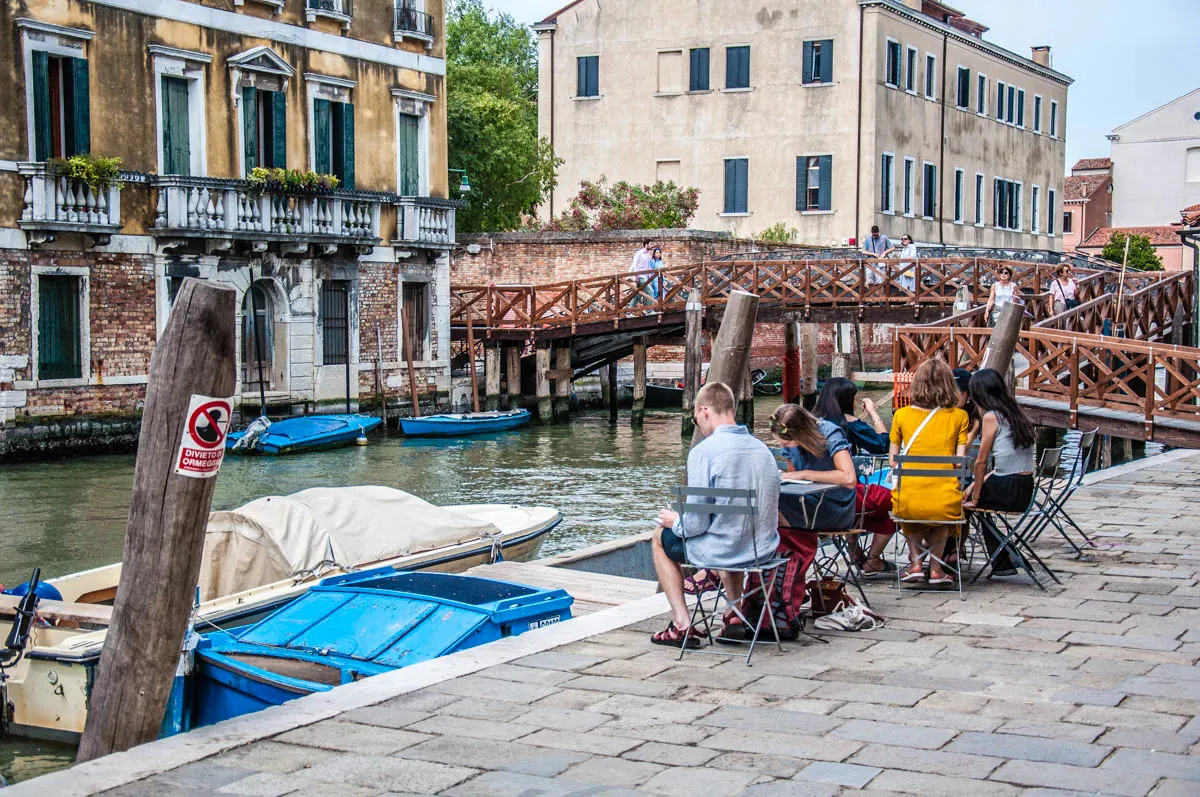
To help you along, here I have included some tips and suggestions both for traditional Venetian dishes and a few eateries around the city on water, where you can eat well without breaking the bank.
Baccala’ Mantecato – a typical Venetian dish that you will either fall in love with or passionately hate. Basically, this is creamed cod prepared with olive oil, laurel, lemon and a bit of garlic. It’s traditionally served with a slice of white or yellow polenta. The air-dried cod arrives all the way from the Lofoten Islands in Norway following a food route established almost 600 years ago.
Cichetti – traditional Venetian finger foods that you enjoy with a glass of wine colloquially called ombra. Venice’s bacari – small wine bars – serve a tantalising selection of cichetti. Visit Cantina do Mori. Founded in 1462, it is recognised as Venice’s oldest bacaro.
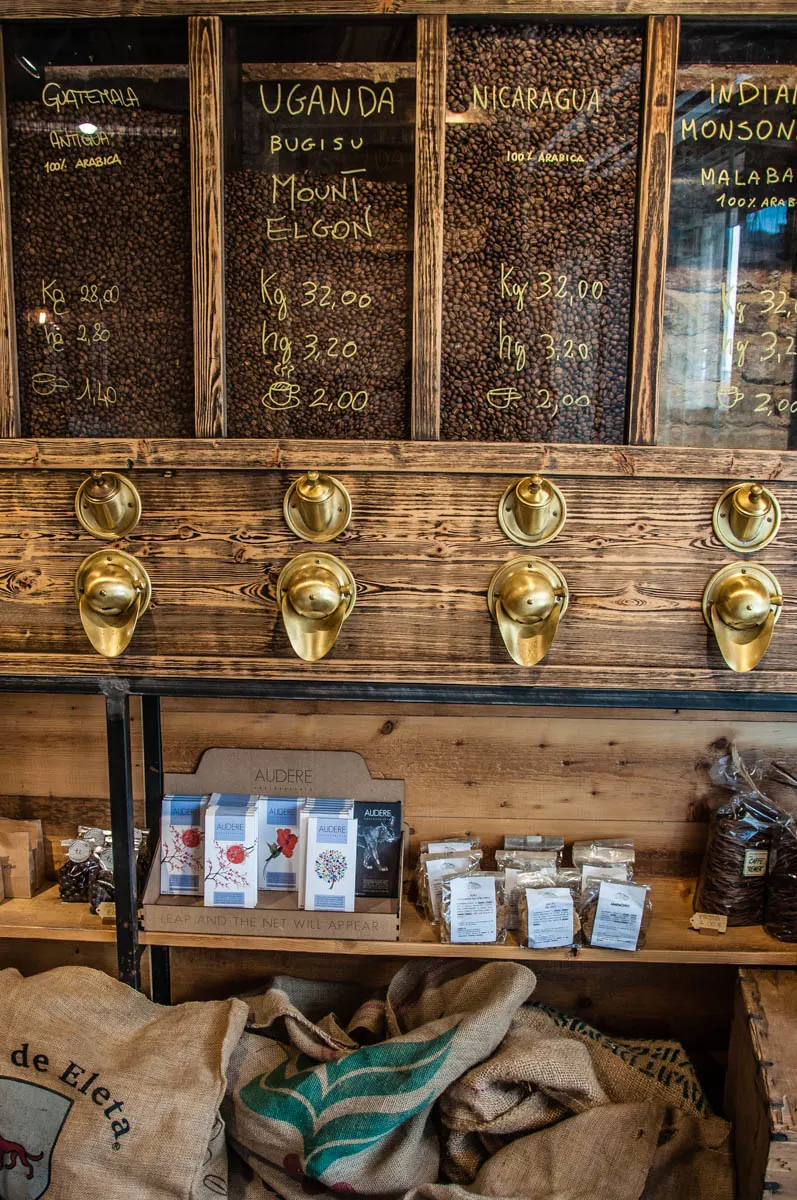
Coffee – the first Europeans to officially trade with coffee as consumer goods were the enterprising merchants of the Republic of Venice. Initially, coffee was sold for extortionate prices in the pharmacies as a remedy for the digestive tract. Soon appetite for the aromatic drink grew and in 1624 the first significant load of coffee arrived by boat in Venice.
In a few short decades, the Italian word caffe’ was coined and the new fashion of drinking coffee took over Venice and the rest of Italy parallel with Europe herself. Then the bottega del caffe’ – the prototype of the modern coffee shop – came on stage. Although it is widely thought that the first Italian coffee house opened in 1645, the first reliable documents cite 1683 when a coffee house opened at St. Mark’s Square in Venice.
So, make sure that you have excellent coffee when in Venice. Obviously, Cafe Florian is one of the most famous coffee destinations here. If you are a coffee aficionado, then definitely put it on your list to sample the coffees of one or more of Venice’s historic coffee roasters like Torrefazione Cannaregio, Antica Torrefazione Caffe Girani, and Torrefazione Marchi.
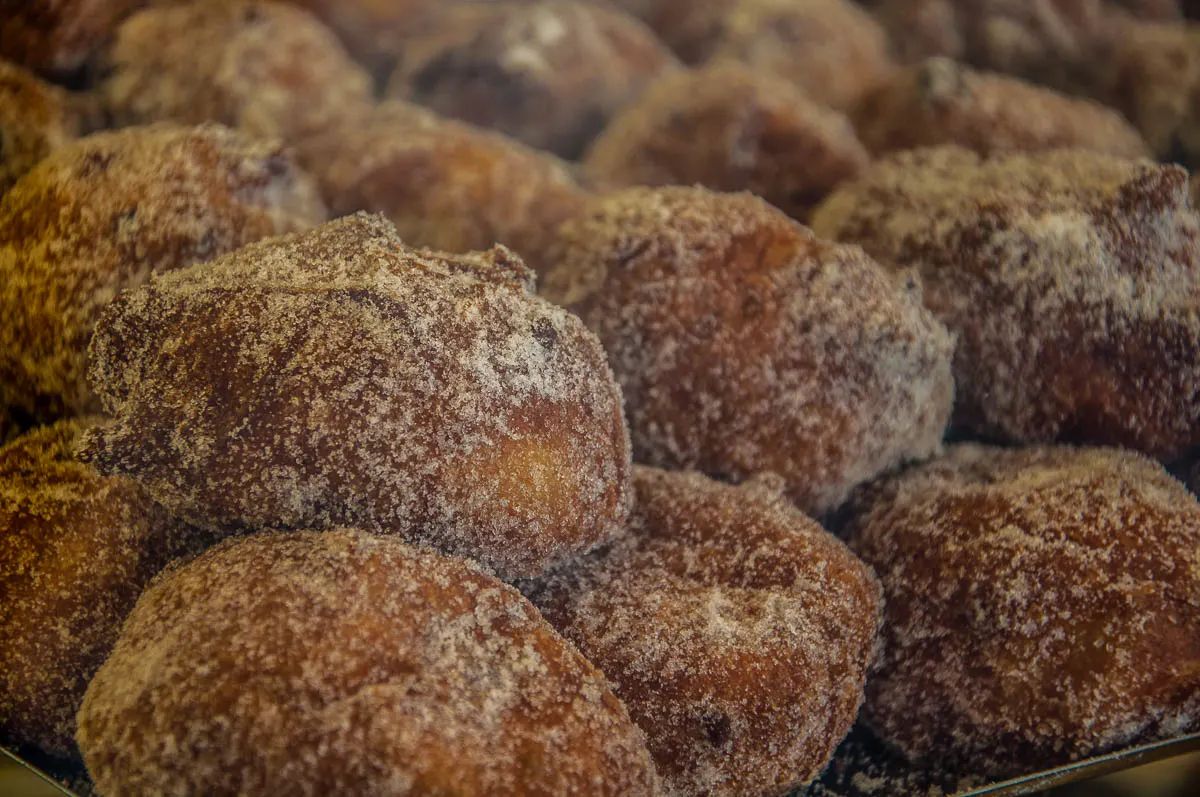
Frittelle – the undisputed Queen of the Venetian Carnival, a frittella is a fried dough ball either studded with raisins and pine nuts or stuffed with delicious cream. Sold traditionally right before and during the Carnival period, make sure that you try at least one or ten if you happen to be in Venice at that time.
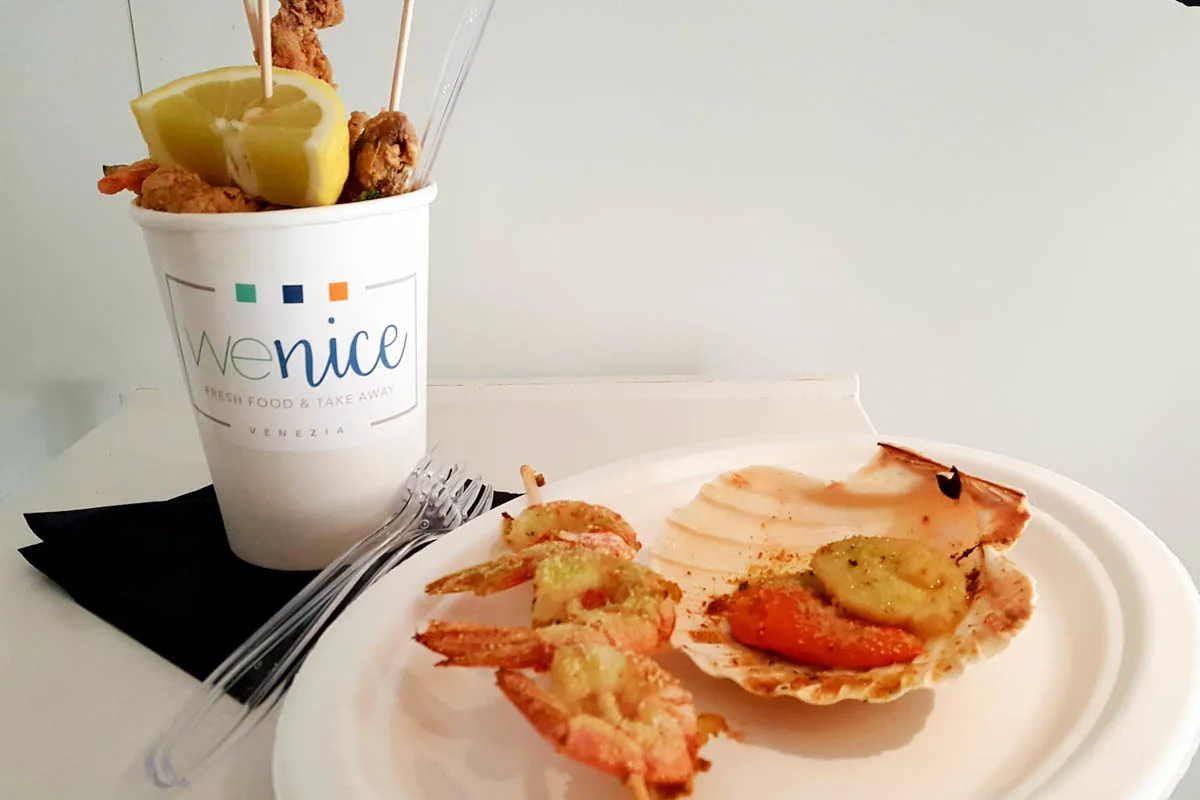
Fritto Misto – a lightly floured seafood mix that is fried in boiling hot oil and served with thick lemon wedges and a helping of polenta. Try the freshly prepared and inexpensive fritto misto at WeNice right next to Rialto Fish Market.
Risi e Bisi – if you are in Venice on 25th April, the Feast Day of the city’s patron St. Mark, then tuck into a delicious portion of peas with rice. The Doge himself would treat himself to risi e bisi each 25th April.
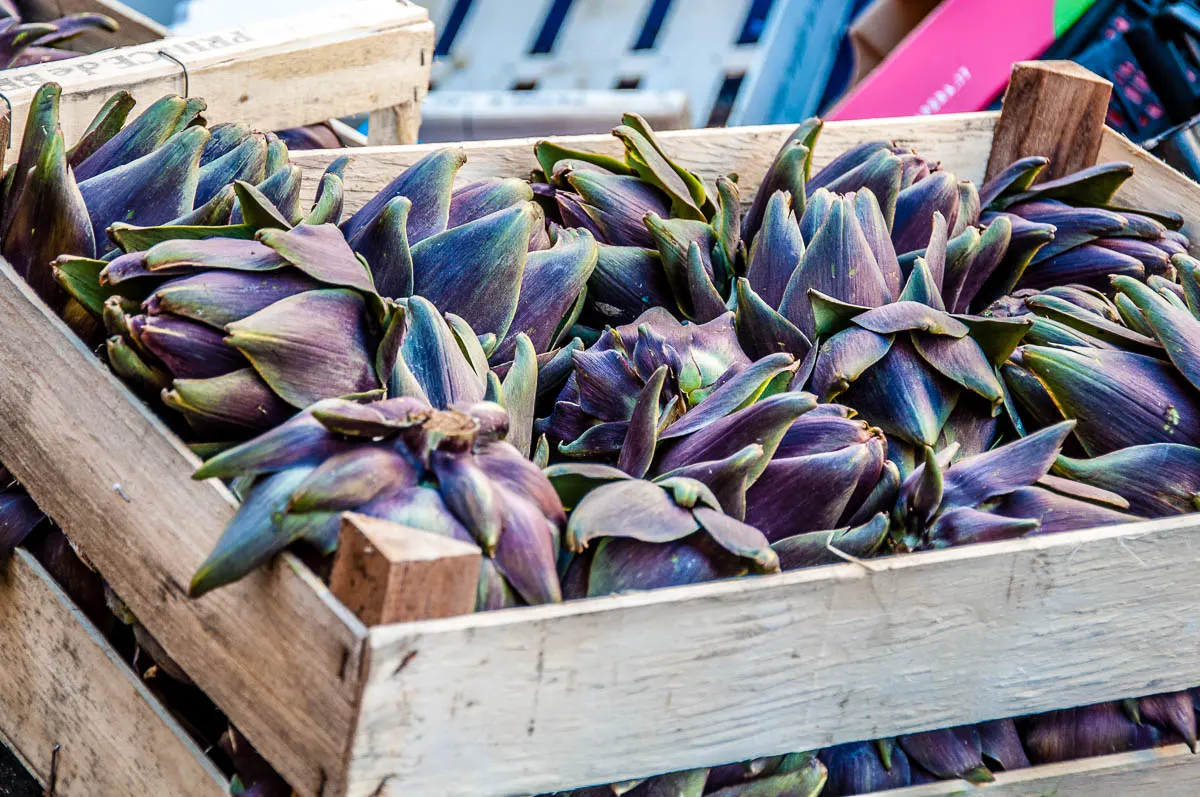
Purple artichokes – grown on the island of Sant’Erasmo. This is where Venice’s orchards, vineyards, and vegetable patches are carefully cultivated. Between the end of April and June, here grows the prized purple artichoke – a rare and delicate vegetable that is intrinsically connected to Venice and its traditional cuisine.
Saor – sweet and sour mix of onions, vinegar, currants, and pine nuts. It was invented to preserve food at sea for lengthy periods of time. Traditionally served with sardines, make sure that you try sarde in saor when in Venice.

Tramezzino – a triangular crustless sandwich which was invented in Turin but found its real home in Venice. Tramezzini come with different fillings and traditionally are so stuffed that they look pregnant in the middle. Bar Tiziano is a favourite tramezzini place for me in Venice.
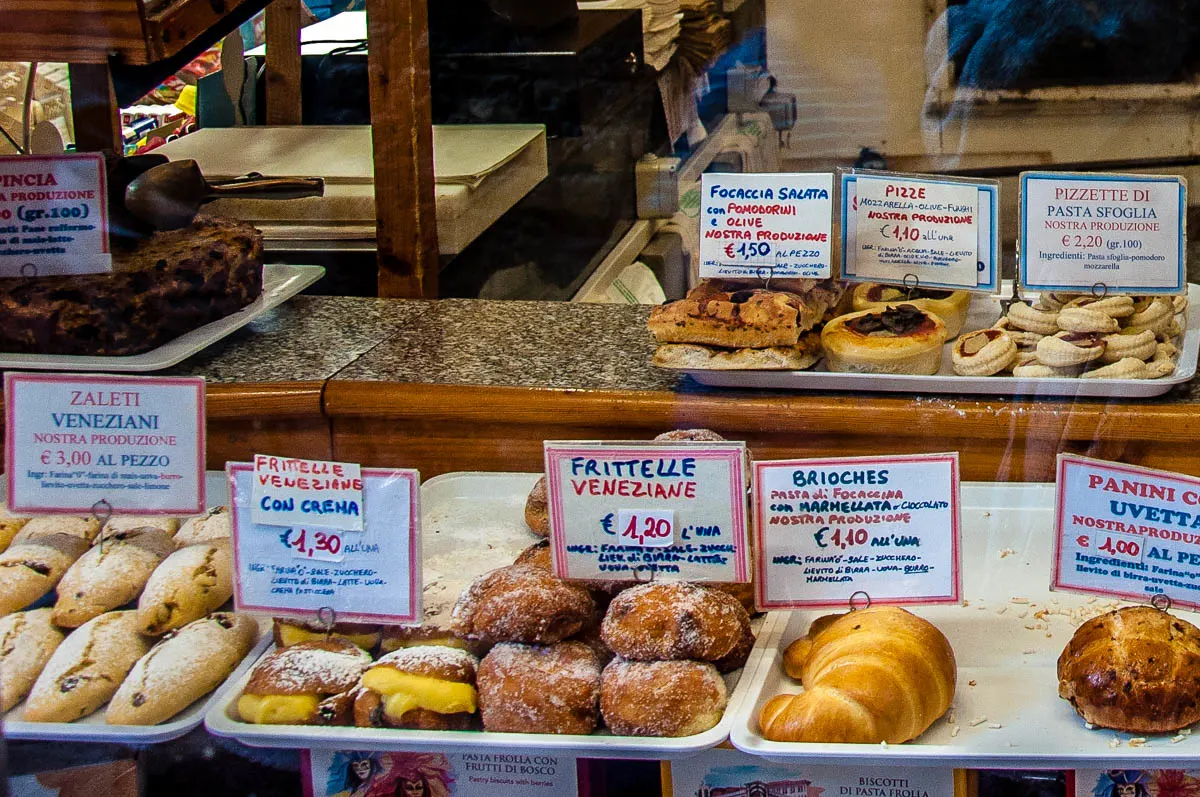
Venetian biscuits and desserts – zaletti (or zaeti), baicoli, pan del Doge, fugassa, pevarini… Many sweet delights are part of the Venetian cuisine. Sugar, after all (and just like coffee), conquered Europe via Venice, too. If you have a sweet tooth, spend some time in Venice’s patisseries. Two that I like are Pasticceria Rosa Salva (pictured under the heading ‘Food & Drinks’ above) and Pasticceria dal Mas.
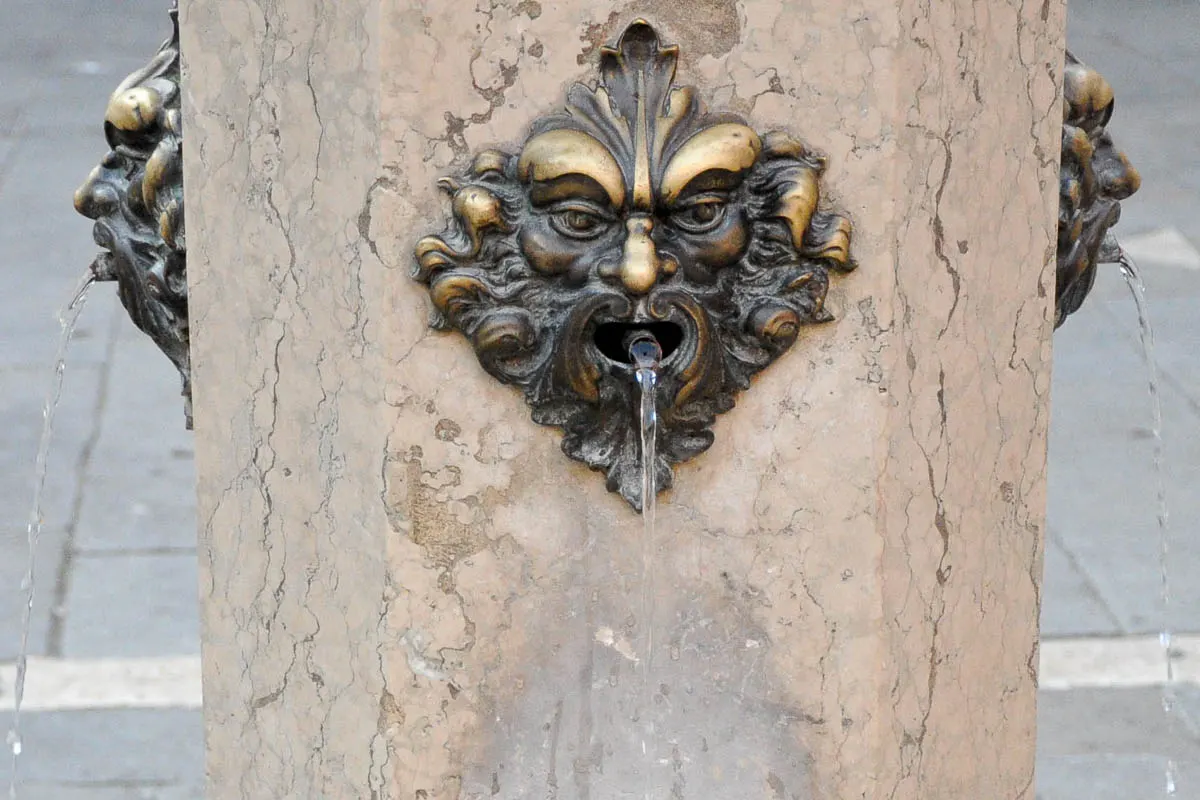
Water – fill up your water bottle from one of the hundreds of free water fountains which are dotted all over Venice’s squares. Splurge the money you have saved on something really special and handmade in Venice to remind you of your time in this unique city.
HERITAGE & CURIOSITIES
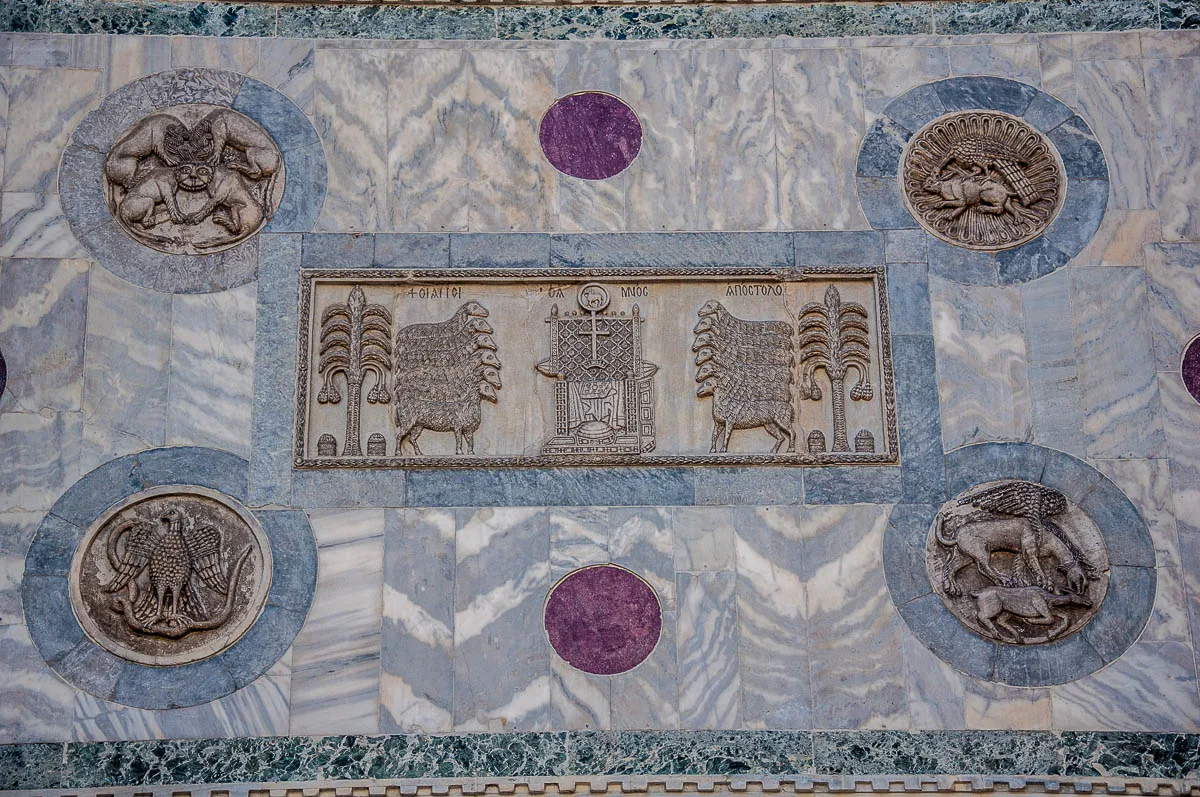
Built on islands and with canals instead of roads, Venice is a curiously unique place by virtue of its location in the Venetian Lagoon. In addition, its history spans hundreds of years and interconnects people and cultures across Europe, Africa, and Asia. In such a wondrous and unusual environment people adapted to life on water in many ingenious ways. Plus, they strongly felt the influence of the customs of the nations they traded and fought with through the centuries.
Thus Venice developed a rich heritage the knowledge of which nowadays helps us appreciate this unique city in a fuller, more authentic way.
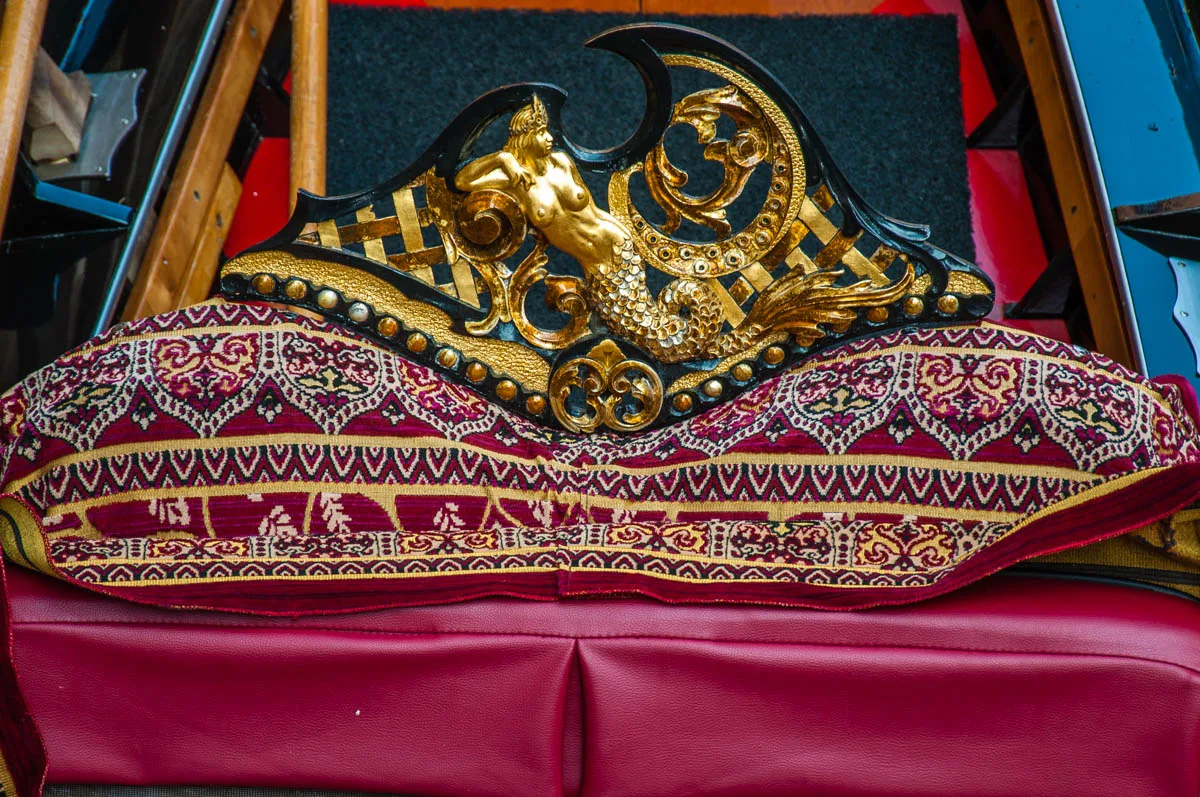
Here are some curious details shedding light on the unique reality of Venice and some of its more unusual sights. Some are hidden in plain sight right next to or as part of some of Venice’s most well-known places of interest. Others are standalone and tempt you to explore a part of Venice that is off the beaten track in an attempt to find them hiding in the thick labyrinth of streets and small campi.
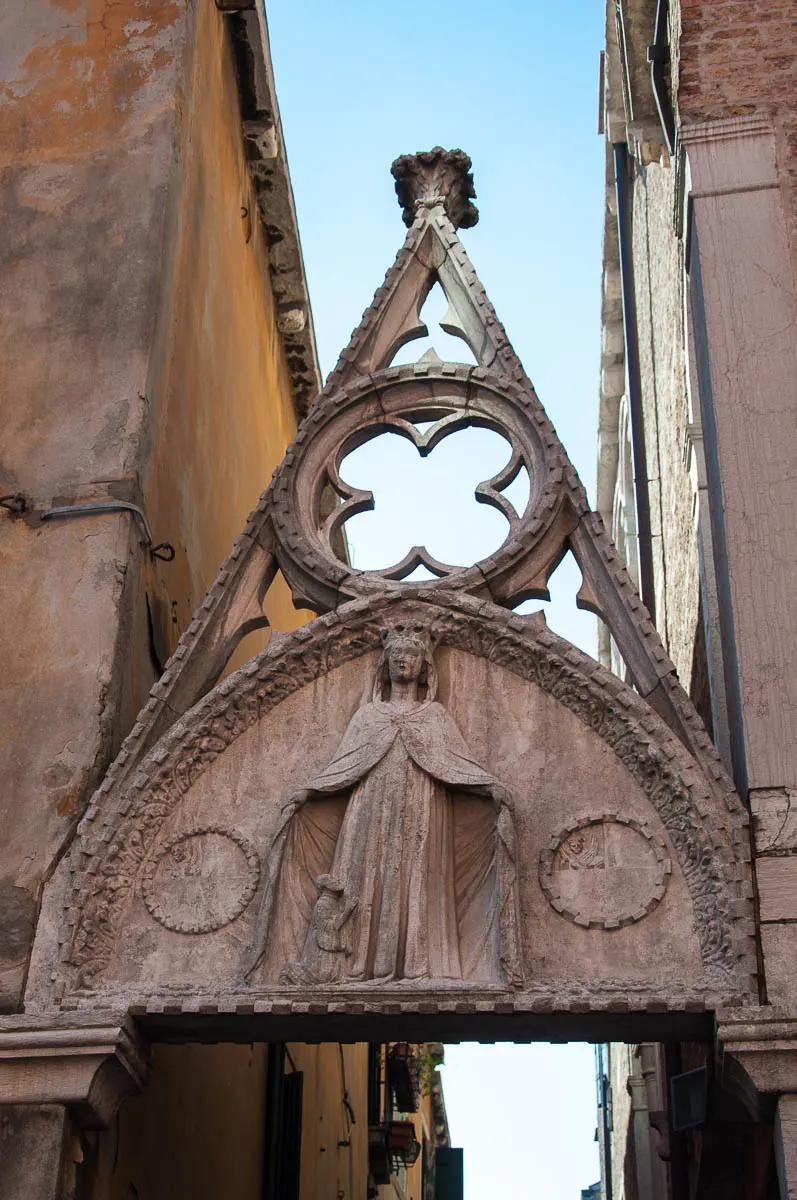
Arco del Paradiso – a triangular Gothic arch that crowns one end of Calle del Paradiso – one of Venice’s best-preserved medieval streets. Go for a walk along the street and admire its barbacani – the mighty wooden beams that stick over your head. They help expand the living space on the top floor of the ancient houses lining up the street.
Near Calle del Paradiso you can also visit the Church of San Lio to see the tomb of the artist Canaletto and also Campo di Santa Maria Formosa where you can have a nice and relaxed aperitivo before visiting the adjacent Fondazione Querini-Stampalia.
Bocca di Leone – on your walks around Venice, keep an eye out and see if you can spot one or more of these curious stone masks with disproportionately big mouths. Called lion’s mouths, they allowed the citizens of the Republic of Venice to report secretly but not entirely anonymously people suspected of breaking the laws.
For example, you can spot them in the Doge’s Palace and also there is one near the Church of San Martino in the sestiere of Castello and another near the Church of Santa Maria della Visitazione in the sestiere of Dorsoduro.
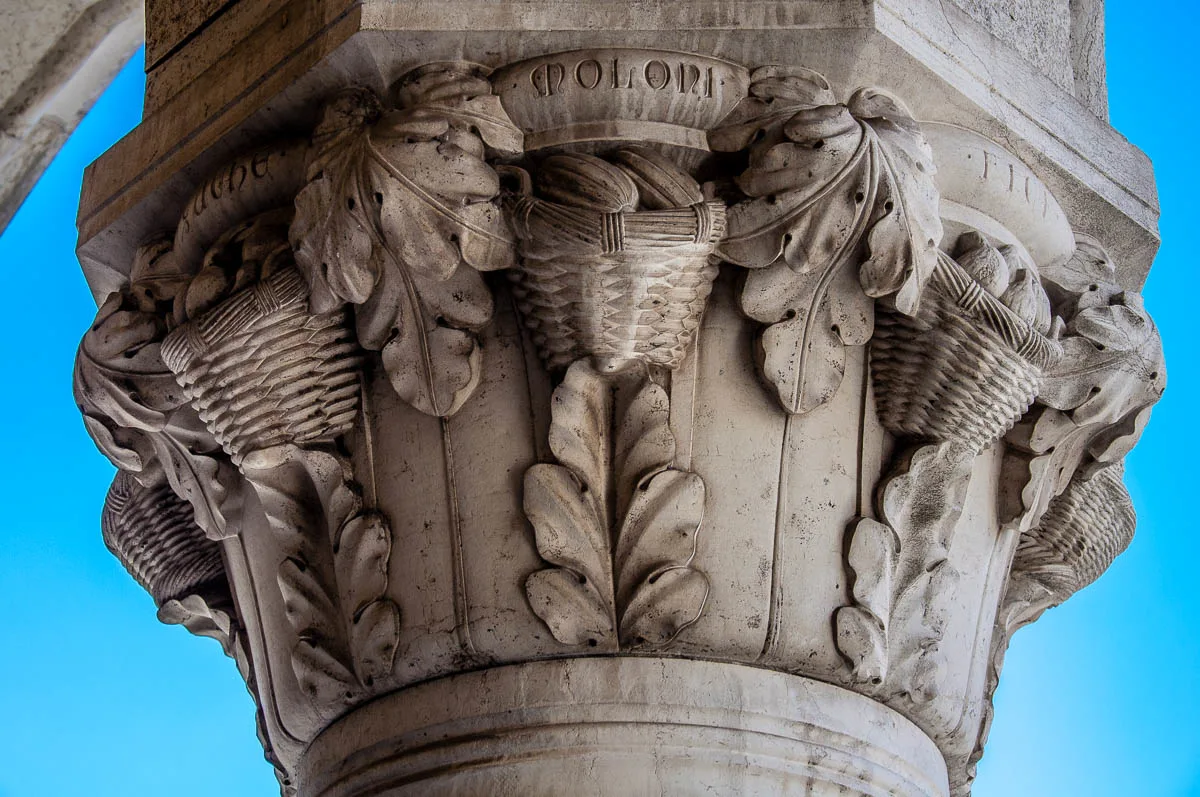
Capitals of Doge’s Palace – one of the most curious things about Venice’s beautiful and splendid Doge’s Palace is the series of images carved in the capitals of the columns of its ground-floor portico. Walk from column to column and keep your gaze up.
Soon, you will notice that each capital – carved of Istrian stone – tells its own story inspired either by everyday life or a Christian parable. For example, while one is completely dedicated to a rich harvest of local and exotic fruits, another represents the Christian virtues. The zodiacal signs are carved on a third and the seven deadly sins on yet another capital.
In total, there are over 600 images here!
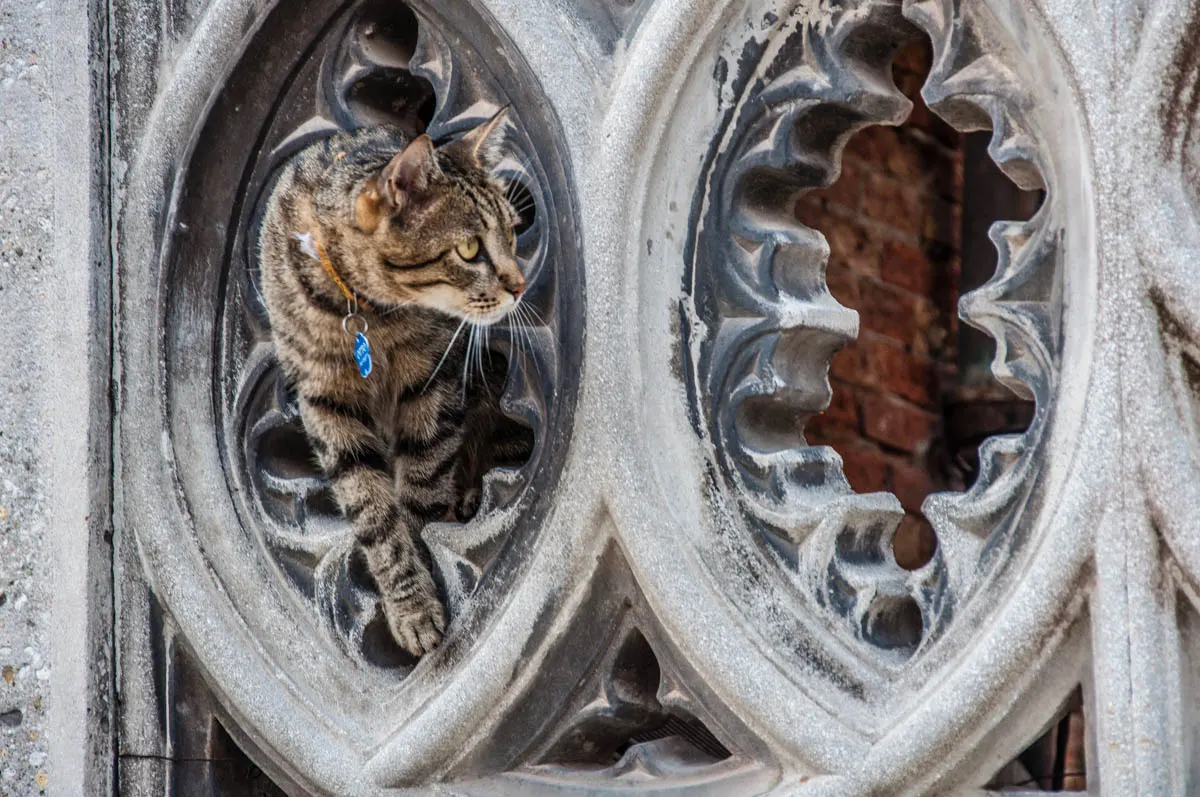
Cats of Venice – Stop for a moment on your off the beaten track walks around Venice and most probably you will spot a cat. Venetians love cats!
There is a long-standing connection between the felines and the city on water. It’s widely believed that by eating diseased rats the cats were instrumental in helping to curtail the devastating plague that had hit Venice in the 14th century.
Such was the fame of Venetian cats that even Shakespeare mentioned them in his play ‘The Merchant of Venice’.
Even Venetian doges loved cats. The Doge Francesco Morosini, for example, would take his cat with him everywhere, even when he would travel to wage war. When his cat died, Morosini had it embalmed with a mouse between its front paws. Nowadays, you can see the Doge’s cat in Venice’s Natural History Museum. For more stories about Venice and its legendary cats, check point 6 in this blog post about Venice.
Farmacia Ai do San Marchi – discover an old pharmacy on the top floor of Ca’ Rezzonico – the Museum of 18th Century Venice. Furnished with 18th-century furniture, majolica vases, and objects made of Murano glass, it provides a curious insight into what was considered the peak of the pharmaceutical knowledge at the time.
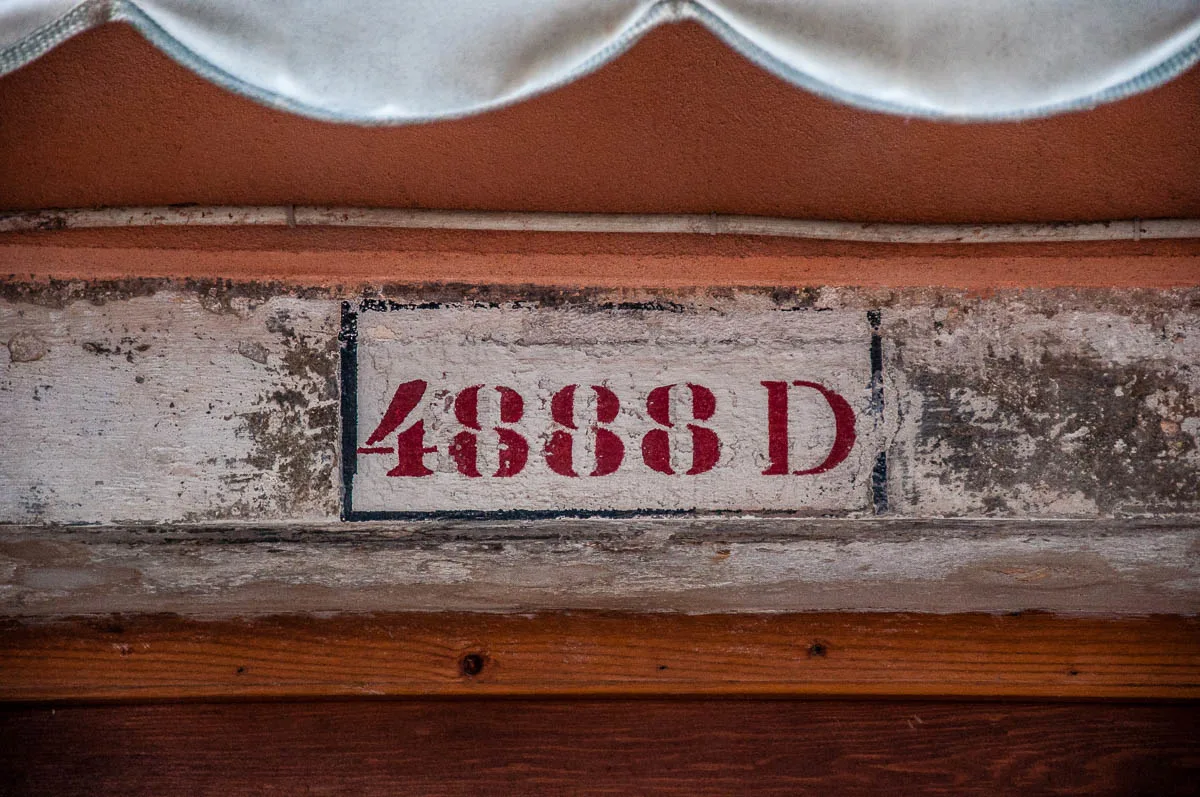
Four-Figure House Numbers – Walk around Venice and soon a curious thing will jump out at you. House numbers here can have as many as four figures. Like house number 3456 or house number 5562.
The reason for this is that instead of recommencing the numbering of the houses from one on each street, the Venetian house numbering system covers all the houses in one sestiere.
A sestiere (or one-sixth in English) is a term used to signify the districts of Italian cities and towns that were divided into six subdivisions. Venice is one such city and it has six sestieri: Cannaregio, Castello, San Marco, San Polo, Santa Croce, and Dorsoduro.
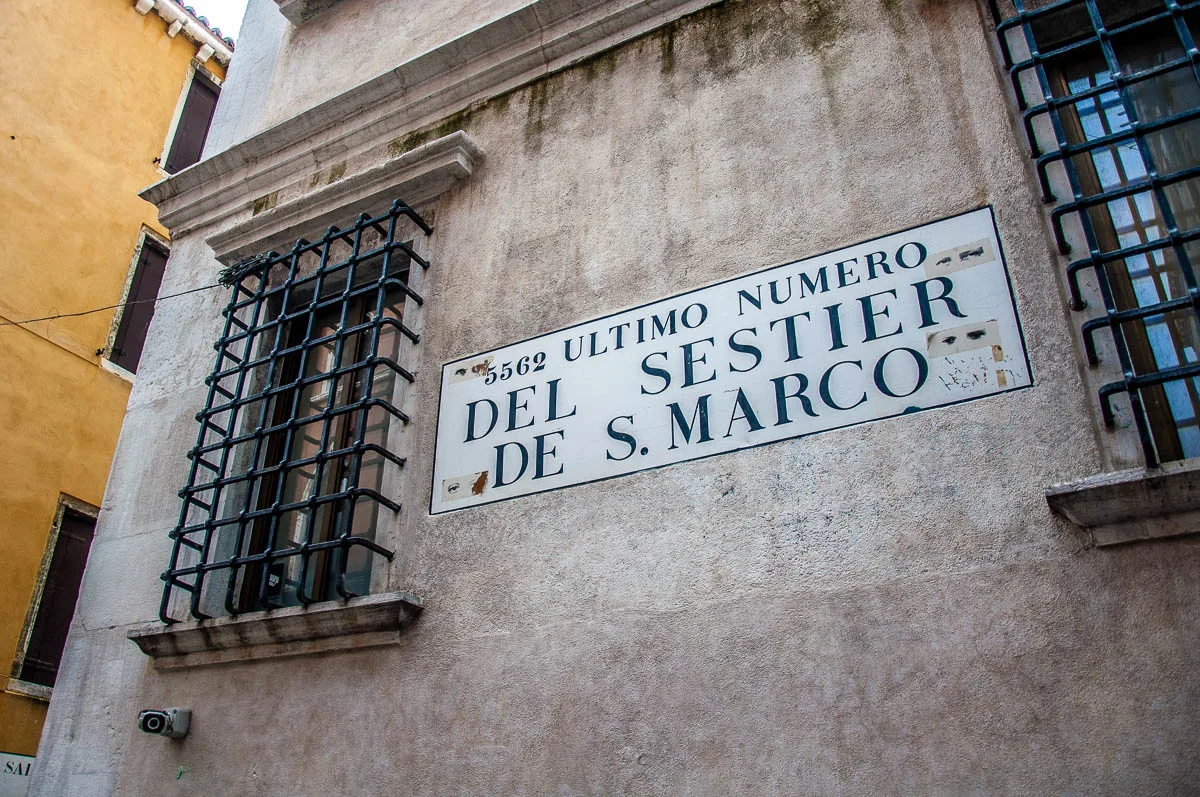
As you explore Venice, you may come across a large painted sign (called nizioleto) which indicates the last number of that particular sestiere. Take a photo of it as it is quite a curious thing of local culture and traditions.
Gobbo – just opposite the ancient Church of San Giacomo di Rialto, you may notice a small marble statue of a hunched man. There is a small platform resting on his shoulders and neck. On the back of the statue, you will see a small staircase that leads up to the small platform on top. This is the famous Gobbo of Rialto.
Gobbo in Italian means ‘hunchback’. The statue was made by the sculptor Pietro da Salo’ in the middle of the 16th century. The Gobbo was placed in the most frequented place in Venice – the Rialto Market – and it was used as a high spot from where the latest decrees and criminal convictions were read to the nobles, the merchants and the populace of the city on water.
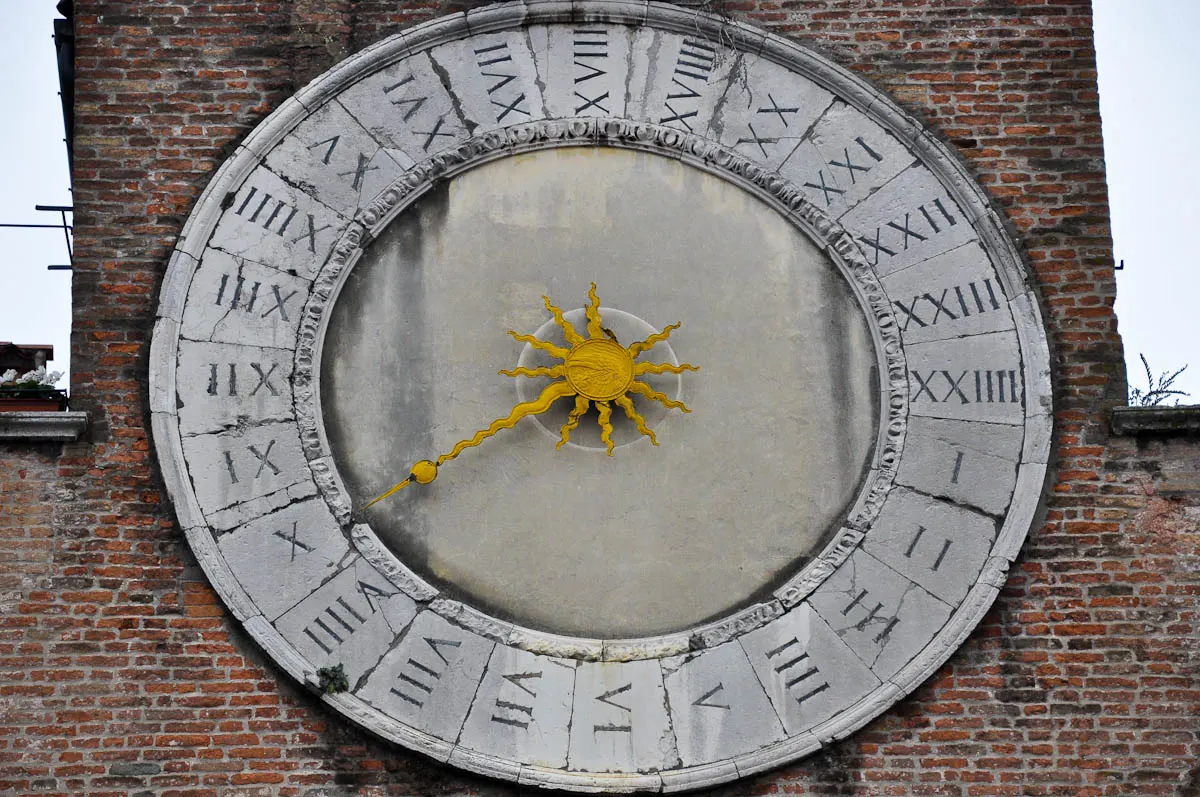
One Hand Clock – head to the Church of San Giacomo di Rialto, reputedly Venice’s oldest church, to see the large one hand clock on its facade. The clock dates back to the 15th century and looking at it, you will soon notice two more curious things about it, too.
One is that the clockface is divided into 24 hours (instead of 12 as it is customary nowadays). The other is that the fourth hour is represented as IIII instead of as IV.
The most curious thing about this clock though is that through the centuries it’s been the subject of many local jokes because it was rarely on time.
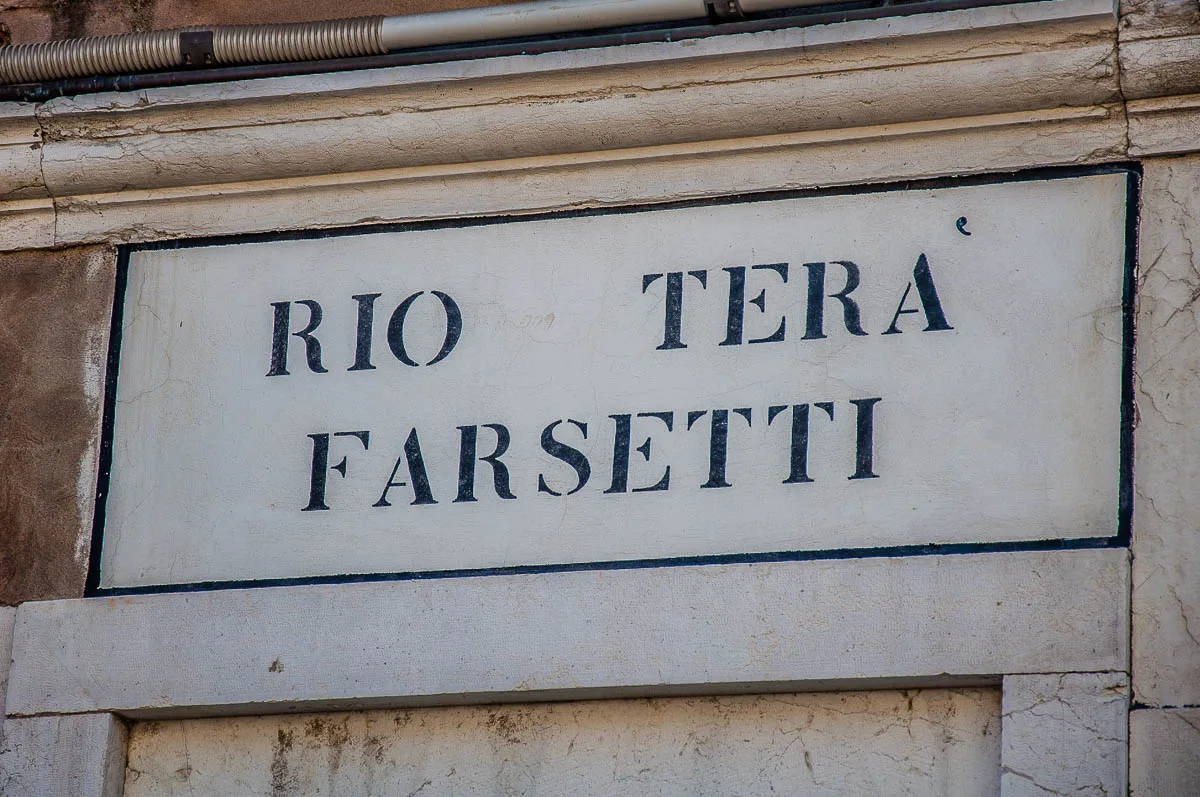
Place Names – learn the proper Venetian place names to navigate the city like a local. Here are a few to get you started:
- calle – a street in Venice that is rather long and straight. The term comes from the Latin callis meaning ‘rough/stony track’ or path’.
- campo – a traditional Venetian square. The word campo means ‘field’ in English. For centuries, the campi in Venice were just that – a grassy, often cultivated field between the houses with a drinking water well in the middle. Domestic animals could be seen there grazing all day long. And often the campi also served as burial grounds thus keeping the living and the dead in close quarters in Venice.
- fondamenta – the banks of the Venetian canals. Boats moor at the fondamente so it is an unspoken rule in Venice never to step on the green (covered with algae) step of the mooring spots.
- rio tera’ – a street that was once a canal. The canal was buried to allow for easier movement around town. The water often continues flowing underneath the street on top.
- salizzada – a historically important street in Venice thus it was one of the first to be paved with stone slabs.
- sestiere – a town district. The term is used in Italian towns or cities which historically were divided in six neighbourhoods or districts. Venice is the most famous example, but other towns and cities like Milan and Genoa were originally also divided into sestieri.
- sotoportego – a passageway that goes through the ground floor of a building thus connecting streets and campi in Venice.
San Teodoro – before the relics of St. Mark were smuggled out of Alexandria and brought to Venice in 828, the patron of the city on water was St. Theodore. He was venerated widely by the Eastern Orthodox Church and his cult in Venice was in line with the city on water being a subject of Byzantium for many centuries.
The western column on St. Mark’s Piazzetta in Venice is crowned by a statue of San Teodoro with a crocodile representing the dragon slain by the saint.
You can also see the Scuola Grande di San Teodoro. The building has a monumental facade that is decorated with statues carved of Vicenza stone. It is the seat of the oldest Venetian confraternity that was created around the 8th century as a sign of devotion to the first patron of Venice.
The relics of San Teodoro are kept in the church of San Salvador in Venice.
MUSEUMS & SIGHTS
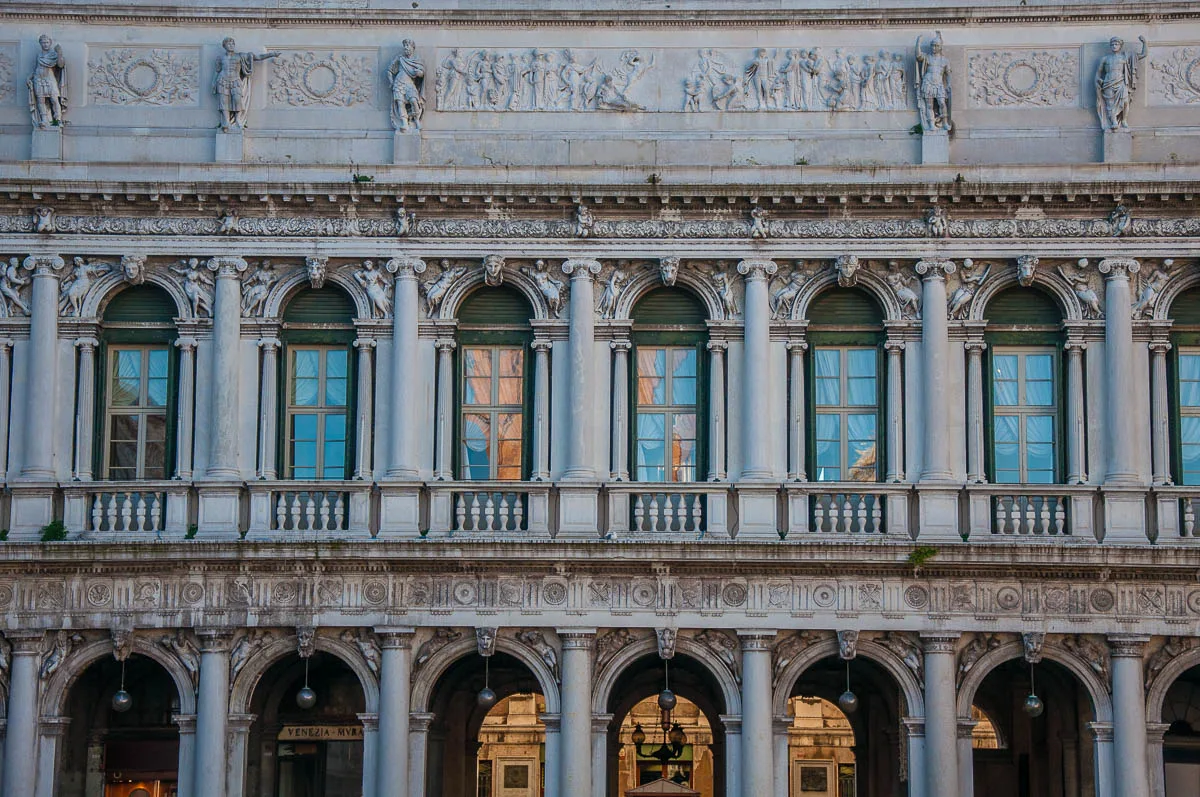
Splendid museums full of priceless works of art and historical artifacts abound in Venice. Yet, while most people stream to see the Doge’s Palace and the Gallerie dell’Accademia, there are many under the radar corners here where you can get your art and history fix in devoid of people rooms.
These are the places where you can come face to face with world-famous paintings and millennia-old sculptures without feeling suffocated by crowds.
Here are some suggestions for your interest:
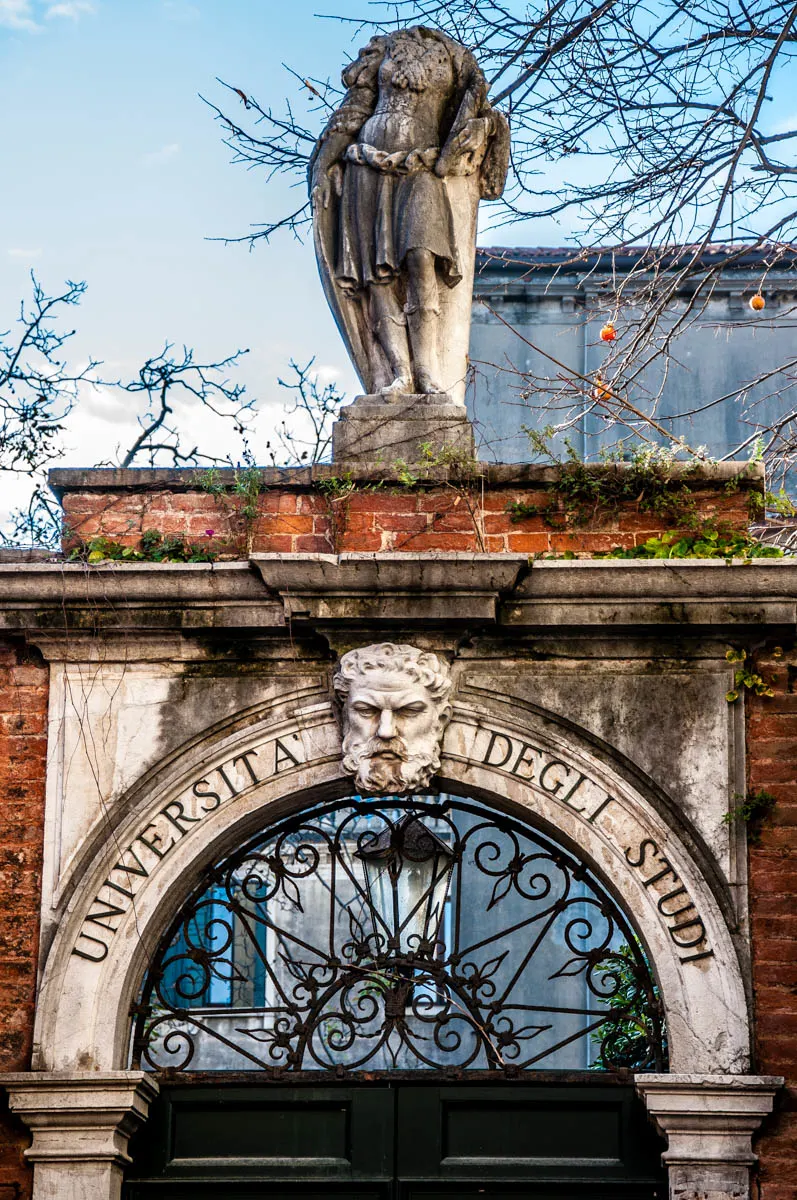
Ca’ Foscari University of Venice – join a guided tour of the historical palaces where the academic history and traditions of Venice were coined. You will find this sight in the sestiere of Dorsoduro.
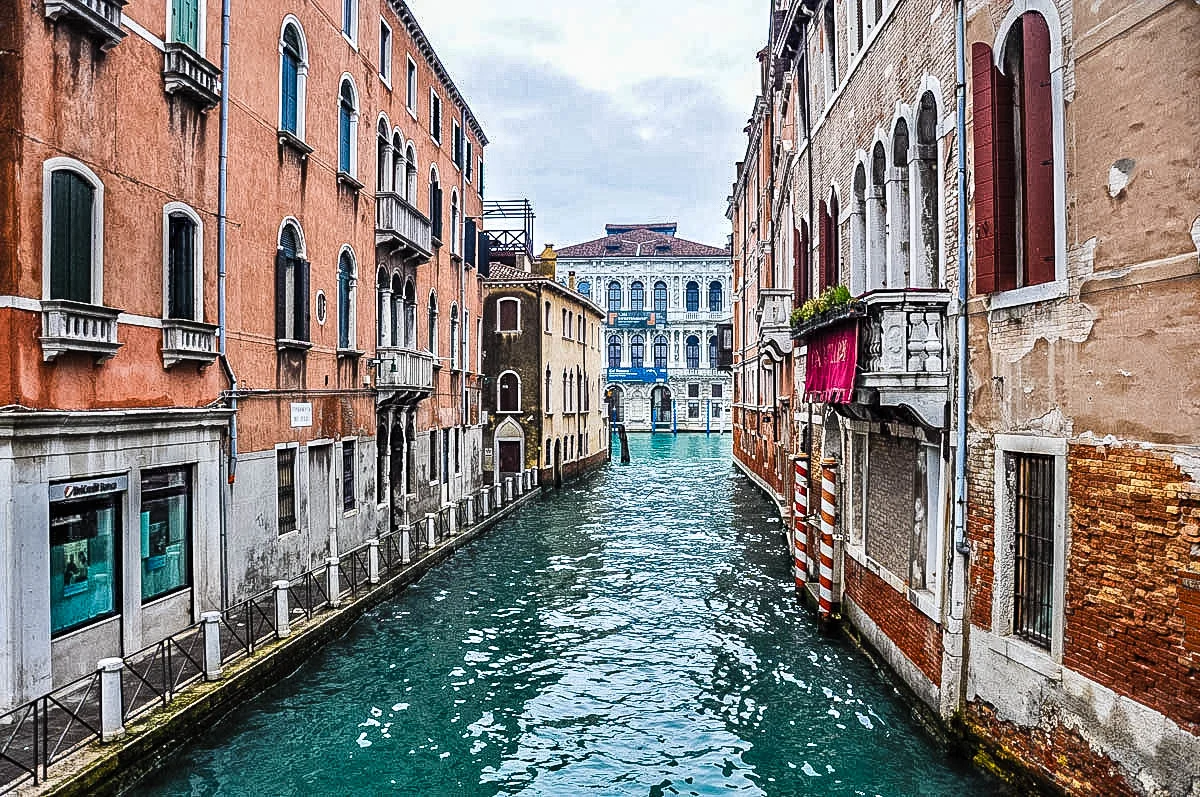
Ca’ Pesaro – spend an hour or two in the large airy halls of Venice’s International Gallery of Modern Art. Housed in a resplendent Baroque palace, here you will find a vast collection of the art of the 19th and the 20th centuries including masterpieces by Miro, Kandinsky, Rodin, and Christo.
The top floor of the palace also houses the Oriental Art Museum – another must-see in Venice.
You will find Ca’ Pesaro in the sestiere of Santa Croce.
Casa Goldoni – a gorgeous Gothic palace and birthplace of Venice’s most famous playwright – Carlo Goldoni. You will find this sight in the sestiere of San Polo.
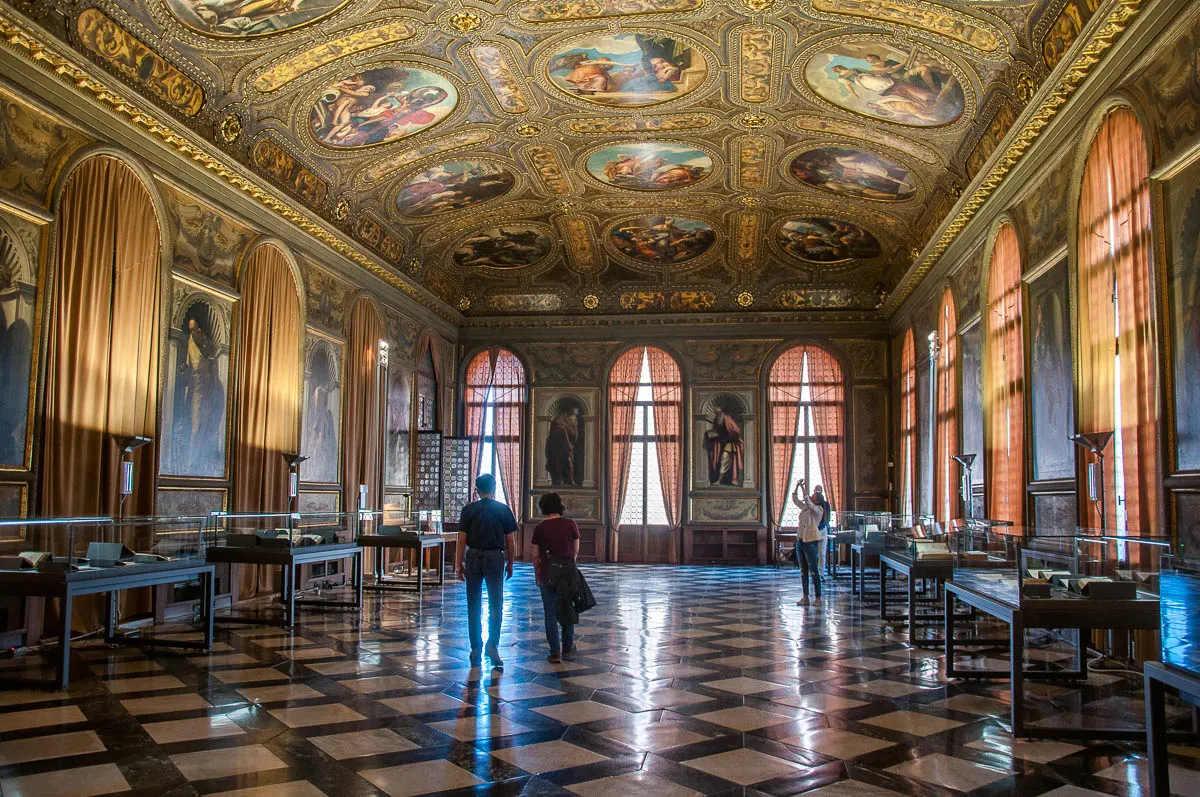
Monumental Rooms of the Biblioteca Marciana – just opposite the Doge’s Palace and often overlooked, here you will find lavish rooms decorated with paintings by Titian, Tintoretto, and Veronese. This sight is in the same building as Museo Correr in the sestiere of San Marco.
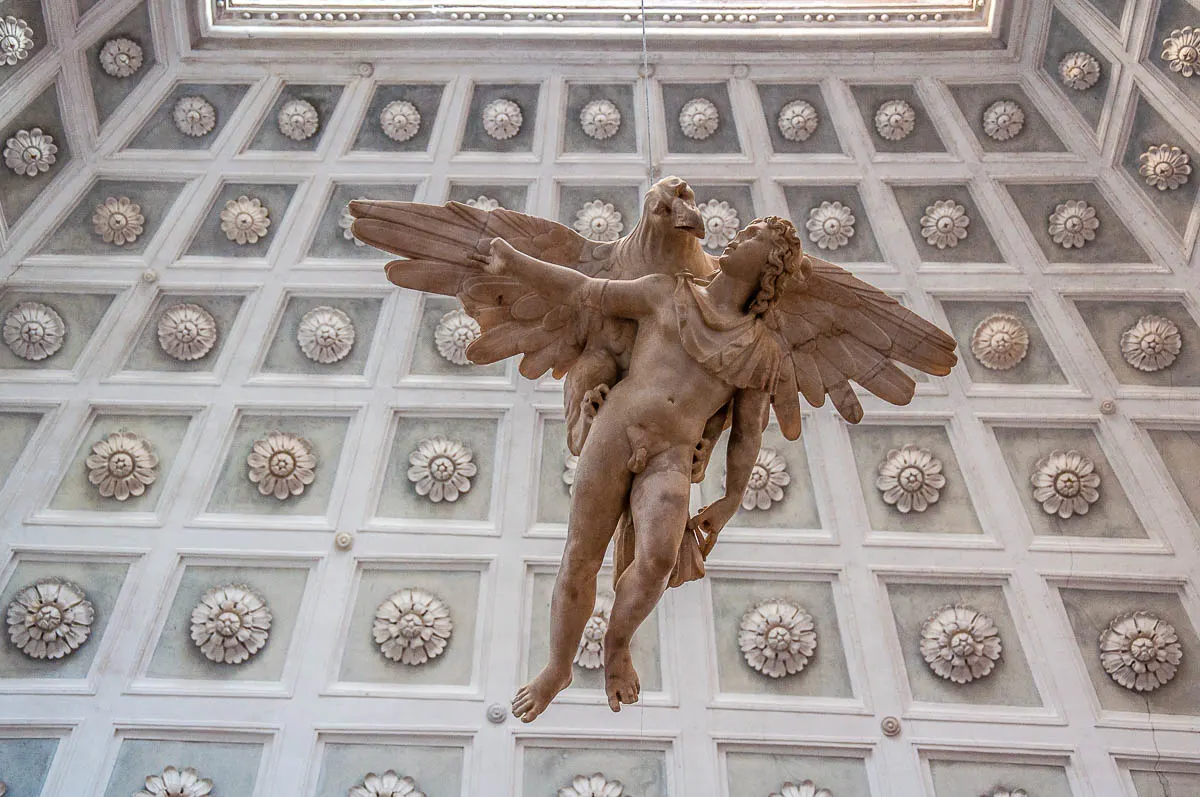
Museo di Palazzo Grimani – the only palace in Venice with Roman and Tuscan features. It also has lavishly decorated ceilings and an intrinsic connection to the origins of archaeology as a science. You will find this palace in the sestiere of Castello.
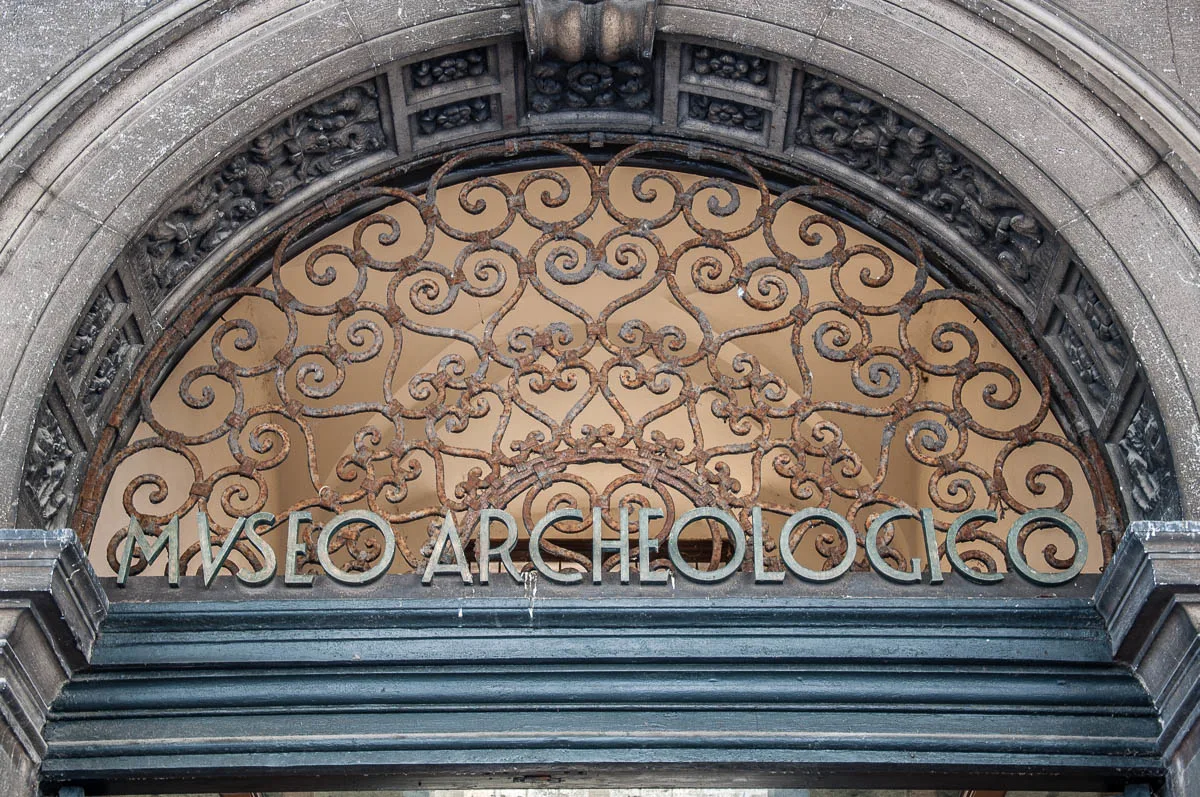
National Archaeological Museum – from Ancient Egypt to Ancient Greece and Rome, here you will find statues and works of art that are thousands of years old. With its really witty and informative Facebook page, this is also the museum with the best sense of humour in Venice. I, for one, am a real fan! You will find this museum in the same building as Museo Correr in the sestiere of San Marco.
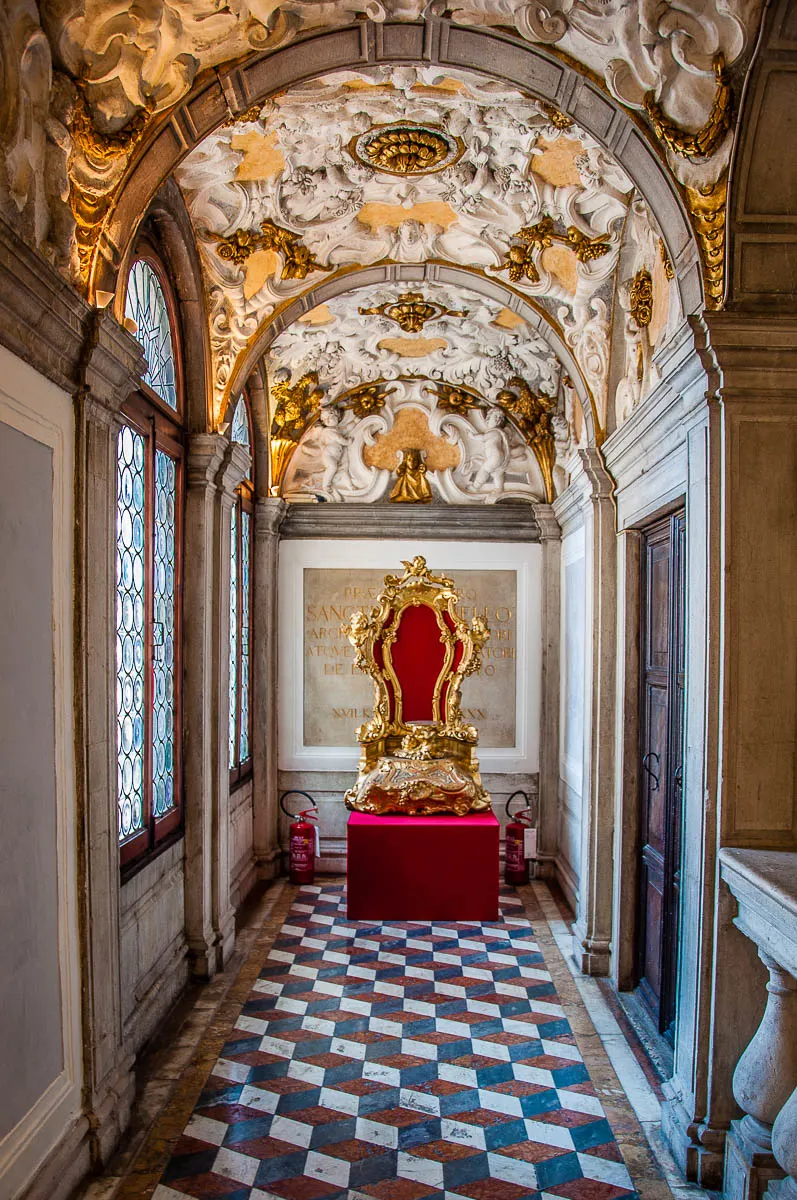
Scuola Grande dei Carmini – the home of a 16th-century confraternity. Expect richly decorated rooms and frescoes by Giambattista Tiepolo. While most tourists flock to the Scuola Grande di San Rocco, here you will have the peace and quiet to spend sweet moments in your own company just taking all the art in. You will find this sight in the sestiere of Dorsoduro.
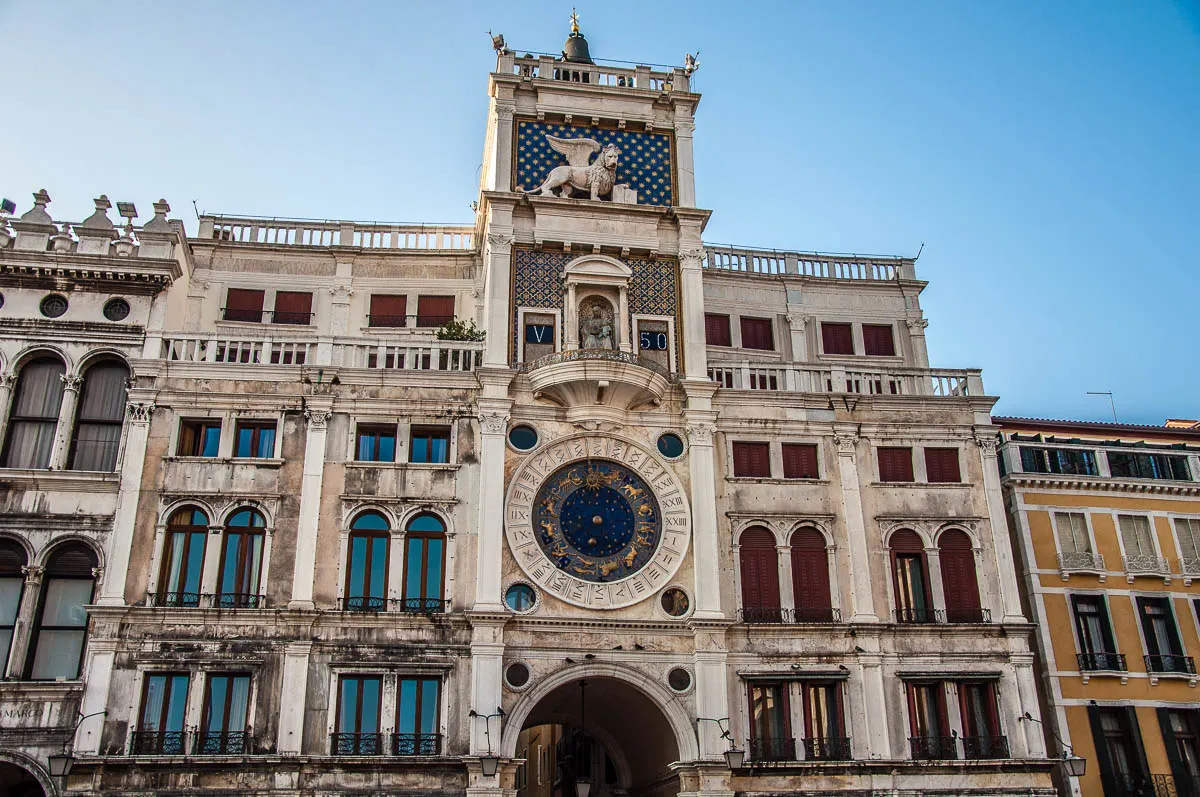
St. Mark’s Clocktower – join a guided tour to visit the splendid clocktower that overlooks St. Mark’s Square. You will see Venice from a completely new point of view and learn the fascinating history of the tower and its clock. You will find this sight in the sestiere of San Marco.
Wagner Museum – The famous composer expired in 1883 in Ca’ Vendramin Calergi in Venice. Wagner adored the city on water. A museum dedicated to him has been set up on the first floor of this 15th-century palazzo which also houses the casino of Venice. You will find this sight in the sestiere of Cannaregio.
MUSIC
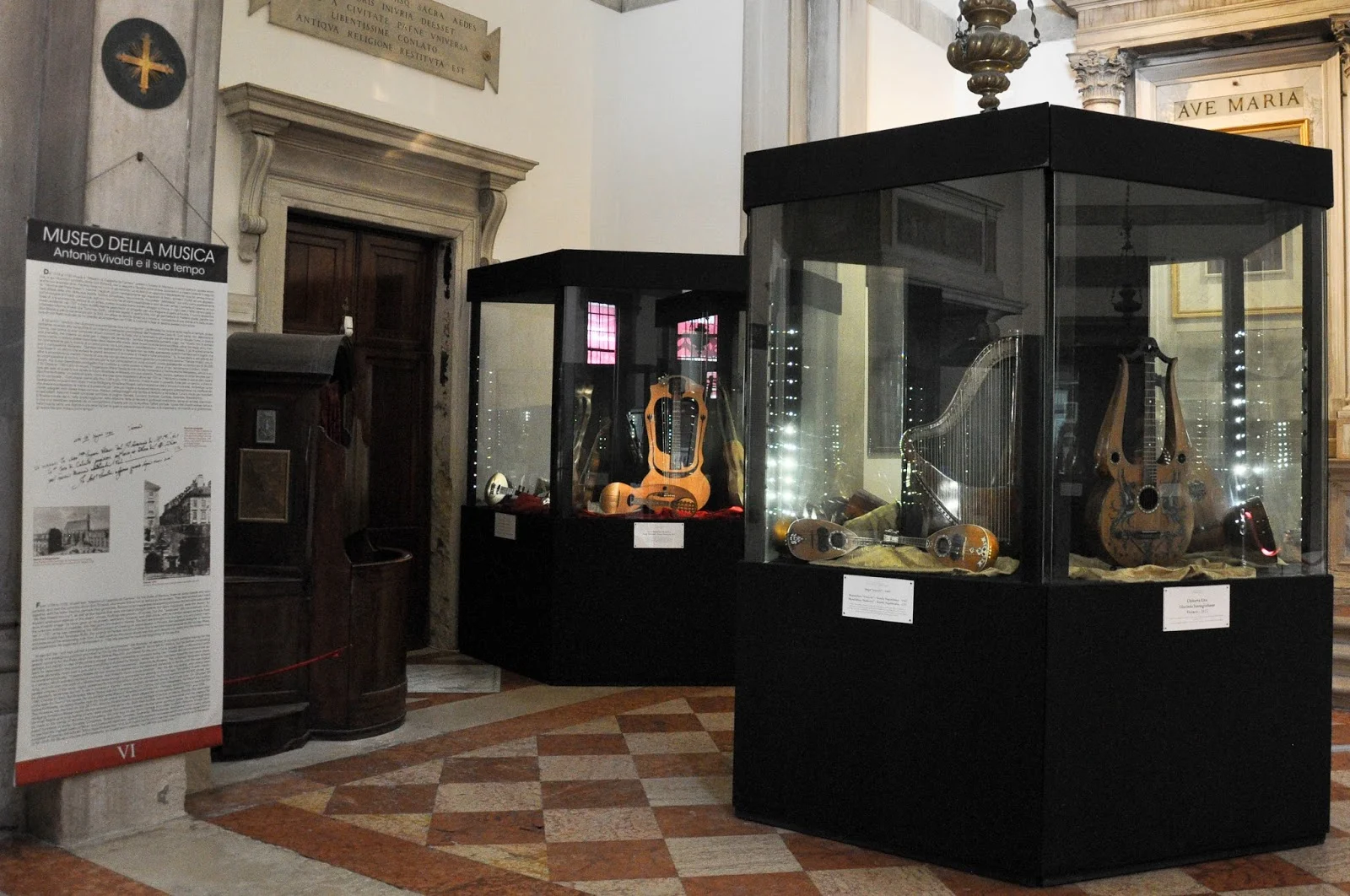
‘When I seek another word for ‘music’. I never find any other word than Venice!’
Thus spake Friedrich Nietzsche, so taken was he with the loveliness of Venice! While the city on water is, indeed, music for the eyes, there is also a rich musical tradition here and many places where to treat your ears to a beautiful performance.
Here are some suggestions for your under the radar Venice list:
Basilica della Salute – free afternoon concerts of organ music are held daily in one of Venice’s most iconic churches.
Benedetto Marcello Music Conservatory – expect a rich programme of concerts, masterclasses, and other musical events some of which you can attend for free or by making a donation.
Museum of Music – a lovely small museum in the deconsecrated Church of San Maurizio in the sestiere of San Marco. Here you can see historical music instruments and a violin-making workshop among many other things. Make sure that you also pop in Venice’s most ancient church, San Giacomo di Rialto, where there is a small collection of historic instruments and sheet music to admire, too.
San Martino a Natale – an international music festival held in Venice each winter. The concerts are performed in some of Venice’s most stunning sights. The best thing about them is that they are absolutely free. You may need to book in advance, though.
Venice Music Project – concerts with historic instruments. Music that has been forgotten for centuries is being revived by this group of internationally recognised musicians.
SPOOKY CORNERS
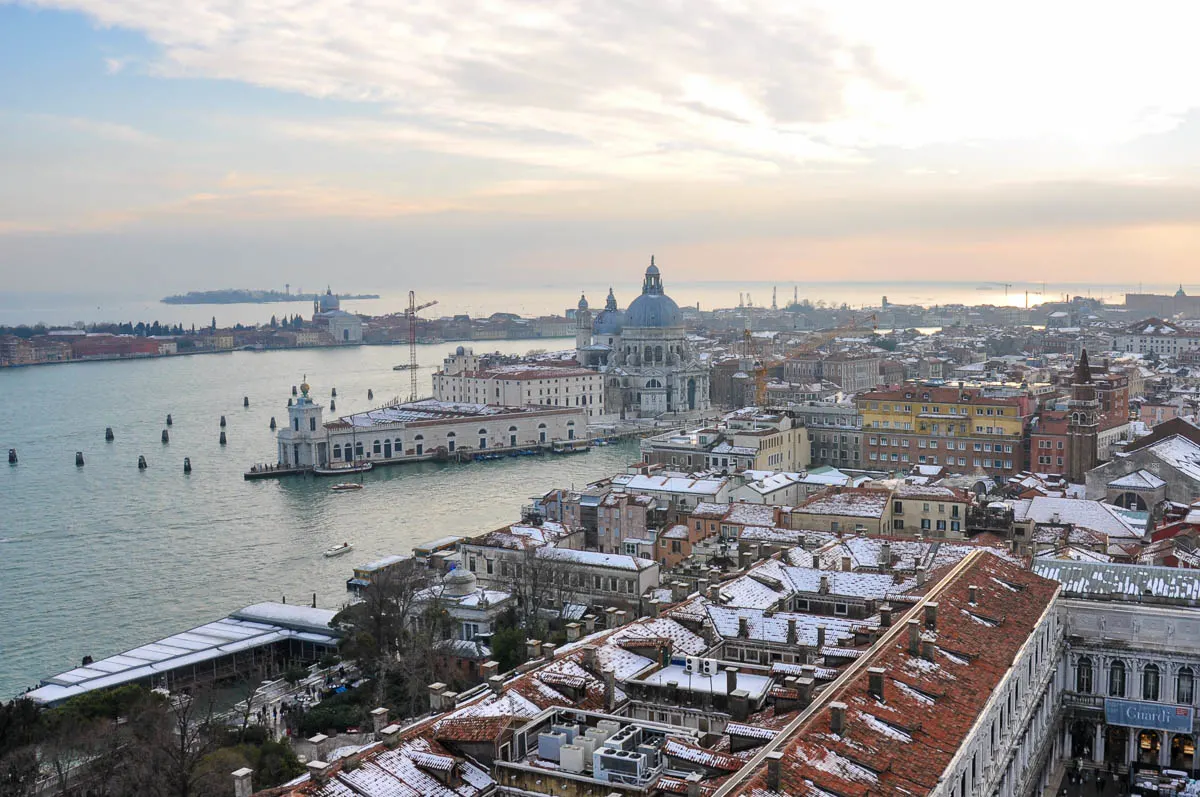
Venice is a place where you can feel the weight of many centuries and many intertwined human stories. The city on water has a confusing labyrinthine character. Dense fogs often envelop it in their ghostly embrace. And everywhere you look, there is yet another curving alley abruptly ending on the edge of a dark canal.
Add to this the many local legends where ghosts, monsters, and unsavoury characters lurk waiting to grab hold of your imagination and Venice becomes the perfect place to creep yourself out with visits to spooky sights and scary hidden corners.
Here is a shortlist for your interest:
Calle della Morte – the name of this Venetian street means literally Death Alley. You will find it near the Church of San Giovanni in Bragora in the sestiere of Castello. The story goes that people who had been condemned to death by the Venetian Council of Ten would be tricked to come to this street where they were quickly killed.
Campo San Piero – this small square in the sestiere of Castello is said to be haunted at night by the apparition of a young bride. Called Tosca, she is looking for her ring finger with her wedding ring attached to it so that she can marry her beloved. Tosca was a beautiful but impoverished girl from Treviso who was betrothed to marry a much older yet very rich nobleman.
She fell in love with a young hunter and escaped to Venice with him. The jilted nobleman found the young lovers there, killed the hunter and cut off Tosca’s wedding finger shouting that if he couldn’t have her, nobody would.
Corte Bressana – next to the Basilica of S.S. Giovanni and Paolo in the sestiere of Castello, you will find a small, allegedly haunted, courtyard. It’s said that there was once a Venetian man who was of a considerable height. He also happened to be the bell-ringer of the St. Mark’s Campanile – the huge bell-tower on St. Mark’s Square.
A Venetian scientist offered a large sum of money to the bell-ringer in exchange for his skeleton. The bell-ringer greedily accepted the advanced payment and started going out every night drinking himself to oblivion. Soon, his excess drinking led to his premature death.
Posthumously, the bell-ringer bitterly regretted the deal and, it’s said, that to this day he haunts the Corte Bressana as he used to live there when alive. It is believed that he begs the passers-by for alms trying to collect as much money as possible in order to buy his skeleton back.
Curiously enough, the actual skeleton of the bell-ringer nowadays is exhibited in Venice’s Natural History Museum. It can easily be seen that the bell-ringer was, in fact, a truly tall man in life.
Palazzo Mastelli del Cammello – this Venetian palace is in the sestiere of Cannaregio and it is adorned with some curious statues. They depict three men with rather startled faces plus one of them wears a rather large turban. In addition, there is a bas-relief with a camel.
There is an old Venetian legend claiming that the statues are the petrified former owners of the palace. They were three rich silk and spices merchants – Rioba, Afani, and Sandi – who tried to scam a rich Venetian lady by selling her some low-quality textiles for a very expensive price. She had been recently widowed and had inherited a tailoring workshop.
Discovering the scam, the widow cursed the money she paid and when the dishonest merchants touched it they (and their camel!) turned into stone. Curiously enough, Venetians also believe that if you touch the metal nose of the statue of Sior Antonio Rioba, you’ll have luck in your business affairs.
Punta della Dogana – this is the triangular edge that cuts between the Grand Canal and The Giudecca Canal and points straight into the Basin of St. Mark (see picture above). It’s one of the most photographed spots in Venice, as just further up from it is the rather photogenic building of the Church of Santa Maria della Salu
te. Allegedly, in the depths of the water just off the tip of Punta della Dogana lives a large serpent. Something like a distant cousin of Nessie from Loch Ness.
It is said that several local fishermen have sworn to have seen this serpent appear out of the dark waters on moonless nights. One such witness even claimed to have seen the serpent eating a whole seagull. Scary stuff!
More Information:
WATER & WATERCRAFT
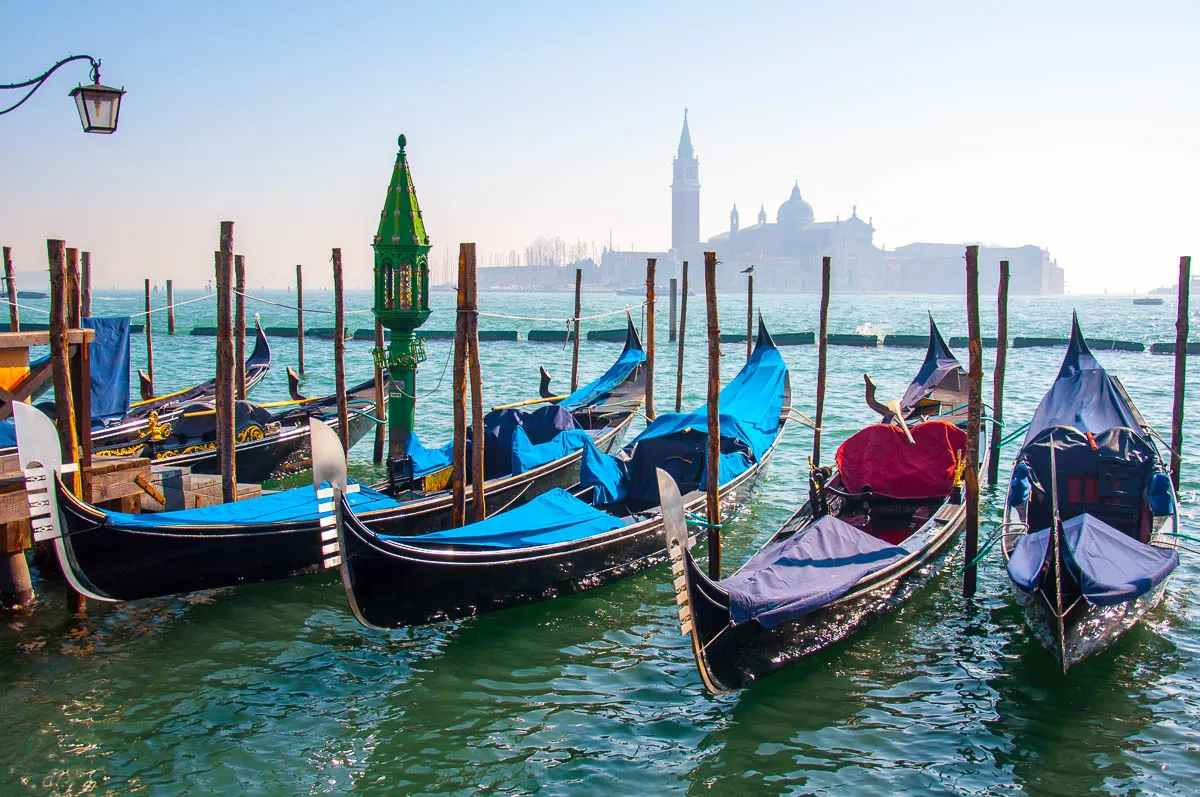
Venice is intrinsically connected to water. What we nowadays know as the tourist magnet of Venice grew from small marshy islets in the Venetian Lagoon to become a maritime superpower that for over one thousand years dominated the trade in the Mediterranean and conquered cities and territories all over Northern Italy, Cyprus, and Greece.
Life in Venice has adapted to water in many ingenious ways. From building lavish palaces on stilts pushed deeply in the islets’ silts and clays to deloping special types of boats adapted to the characteristics of the city’s canals and the Venetian Lagoon, the people of Venice seem to have salty water running in their veins.
Here are some great ways to get close to water and watercraft in Venice in several unexpected and under the radar ways:
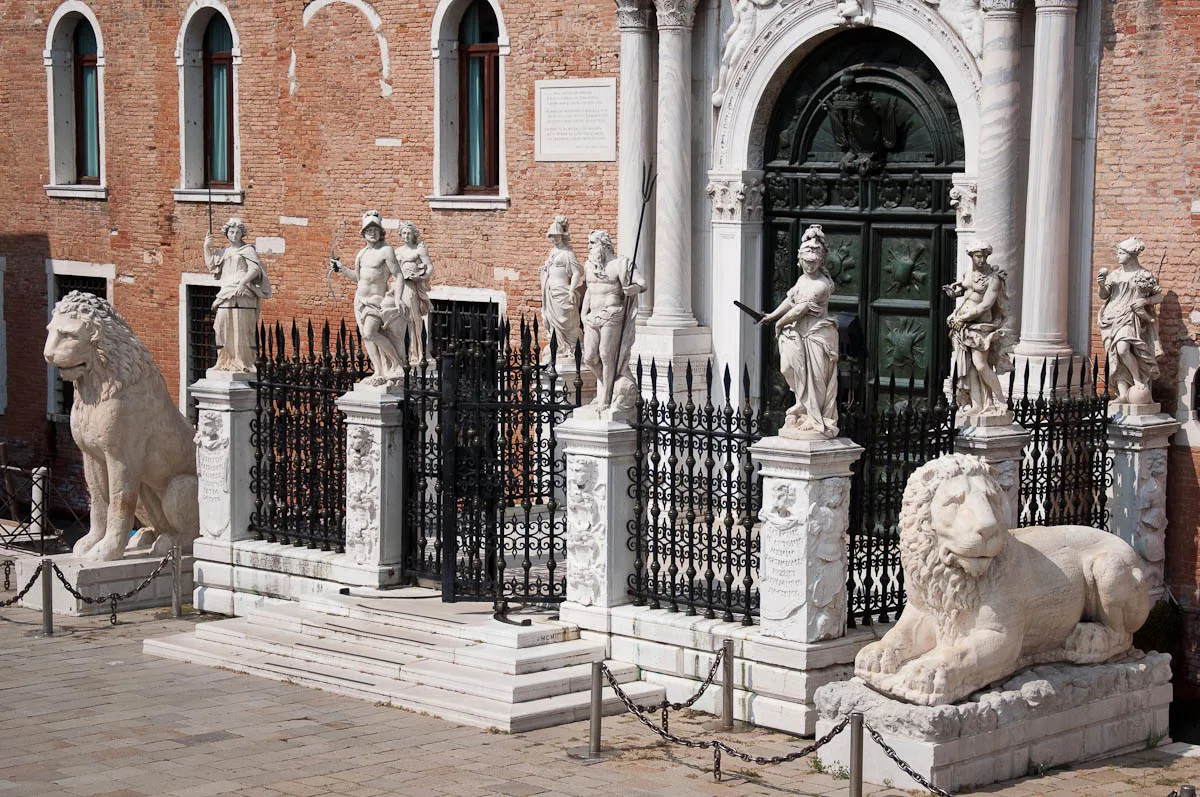
Arsenale’s Porta Magna – the landside entrance of Venice’s famous Arsenale shipyard. It was built in 1460 and it is an early example of the Venetian Renaissance.
The monumental gate is flanked by four lions – each of different size. The lions were booty of war.
The first lion on the left is the biggest. It is an ancient Greek statue dating back to around 360 BC. It was brought to Venice in 1687 from the port of Piraeus where it had been a prominent landmark. Runic inscriptions were carved into the lion by Scandinavian mercenaries in the 11th century. Nowadays, the runes are rather faded.
Arzana’ – an association dedicated to the study and conservation of the traditional Venetian boats and naval heritage. You can see here a short outline in English of the association’s activities. Arzana’ owns several types of Venetian boats as well as traditional equipment and tools. It can be visited upon request made in advance.
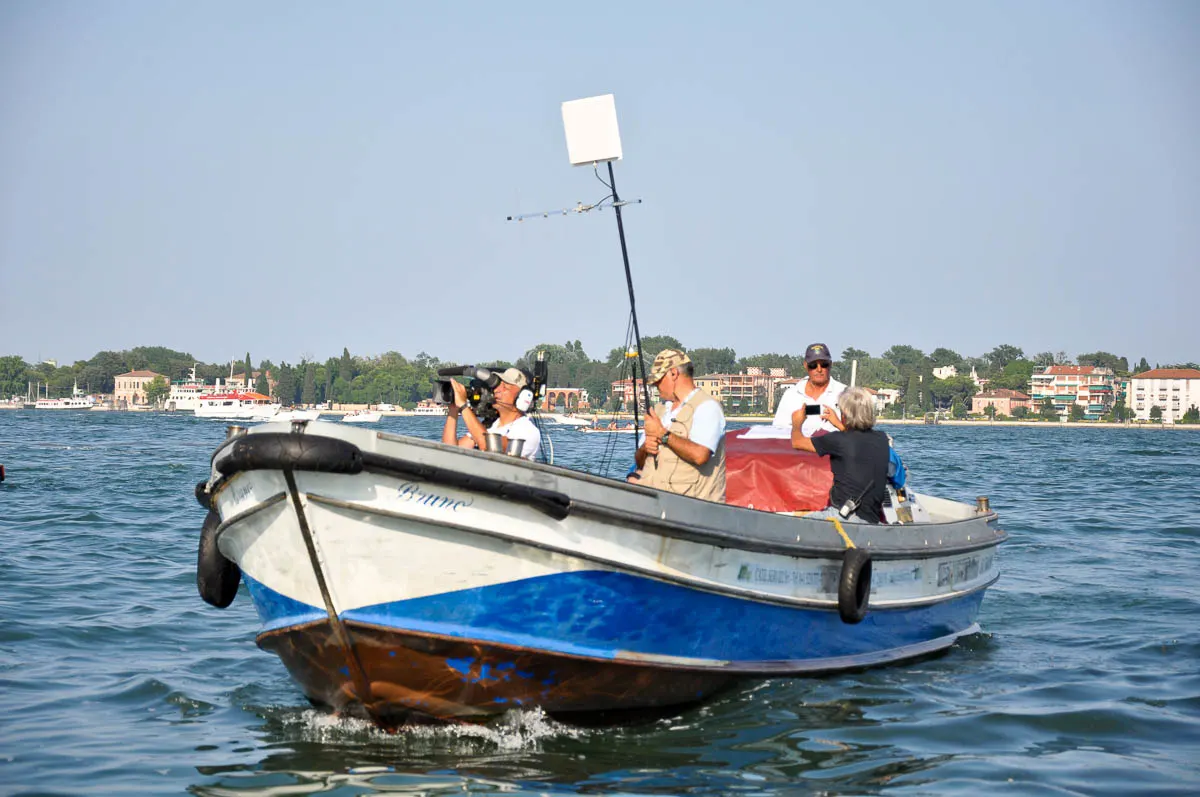
Boat-spotting – find a quiet spot in Venice along a canal or with a view of the lagoon and try to see how many different types of boats will pass by you in ten minutes or so. From freezer boats delivering to supermarkets and restaurants to garbage-removal boats, from barges ferrying cement and construction materials to elegant gondolas, suddenly you will gain a deep appreciation for the variety and ingenuity of Venetian boats.
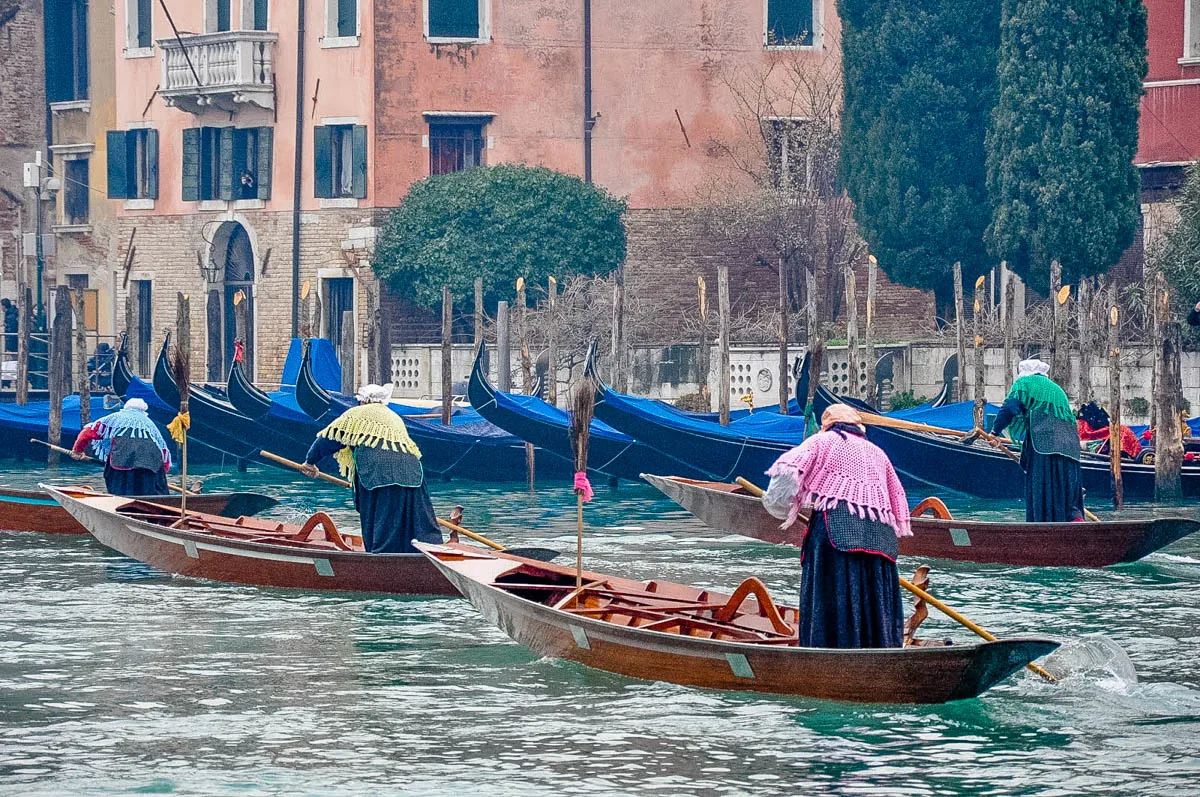
Regata delle Befane – this is a great way to get close to two local traditions. One is the Venetian tradition of rowing standing upright (known as Voga Veneta) and the other is the celebration of Befana – the old lady who brings sweets and presents to the good Italian children on the Eve of Epiphany. Befana is also known as Marantega in Venice.
On the morning of 6th January, a curious regatta takes place near Rialto Bridge in the city. Five Befanas compete with each other rowing traditional Venetian boats called mascareta sandolo – a lightweight boat with a flat bottom.
Look closer and you will see that the five Befanas are actually men dressed up to look like the old lady. They all are members of Bucintoro – the oldest rowing organisation in Venice.
It’s a lot of fun to watch!
Regata delle Donne – with historic roots stretching back more than 500 years ago, this is a women-only boat competition.
The first edition was held in 1493 in honour of Beatrice d’Este – Duchess of Bari and Milan and one of the most erudite princesses of the Italian Renaissance. About fifty ladies took part in the regatta dressed in linen clothes.
The women’s regatta was then held several times through the centuries and at Museo Correr in Venice you can see the portrait of Maria Boscola da Marina who was the champion rower many times from 1740 to 1784.
The tradition was restored just over twenty years ago and nowadays the Regata delle Donne is held in Venice every March.
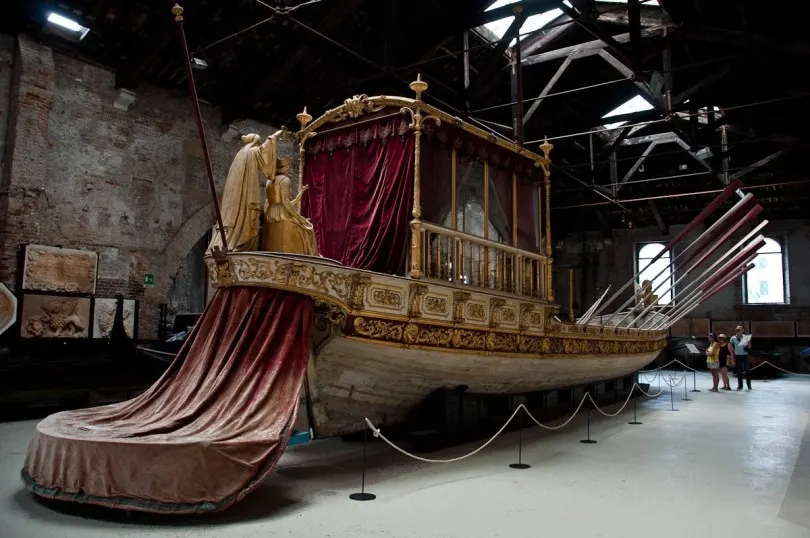
Ships Pavillion – built in the 16th century, this was formerly a large workshop making oars for the ships constructed in the adjacent Arsenale. Nowadays, it has been turned into an exhibition space hosting splendid old boats, ships, and gondolas that showcase the historical naval power and glory of Venice.
The pavilion forms part of the city’s Naval History Museum, which is just around the corner. The Ships Pavillion is next to Arsenale’s Porta Magna in the sestiere of Castello.
Curiously enough, for a brief period at the end of the 16th century, the building was quickly adapted to temporarily host the meetings of the Great Council, the main government body of the Republic of Venice, after a big fire devastated the Doge’s Palace.
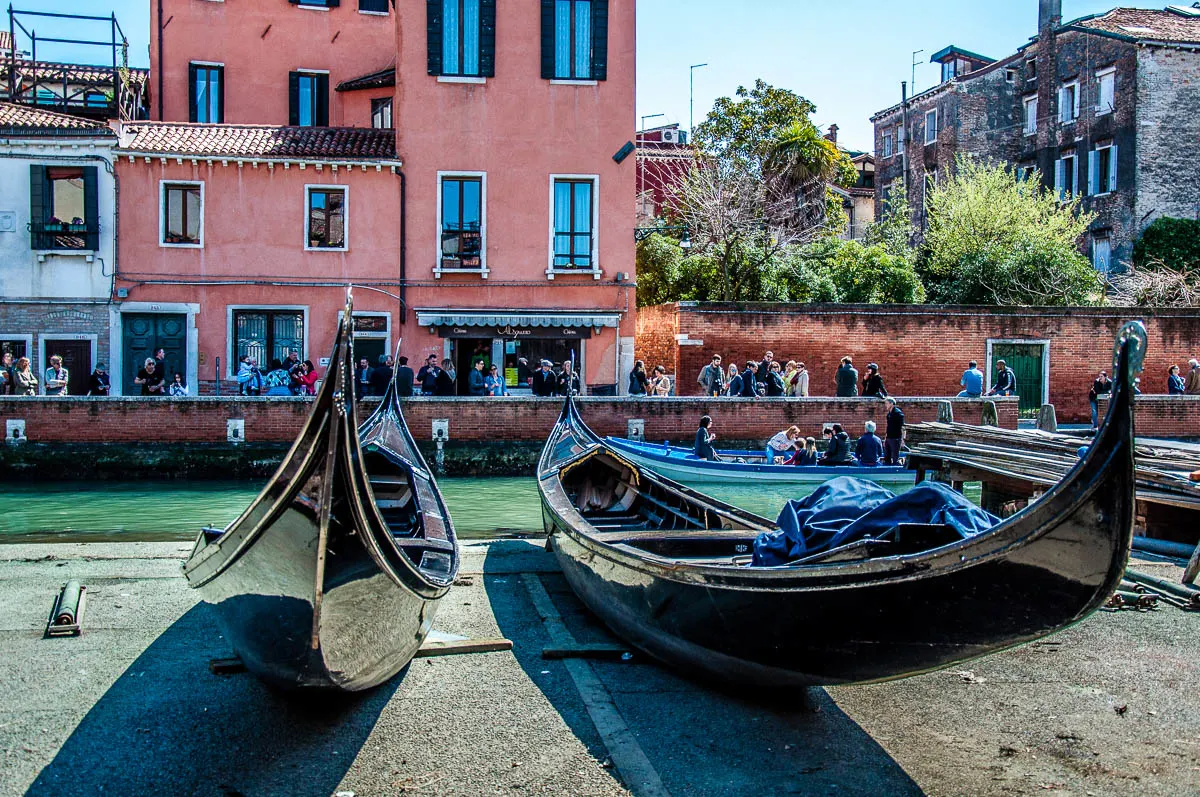
Squero Tramontin – a historic boatyard building and repairing gondolas since 1884. It’s not usually open to the public but a request for a visit can be made on this link. Otherwise, you can observe the gondola makers at work from the opposite side of Rio dell’Avogaria in the sestiere of Dorsoduro.
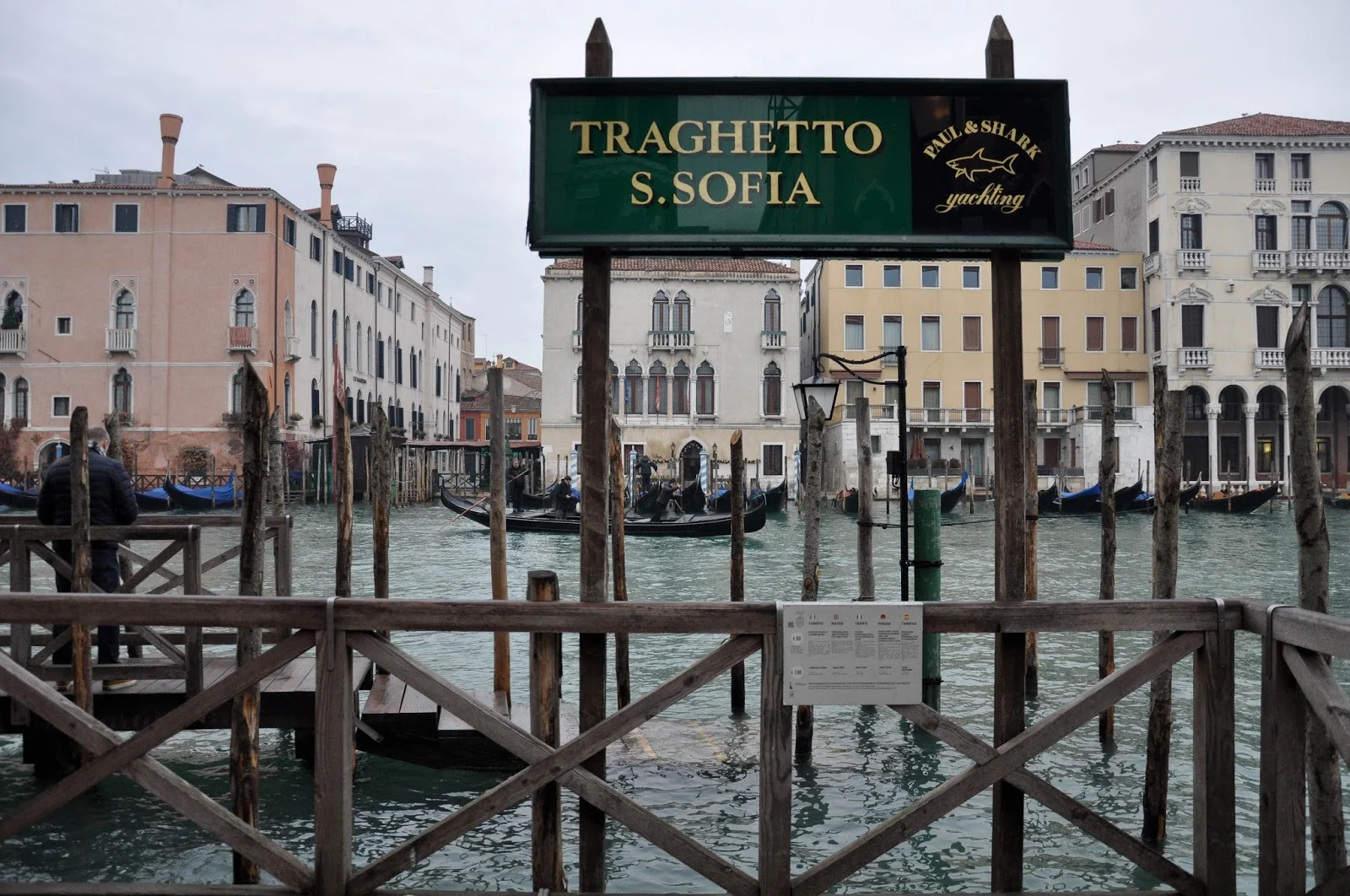
Traghetto across the Grand Canal – traghetto is a simple black gondola-shaped boat that takes you across the Grand Canal at certain points. A ride costs a couple of euros one way and traditionally you need to stand upright.
Years ago, there were dozens of traghetto stations along the Grand Canal. Nowadays, there is only a handful left.
Riding the traghetto in Venice is a great way to see the beauty of the Grand Canal from a different point of view. It also saves you the time and effort of walking for miles as the Grand Canal is only crossed by four bridges otherwise.
Trabaccolo Nuovo Trionfo – a historical ship built in 1926 and originally used for fishing, canal dredging, and freight transport. In 2008, it was purchased to be used as a ship representing Venice and for cultural, training, and leisure activities in Venice and the Adriatic Sea. When in Venice, you will find it moored at Punta della Dogana in the sestiere of Dorsoduro.
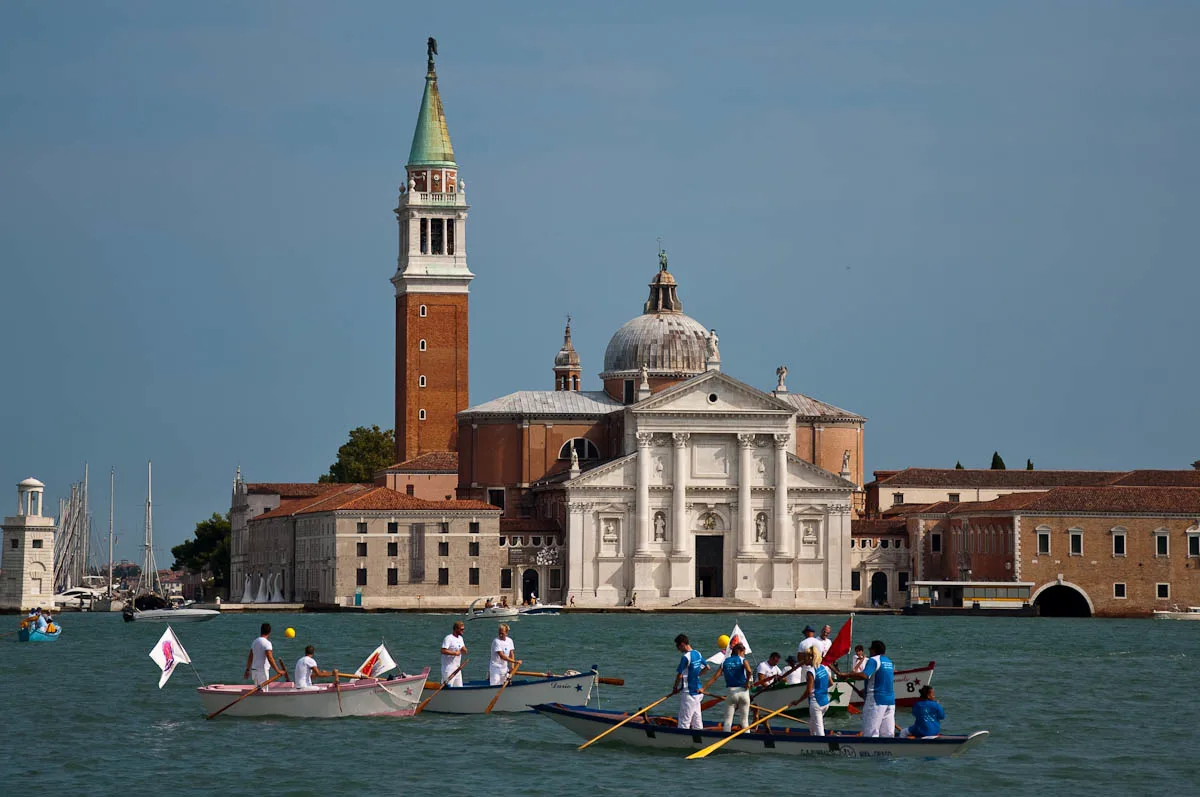
Traditional Venetian Boats – to navigate their city, through the centuries the Venetians developed several types of boats. Adapted to the characteristics of the Venetian Lagoon and the Venetian rowing style (Voga Veneta), they are a wonderful sight to see around Venice. Obviously, the most famous one is the gondola. Here are four of the lesser-known beyond Venice traditional Venetian boats:
- bragozzo – a boat with two masts used for fishing or freight transport. You can see a really gorgeous bragozzo in the Ships Pavillion in the sestiere of Castello.
- sandolo – it refers to a variety of boats with flat bottoms and from five to ten metres long that can be rowed by one to four people. It’s one of the most widely used boats in the lagoon and has several variations.
- sanpierota – this flat-bottomed boat takes its name from San Pietro in Volta – one of the small villages on the island of Pellestrina in the Venetian Lagoon. Used for fishing in the lagoon, it can be either rowed by one or two people, sailed or have a small motor attached to it.
- topo – with a name that means ‘mouse’ in English, you will see this boat all over Venice. Having started life as a sailing boat, nowadays it is mostly motorised and it is used to transport goods. Couriers delivering parcels in Venice use a topo boat, too.
VIEWS
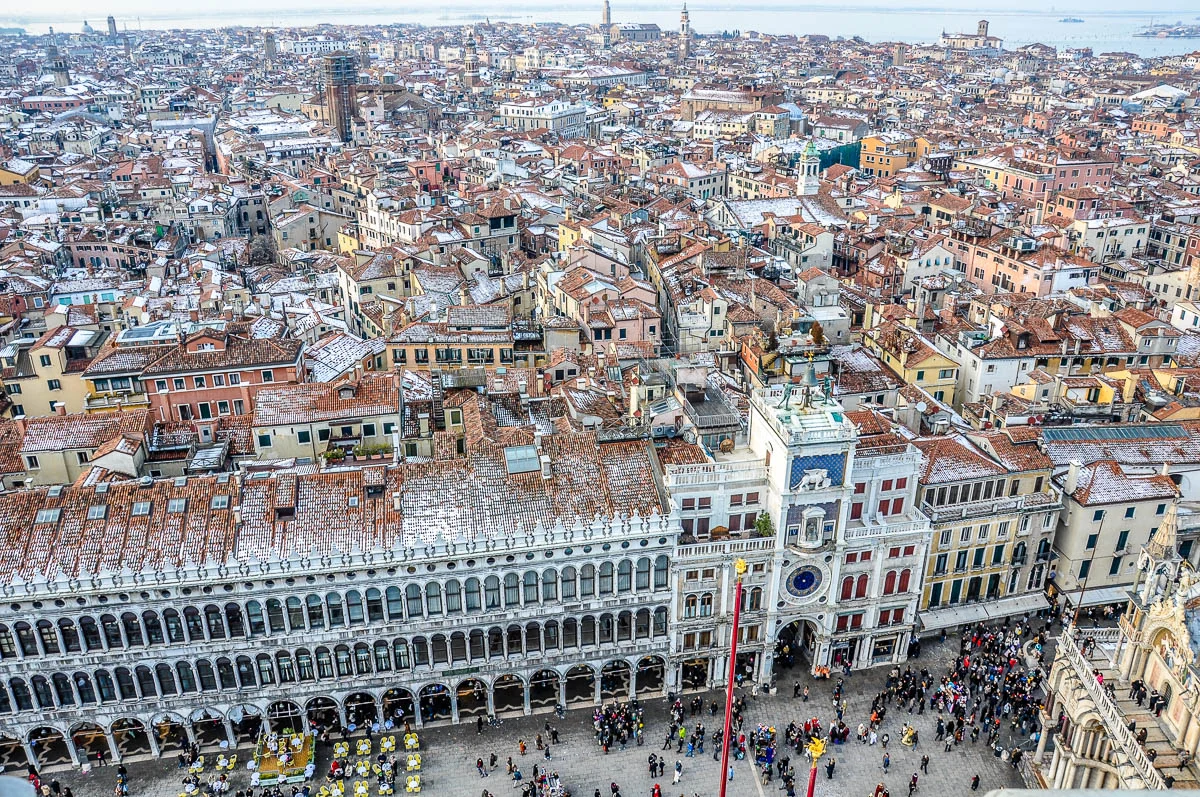
Venice is beautiful from whichever angle you look at it. Yet from above, the city on water is truly breathtaking.
St. Mark’s bell tower is the most obvious choice to see Venice from a birds’-eye view. It tends to get very busy though with crowds of tourists besieging it all through the day.
Instead, make sure that you head to one of these lesser-known observation spots in Venice. They will reward you with splendid views and excellent photo opportunities of the world’s most unique skyline:

Terrace of St. Mark’s Basilica – it affords a sublimely unforgettable view over St. Mark’s Square, the Campanile, the Doge’s Palace, the many gondolas and other watercraft in the St. Mark’s Basin, and the two pillars crowned by the statues of the winged lion of Venice and of St. Theodore with his dragon-cum-crocodile.
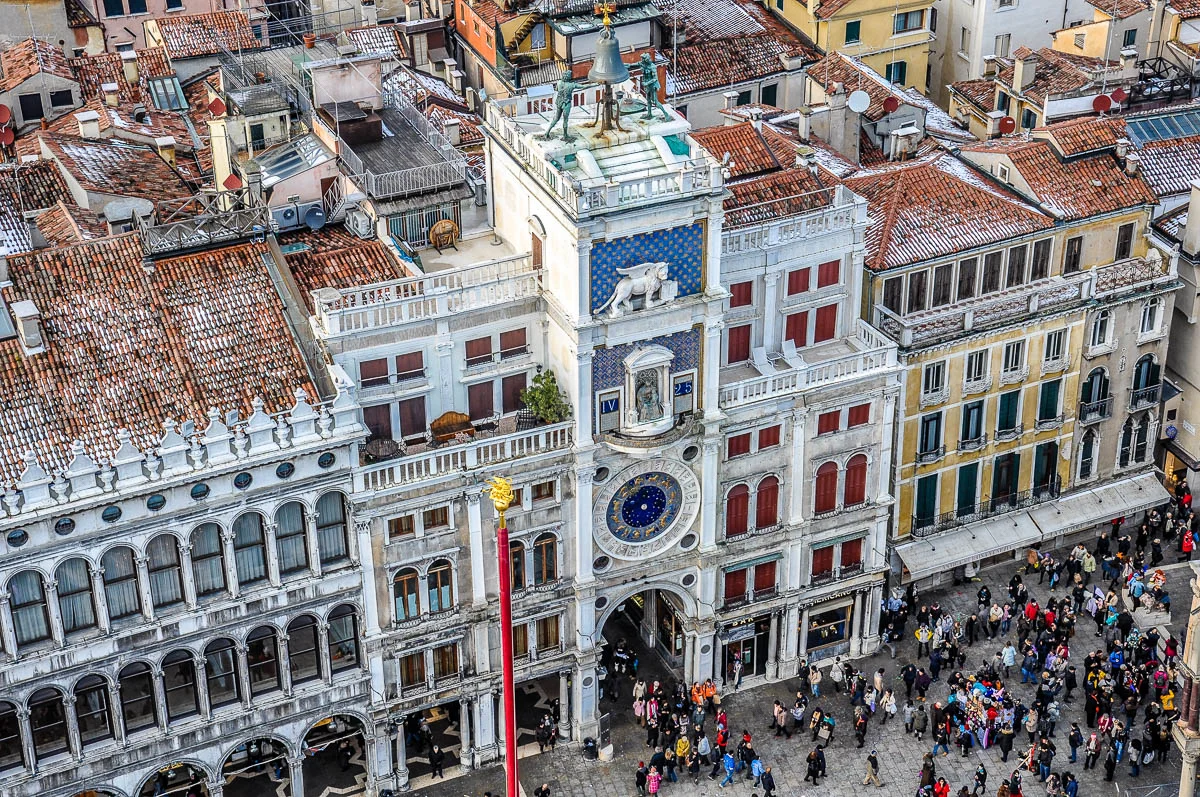
St. Mark’s Astronomical Clock on St. Mark’s Square – you will need to join a small guided tour and be perfectly OK with tiny claustrophobic spaces and big heights, but it is more than worth it for the views alone.
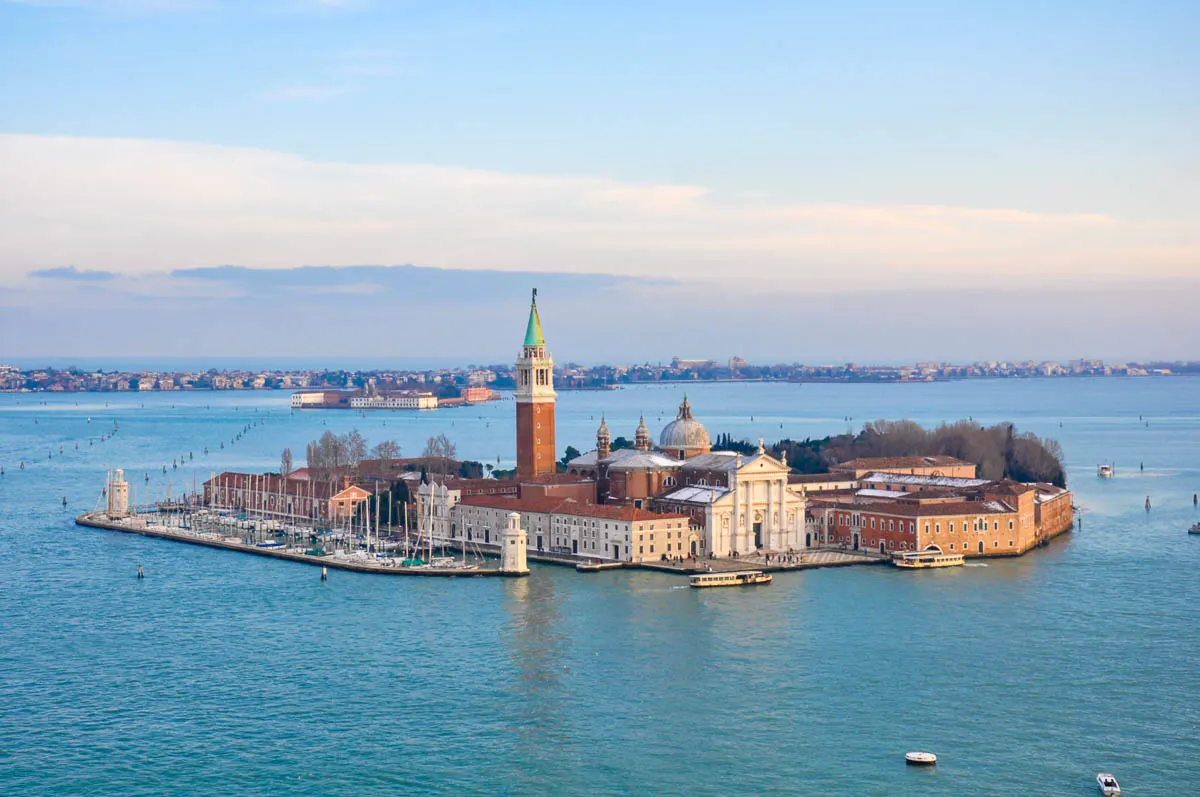
Bell Tower of the Palladian Church on San Giorgio Maggiore – this is the tiny island that you can see just opposite the Doge’s Palace in Venice. A vaporetto will take you there in a few minutes. Usually, there are no huge crowds, so you can go up to the top of the bell tower as fast as the lift will take you and then enjoy the gorgeous views across the St. Mark’s Basin.
You will see the Doge’s Palace, St. Mark’s Square, the two pillars and many more iconic Venetian sights and your heart and your camera will sing with joy. In winter, up there on top of the tower can be quite cold, so dress warm if you intend to stay for a little bit in order to take photos. Speaking from a very cold, glove-less experience.
Rooftop Terrace of Fondaco dei Turchi – the latest stunning place from where to admire the beauty of Venice. The best thing is that it is completely free of charge and you can also book the time slot for your 15 minutes visit in advance here.
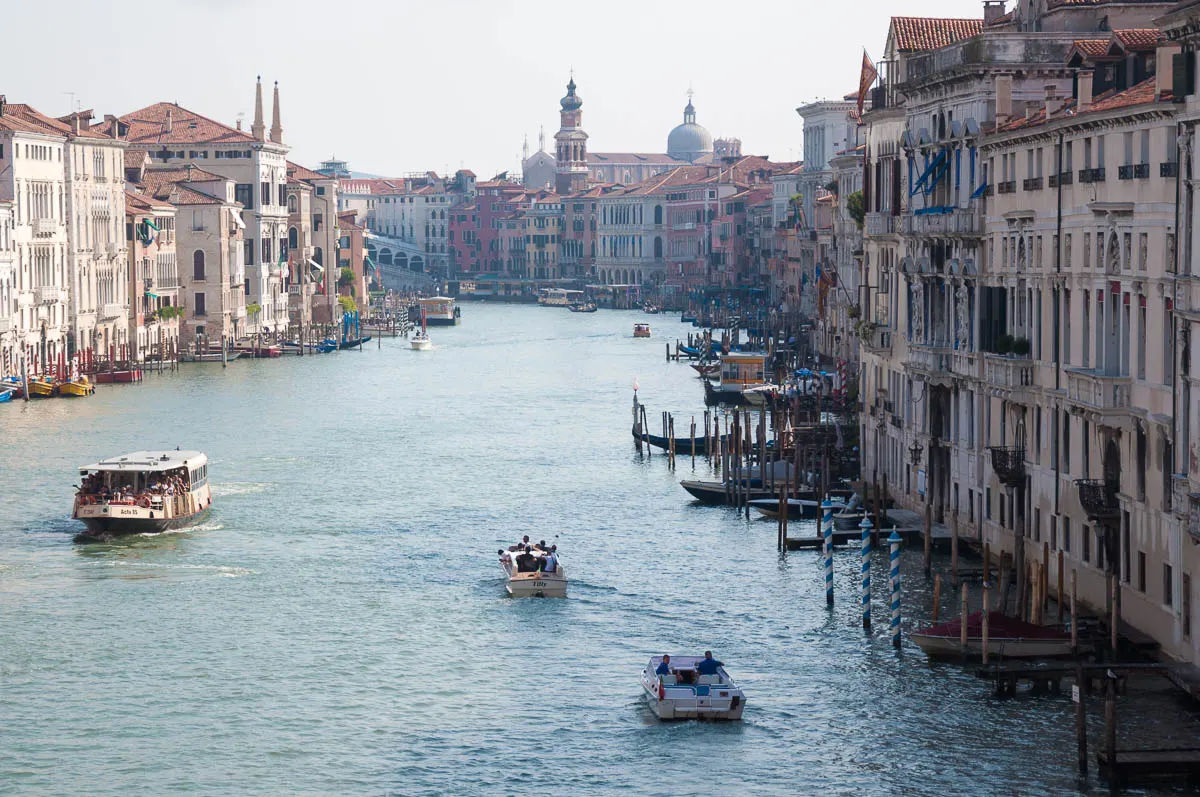
Aula Mario Barrato of the University of Venice Ca Foscari – you will need to join a guided tour in order to have a look around Venice’s University. It is a great way to learn more about it, so don’t miss it.
The best bit is that you will be shown the University’s Aula Magna which nowadays is known as Aula Mario Barrato. From its lace-like Venetian windows, you can admire a stunning view over the Grand Canal. This is the only spot on the Grand Canal from which you can glimpse both the Rialto Bridge to the left and the Accademia Bridge to the right. Not to be missed!
In Conclusion
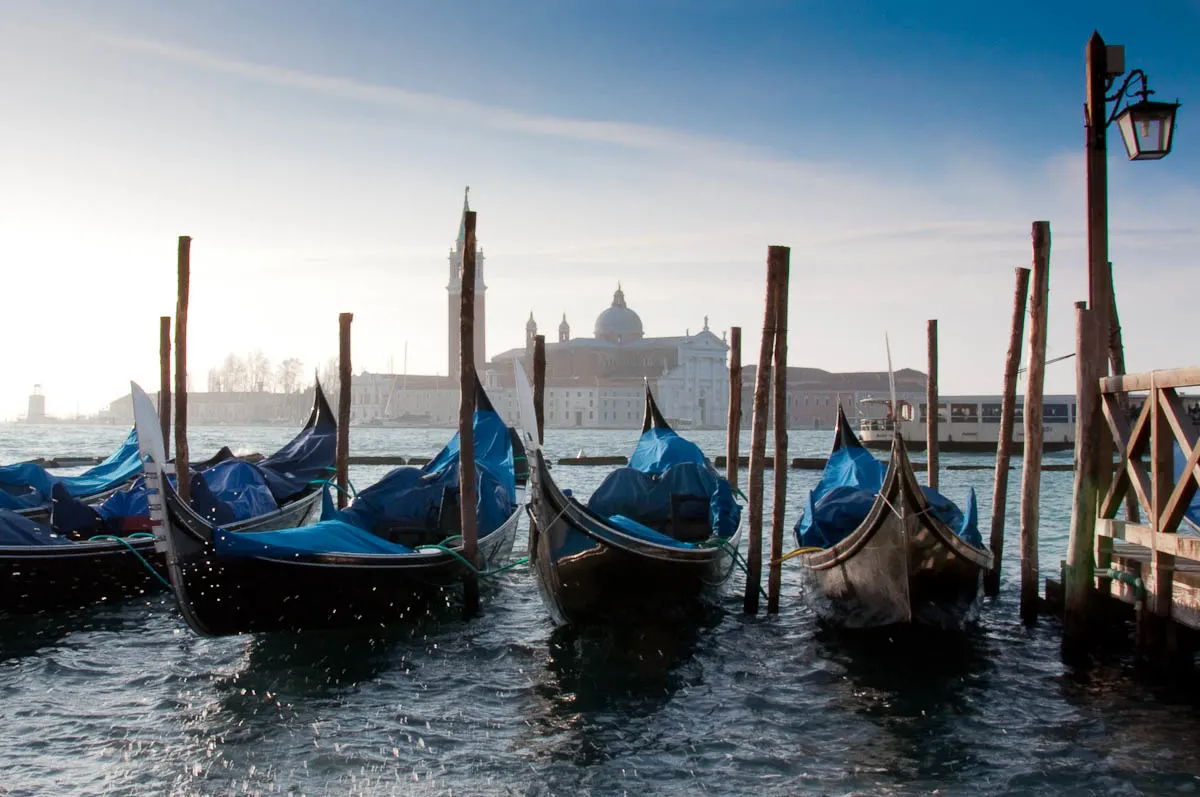
In Venice, a surprise awaits you around every corner.
It could be a beautiful view that suddenly reveals itself just as you emerge from a dark sotoportego. It could be a small artisan shop that you discover as you walk down a tiny street you are not sure how you found yourself on. It could be an unexpected shortcut to a worldwide famous sight or it could be a peaceful square right off the edge of a street that is teeming with hundreds of people…
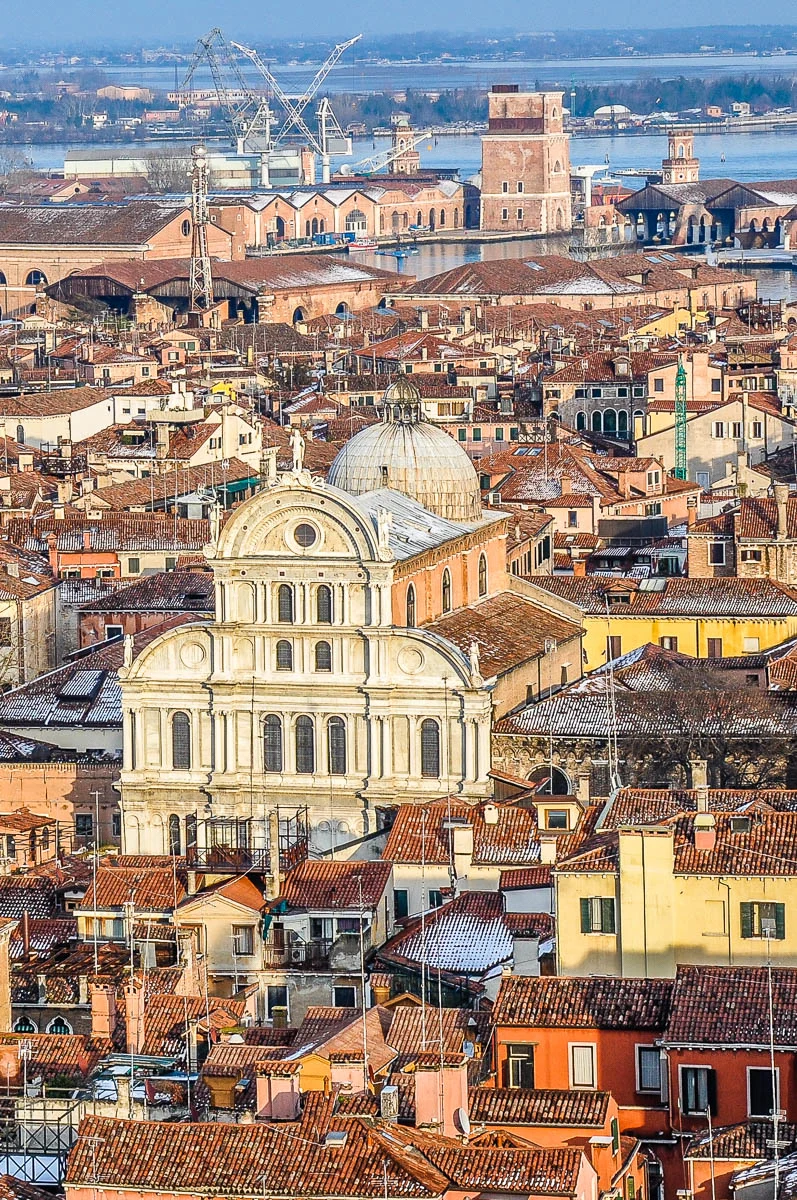
History, art, music, architecture…
Handmade items and unique shopping…
Stunning views…
All surrounded by water and with centuries-old traditions attached to it. Venice, certainly, is an exciting place.
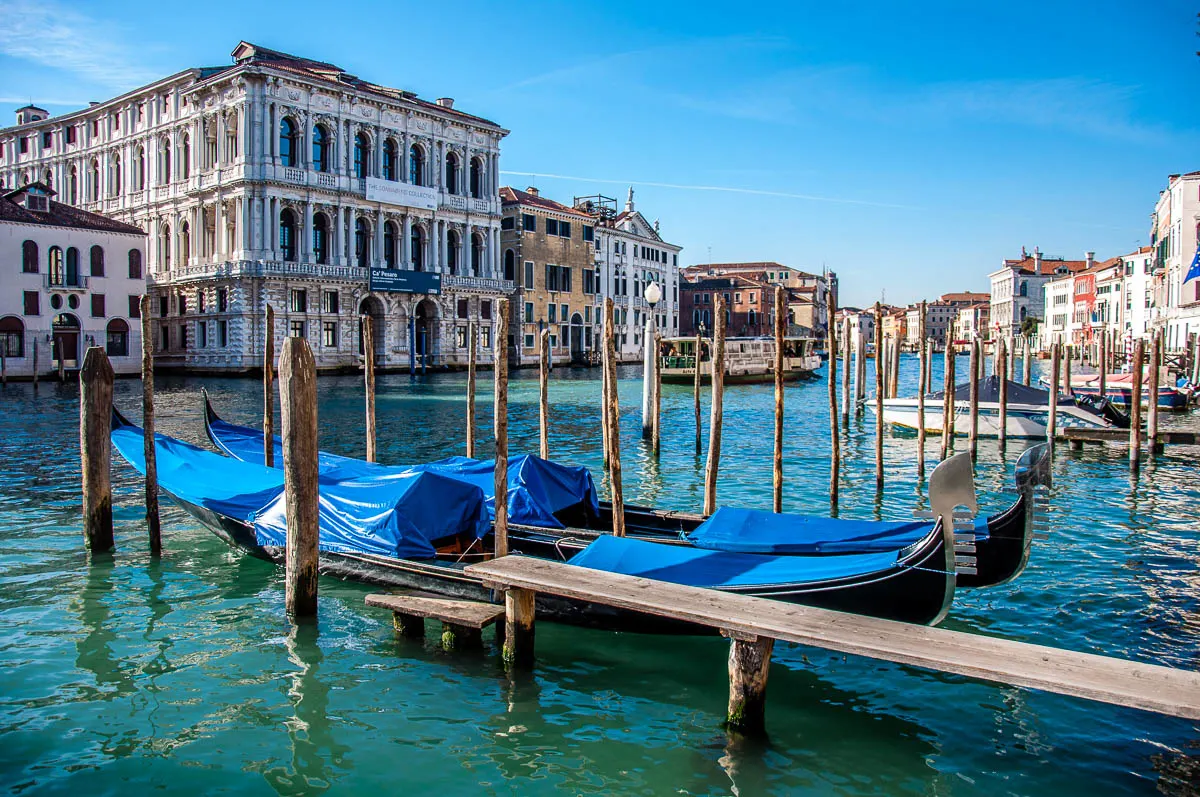
So, don’t fall into a rut when discovering this most unique city for yourself. Don’t tick off just the main sights to which millions of other people flock. Instead, focus on getting to know Venice’s hidden gems, lesser-known corners, and authentic experiences.
The above blog post provides you with a list of 101 things to do and see in Venice, Italy off the beaten track. Organised in groups and in alphabetical order, they will help you discover Venice at a deeper level so that your visit to the city on water helps you create lifelong memories.
More Helpful Links for Hidden Gems and Things to Do and See in Venice, Italy
- Venice, Italy – 15 Weird and Wonderful Types of Boats You Can Only See in La Serenissima
- Venice Historical Regatta
- Venice, Early Morning
- Teatro La Fenice in Venice, Italy – The Opera House with the Phoenix Factor
- Arco del Paradiso – Finding Paradise in the Sestiere of Castello, Venice
- Exploring Venice – Rialto Fish Market
- Exploring Venice – Moretta – The Mute Mask
- Exploring Venice – Arsenale’s Porta Magna and the Ships’ Pavillion
- Exploring Venice – The Natural History Museum
- Exploring Venice – Gallerie dell’Accademia
- Exploring Venice – The Museum of Music
- Five Things You Can Do for Free in Venice
- Photographing the Carnival in Venice
- Sport, History, and Men in Leotards
- Gondolas and the Island of San Giorgio Maggiore in Venice, Italy
- 11 of the Best Day Trips from Venice (With Lots of Photos, Travel Times and Italy Train Tips)
- Italian Piazzas – 20 Most Beautiful Squares in the Veneto, Northern Italy
- Point 7 – Italy from Above – Where to Get a Bird’s-Eye View of Italy’s Northern Cities
- Video of Squero di San Trovaso – the only gondola-making workshop left in Venice
- Video of the art in Fondazione Querini Stampalia – a must-visit place in Venice
- Video of the artichoke trimmer at Rialto fruit and veg market
- Video of the most stunning room in Palazzo Grimani – an off-the-beaten-track palace museum in Venice
- Video fo St. Mark’s Square in Venice with the large stage of the Venetian Carnival
- Video of Rialto Fish Market
- Video of Venetian gondolas with the island of San Giorgio Maggiore at the back
- Video of the Ships’ Pavillion in Venice
- Video of the opening parade of the Historical Regatta in Venice
- Video of the Grand Canal as seen from the Accademia Bridge
Thank you for reading! Please, leave me a comment, pin the image below or use the buttons right at the top and at the end of this blog post to share it on social media.
For more useful information like this, please, like my blog’s page on Facebook and subscribe to my strictly no-spam newsletter.
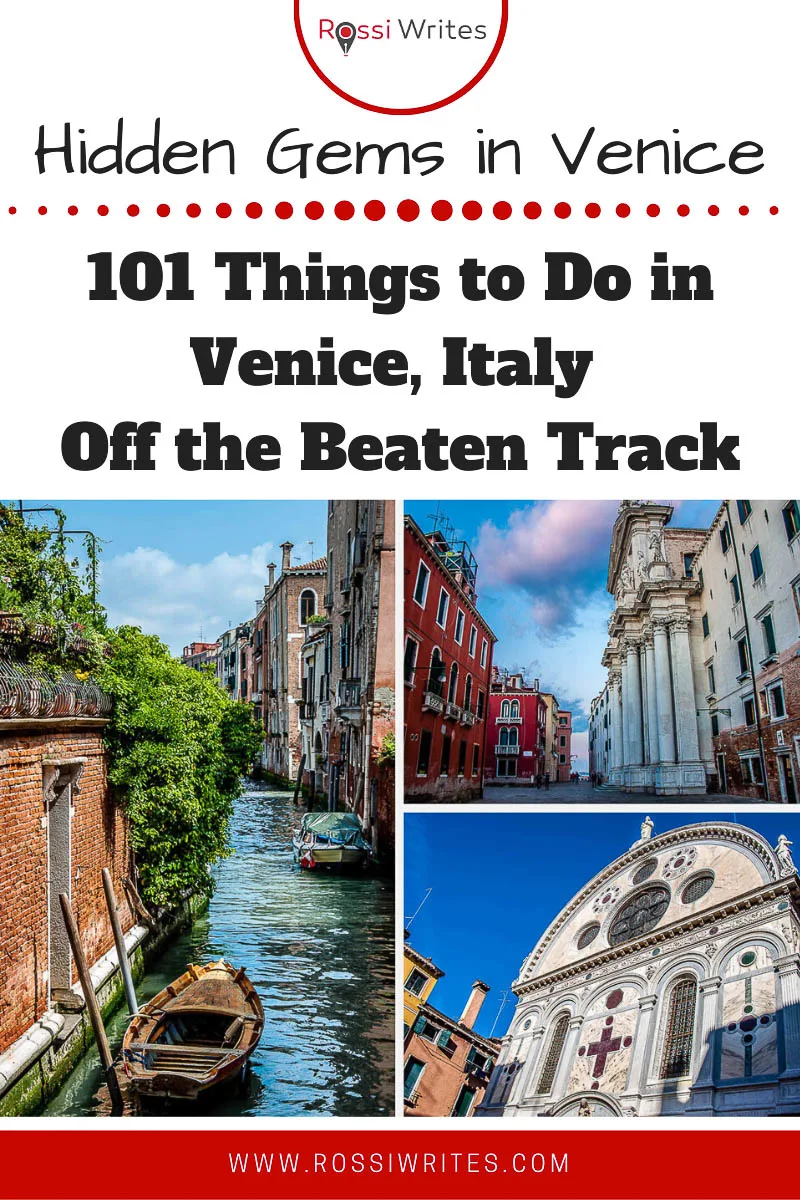

Greg
Wednesday 11th of January 2023
Hi Rossi, loved the guide, found a few handy tips for sure! Just a heads up, your link to the rooftop terrace at Fondaco dei Turchi no longer works; it should now point to https://www.dfs.com/en/venice/service/rooftop-terrace. Otherwise, fantastic work, thank you!
admin
Thursday 12th of January 2023
Thank you, Greg! This whole blog post is due for an update. I am hoping to be able to get to it as soon as possible. Thank you again for your kind words and Have a lovely day!
Rossi Thomson
Christine Witton
Monday 30th of May 2022
I hve visited Venice a few times, but your indepth review of the curiosities and hidden places has added to my next visit. Thank you so much.
admin
Wednesday 1st of June 2022
Thank you for your kind words! Venice has so much to offer. I keep discovering new things about this fascinating city every day. Best wishes,
Rossi :)
Christine Witton
Saturday 2nd of October 2021
Hi Rossi. I have been to Italy six times and to Venice on three occasions. I read travel blogs and books but I have often found that they regurgitate the same information. Your article was a delight to read and even though I knew some of the things you spoke about, it was nevertheless very interesting. Thank you so much. I have signed up for your newsletter and look forward to receiving it so that I can plan further adventures in Europe when COVID allows us to leave Australia.
admin
Sunday 3rd of October 2021
Dear Christine,
Thank you for your kind words! I really appreciate your stopping by my blog and signing up for my newsletter. Have a lovely day and I hope that soon travel will be easy, smooth, and enjoyable again.
Best wishes,
Rossi :)
Димитричка Игнатова
Thursday 23rd of April 2020
Здравей Роси, много интересна разходка из Венеция си направих. Благодаря ти. Надявам се по скоро да оздравеем всички и да може. отново да посещаваш красиви и интересни места в Италия. А ние да четем за тях.
admin
Friday 24th of April 2020
Благодаря, мамо. Дано да стане така! Поздрави от нас,
Роси